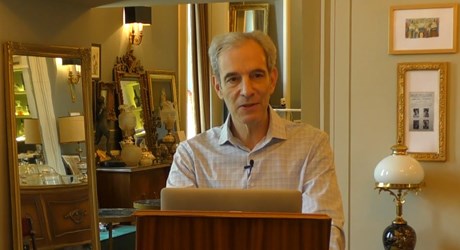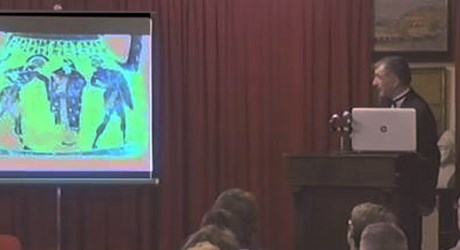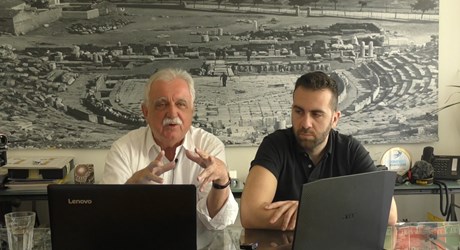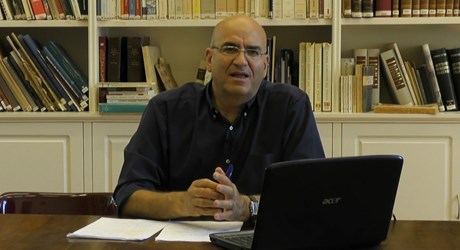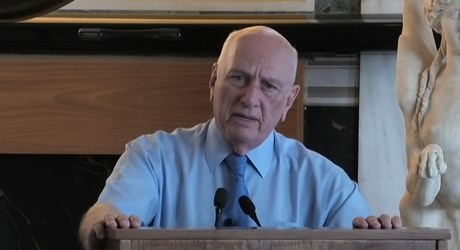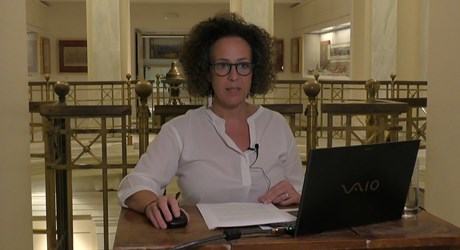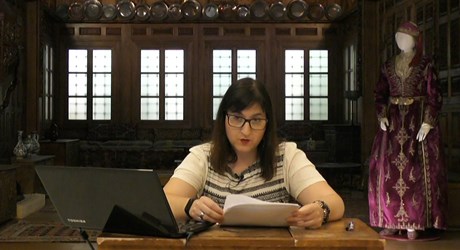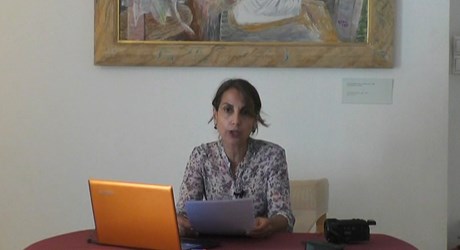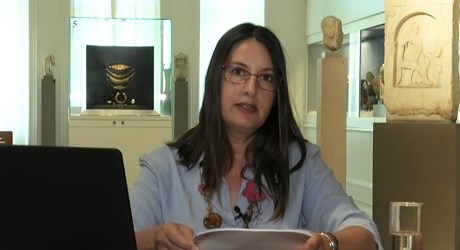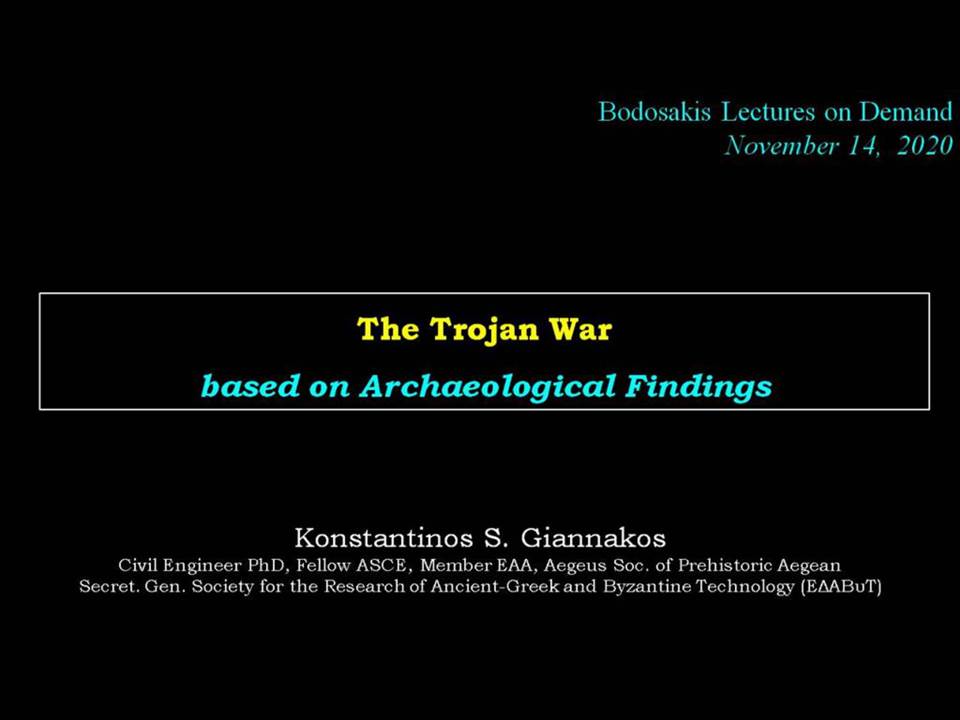
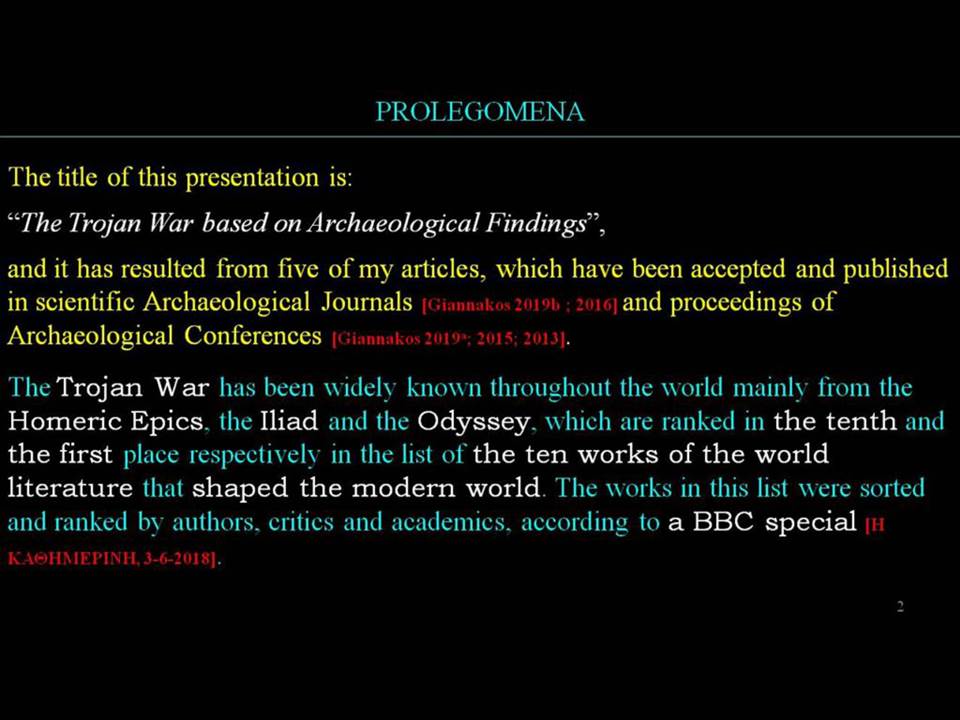
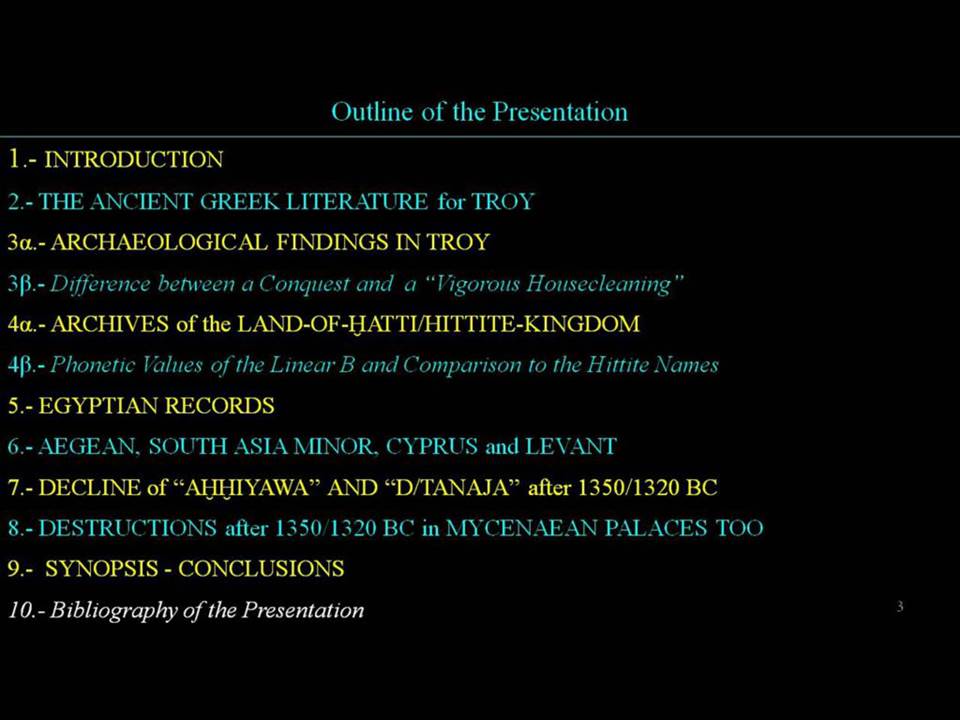
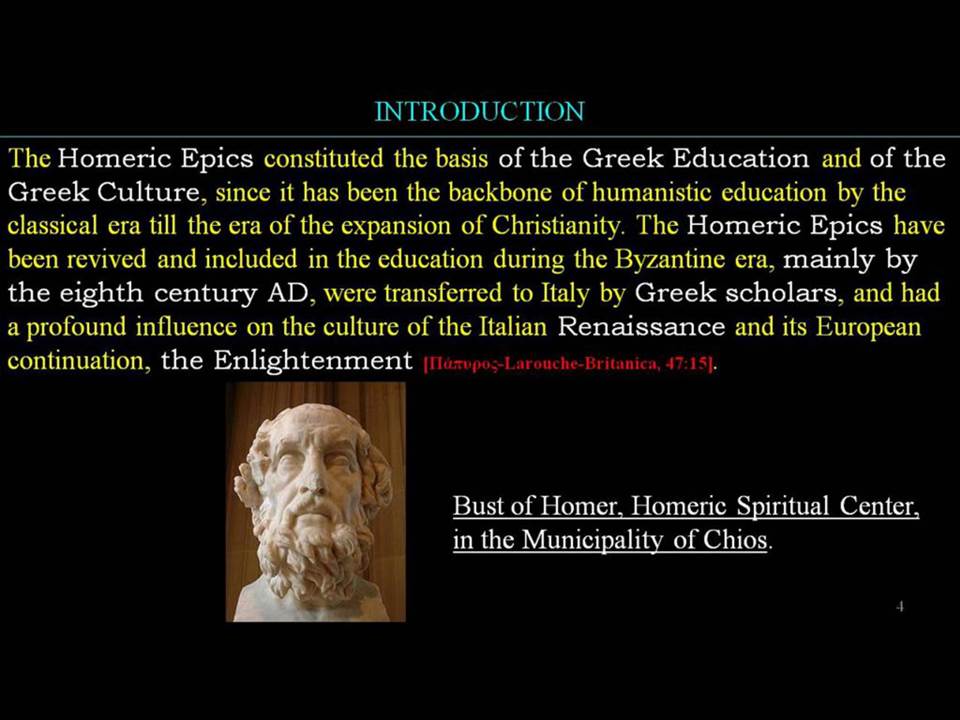
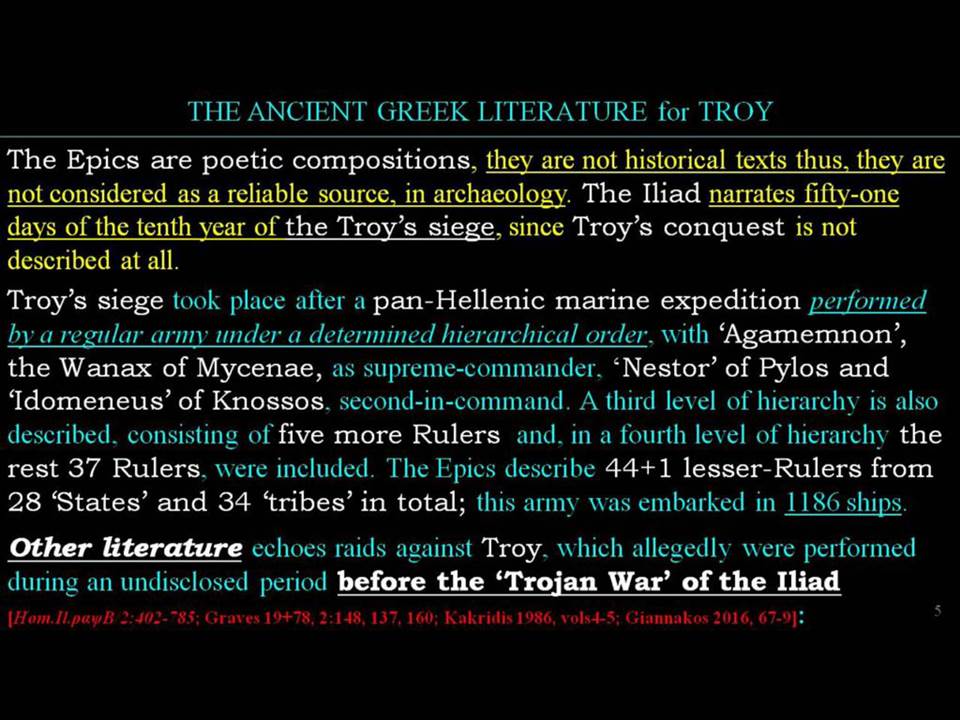
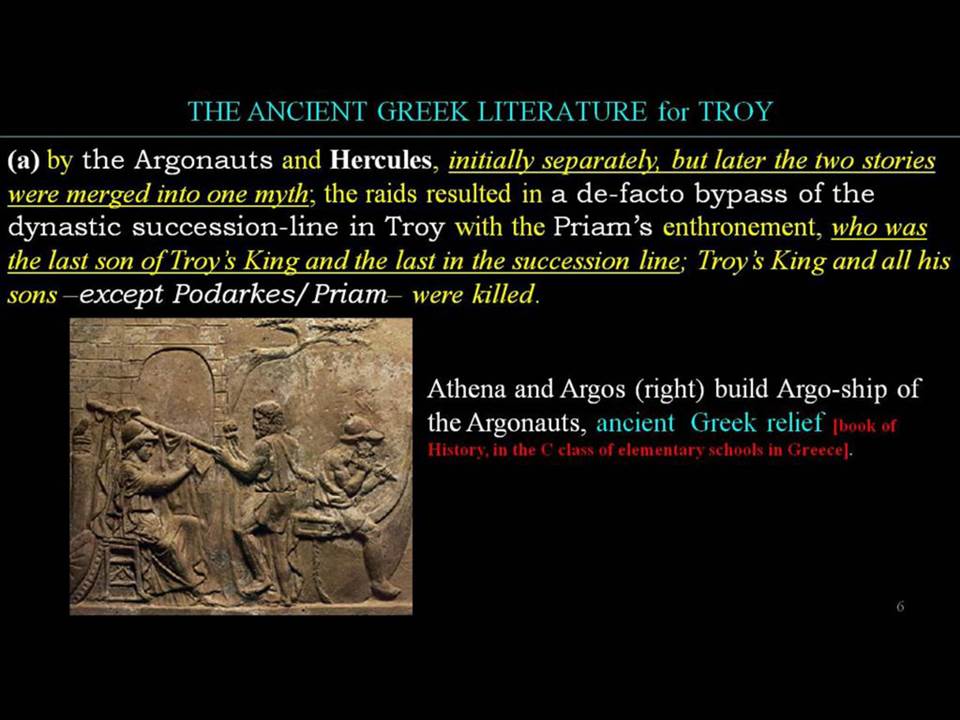
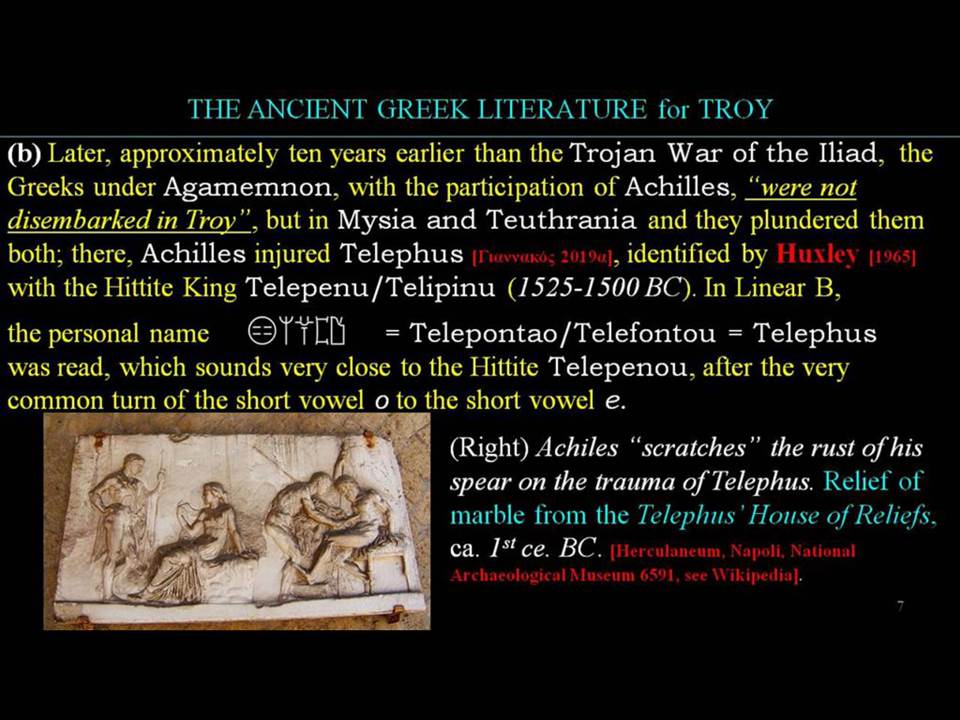
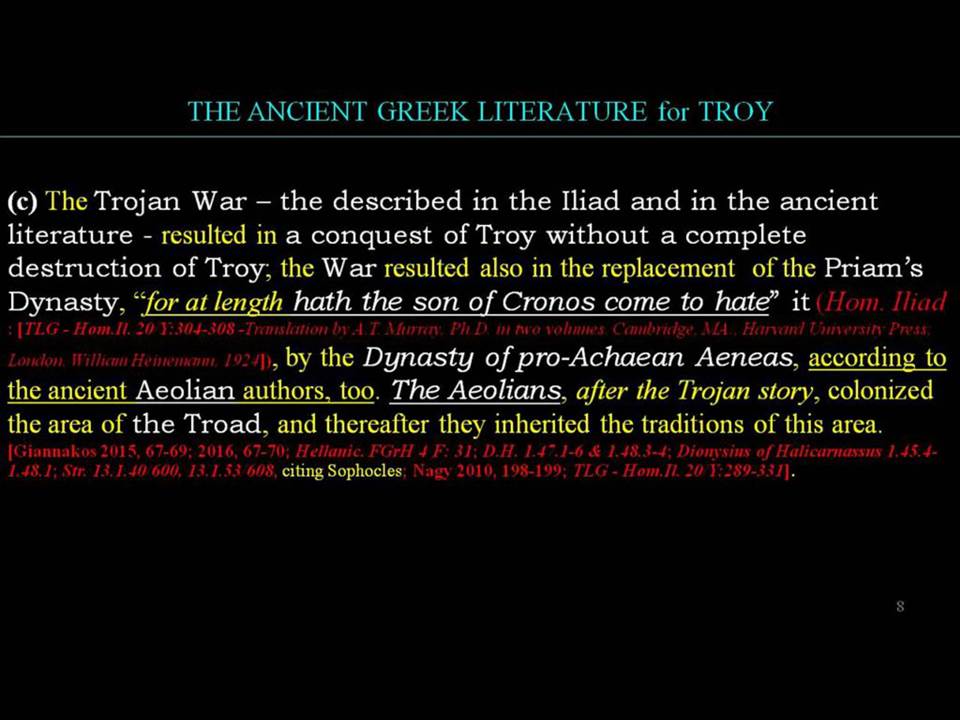
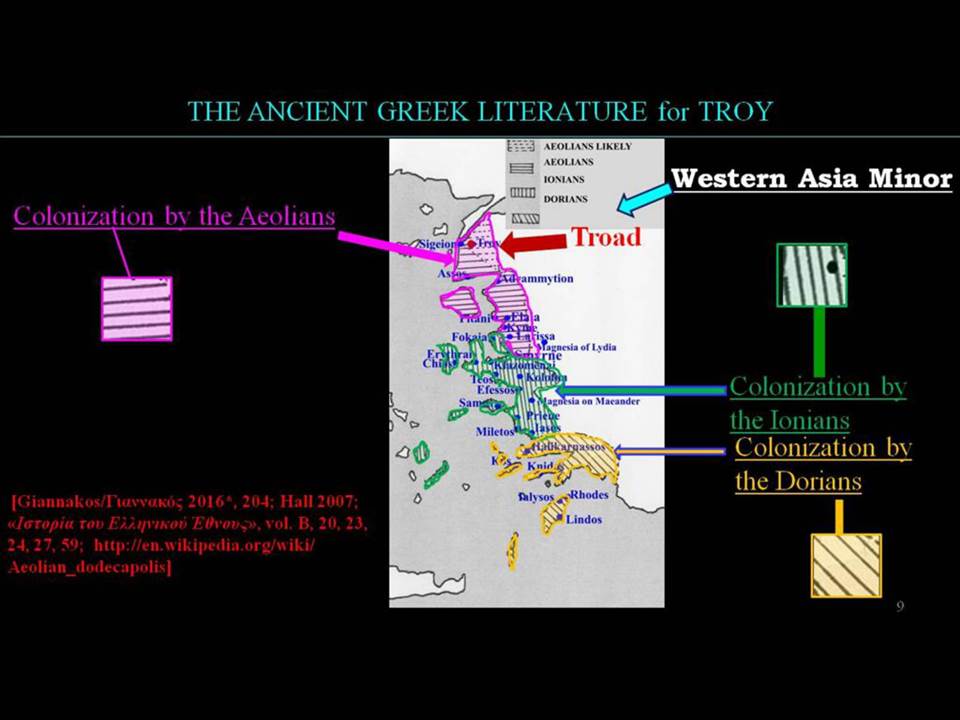
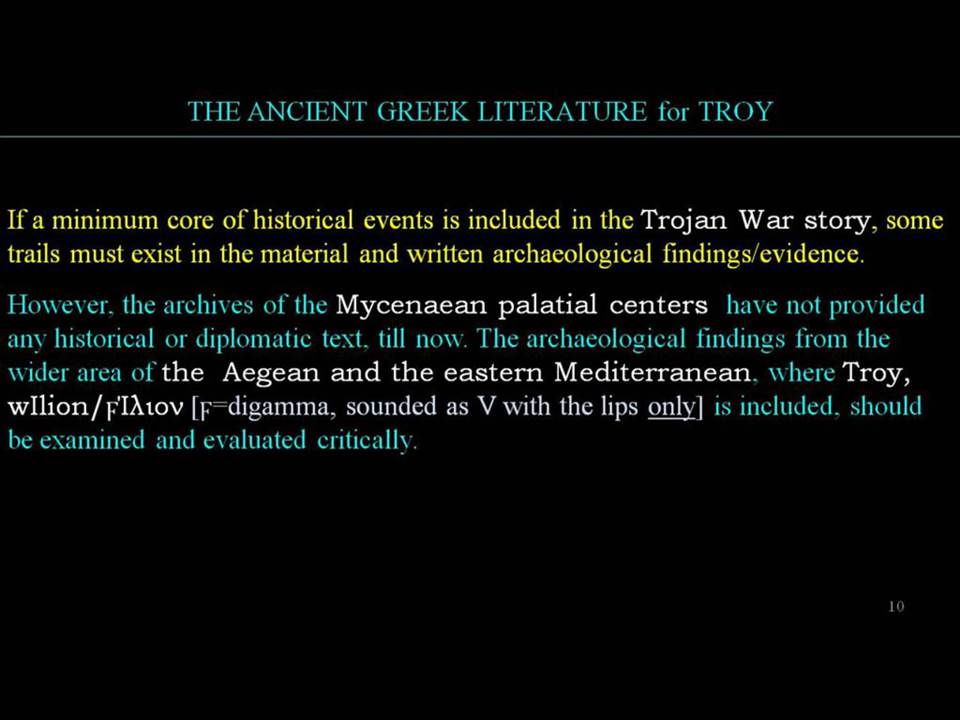
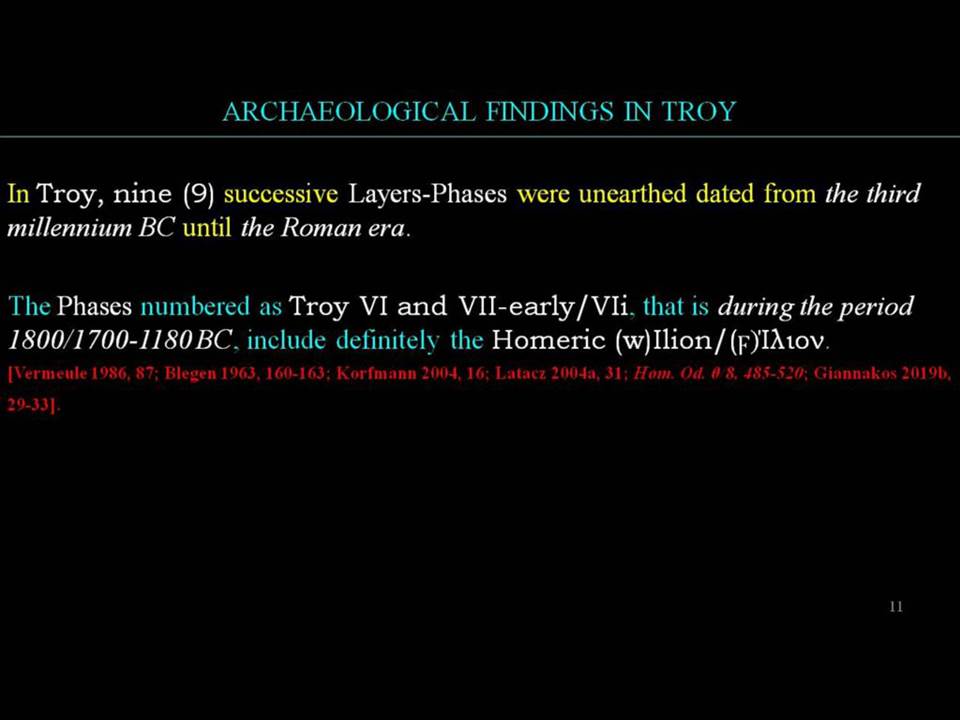
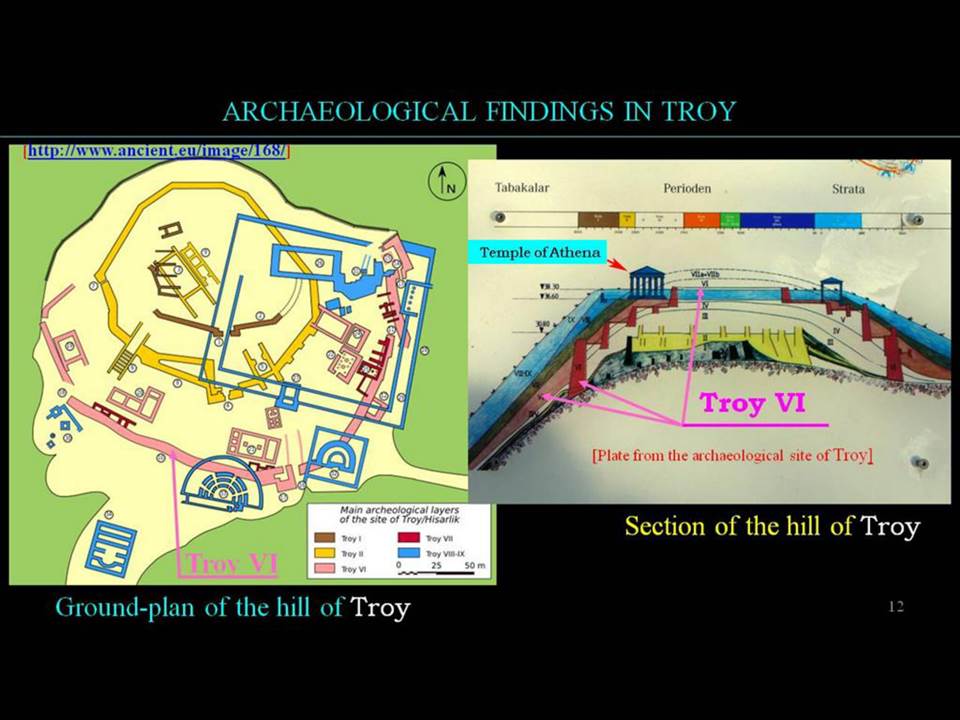
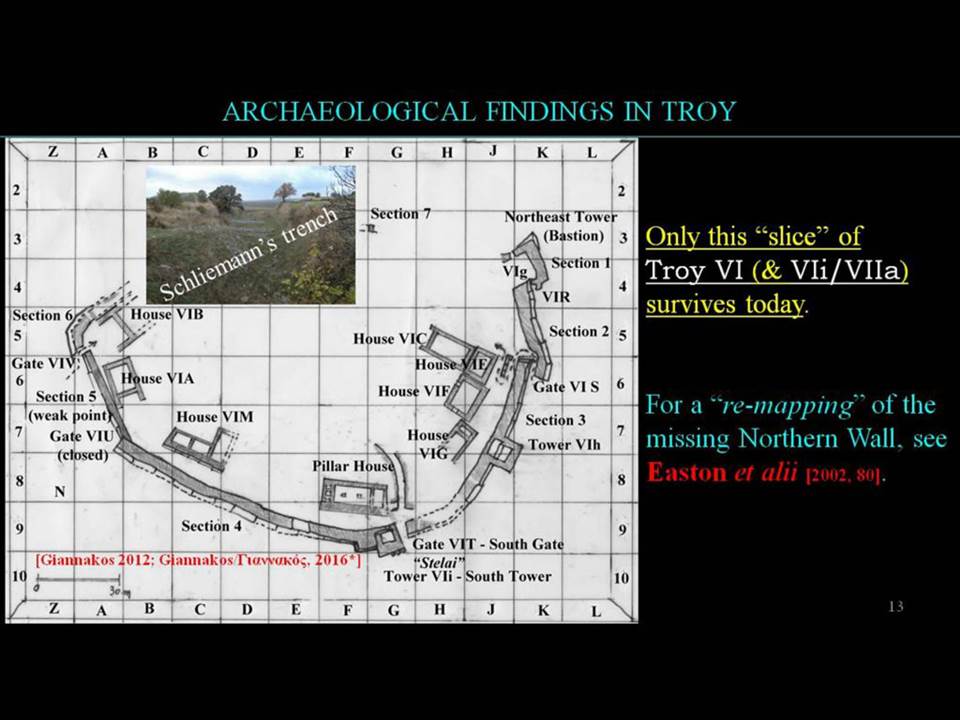
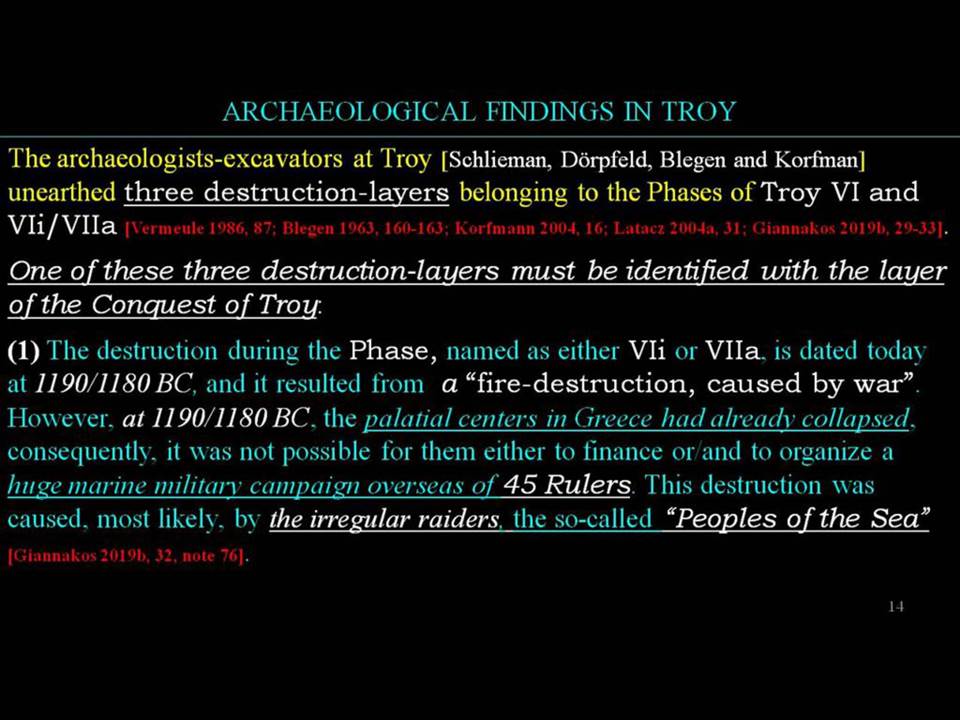
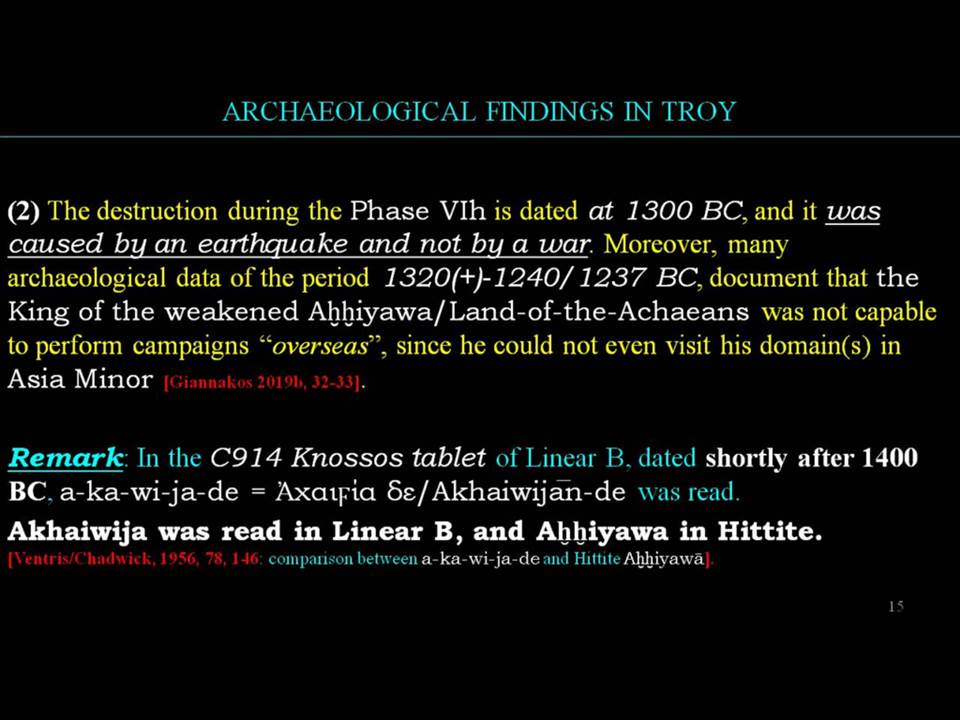
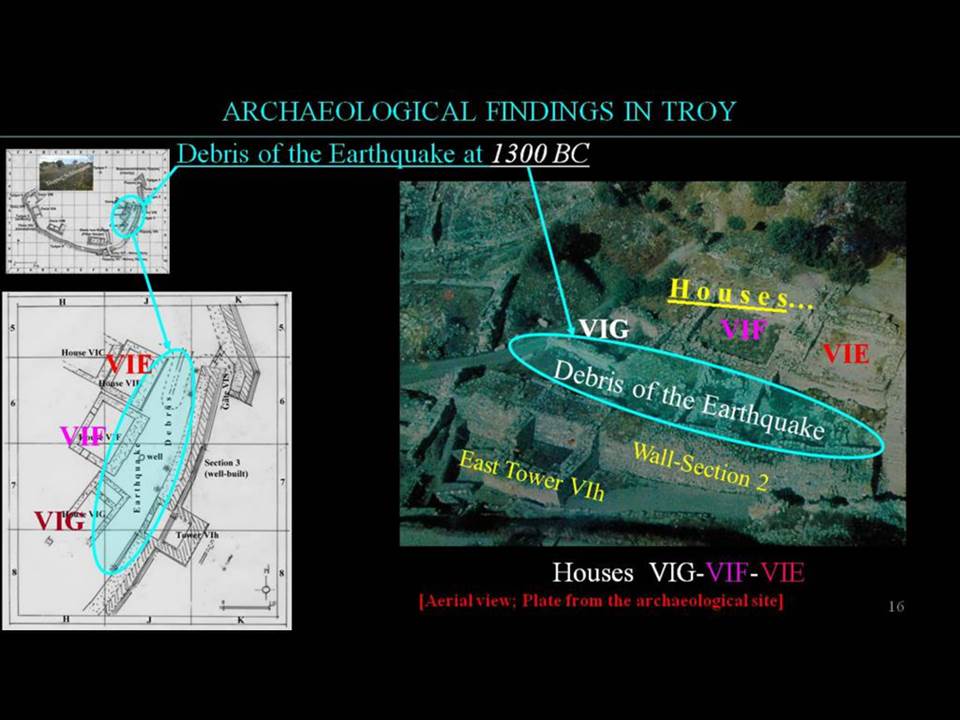
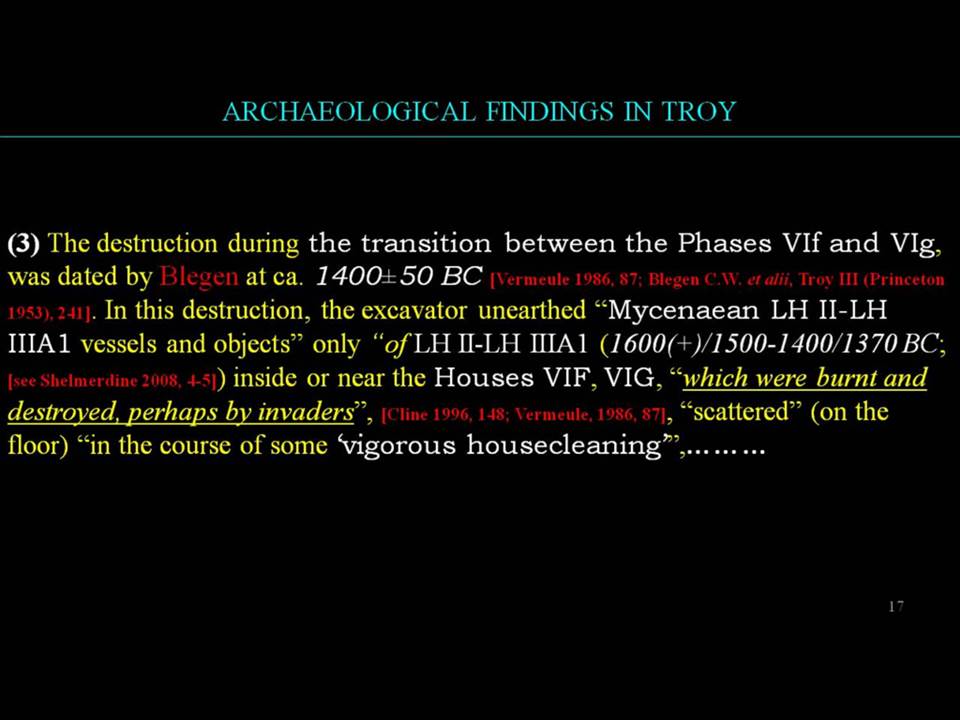
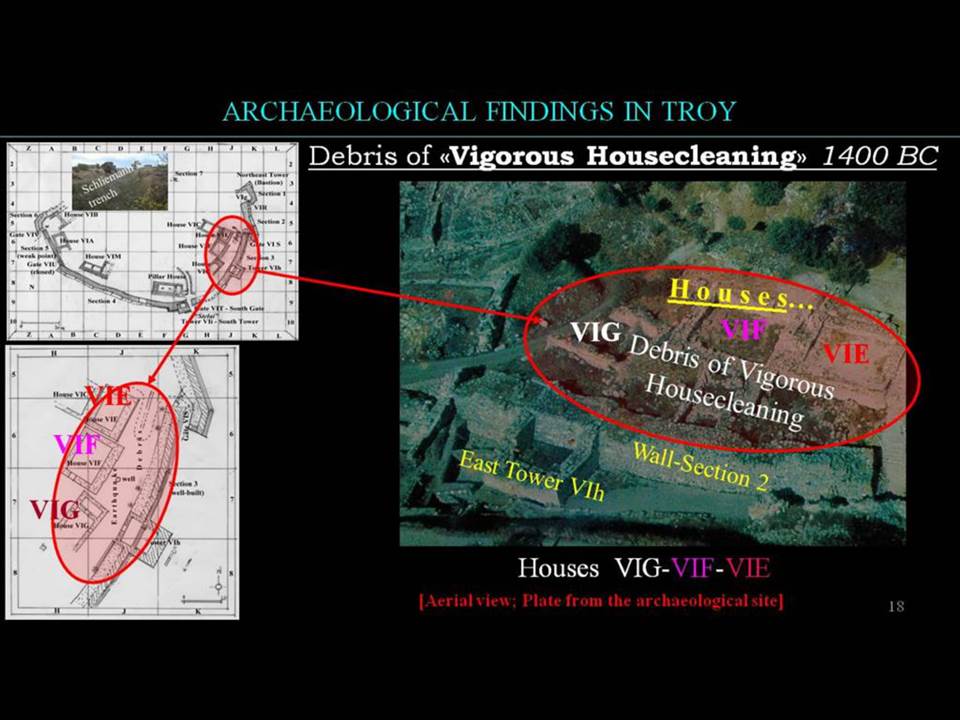
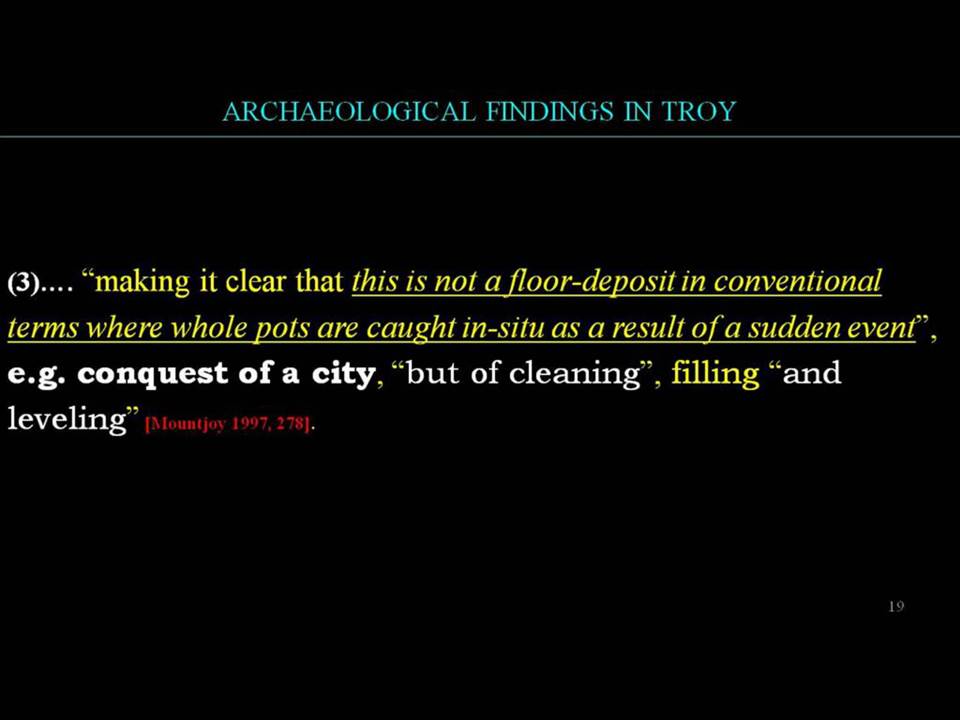
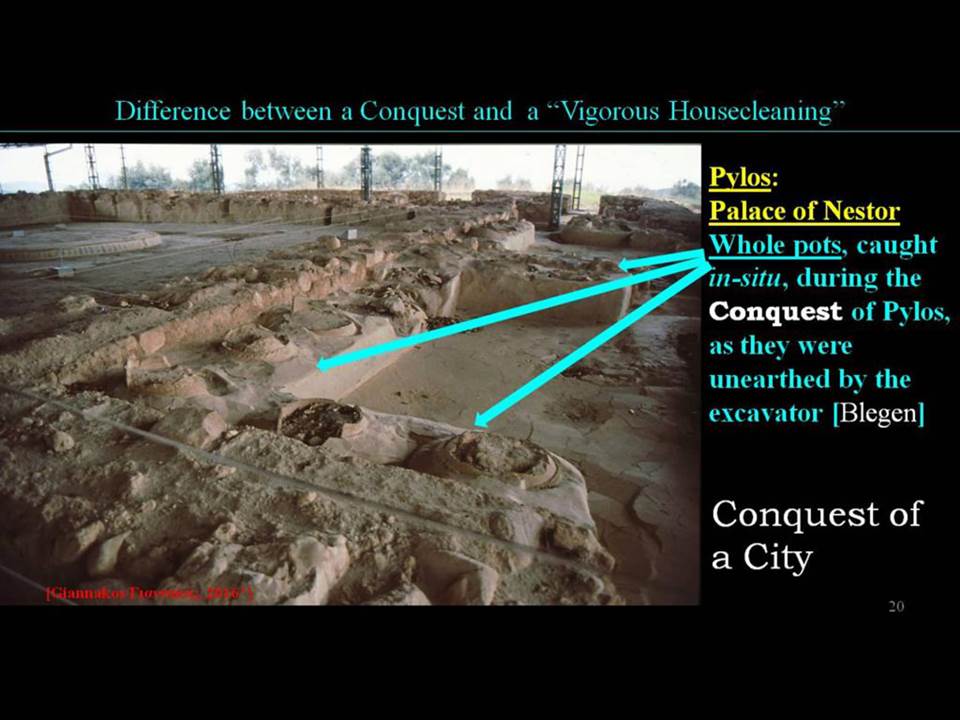
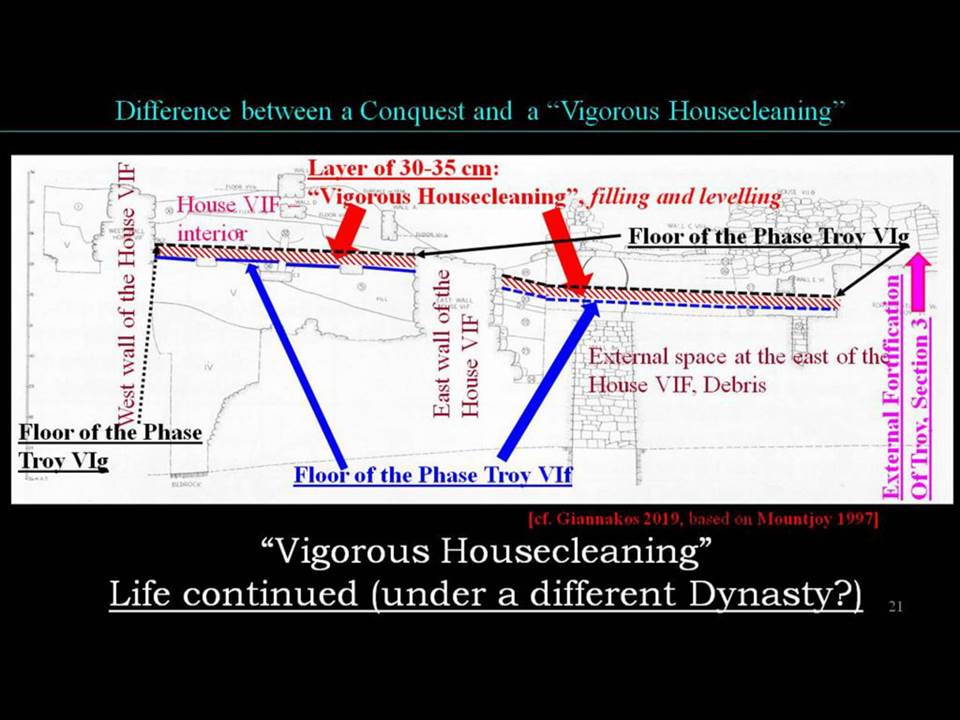
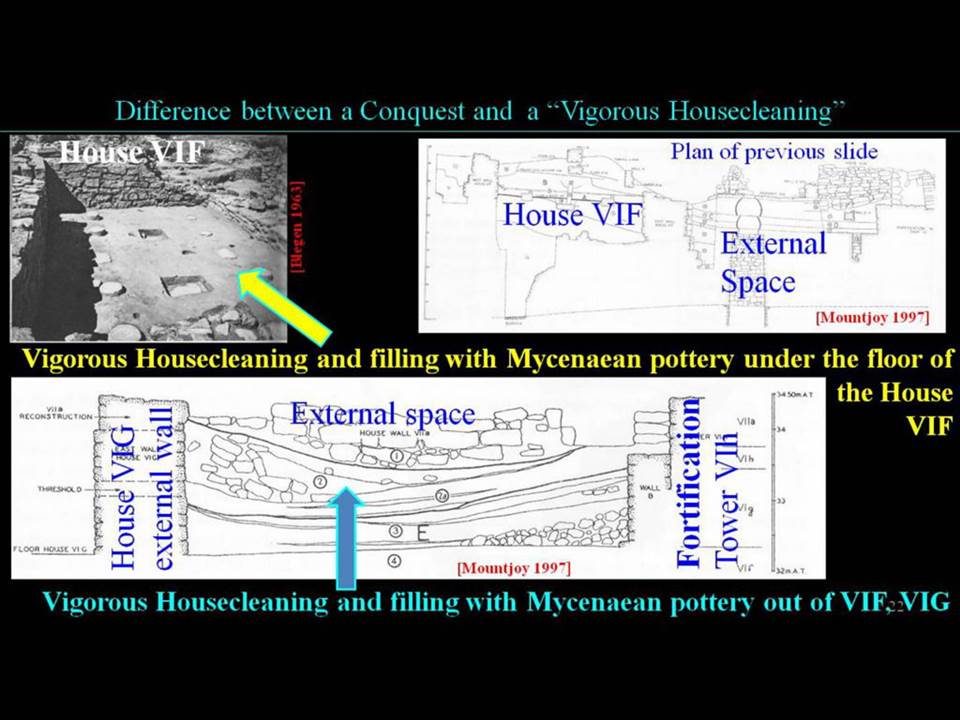
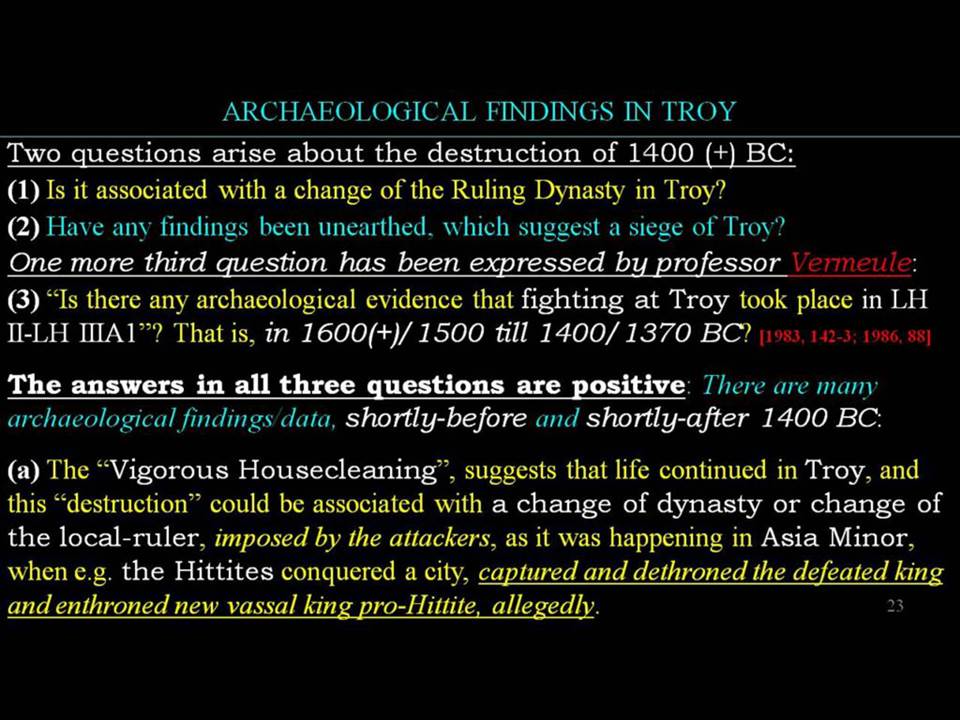
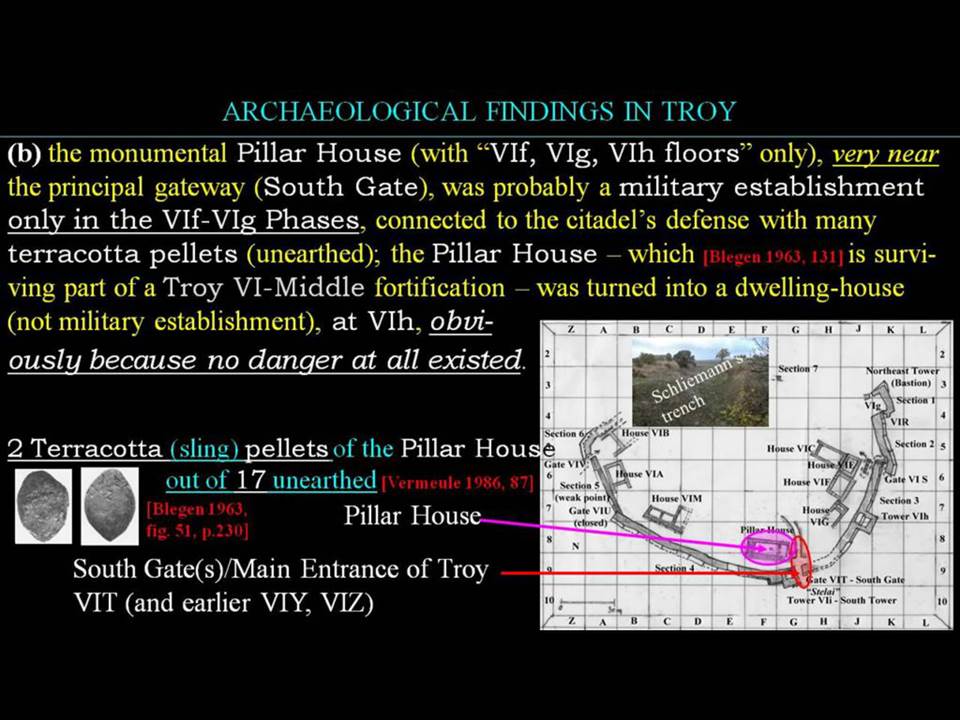
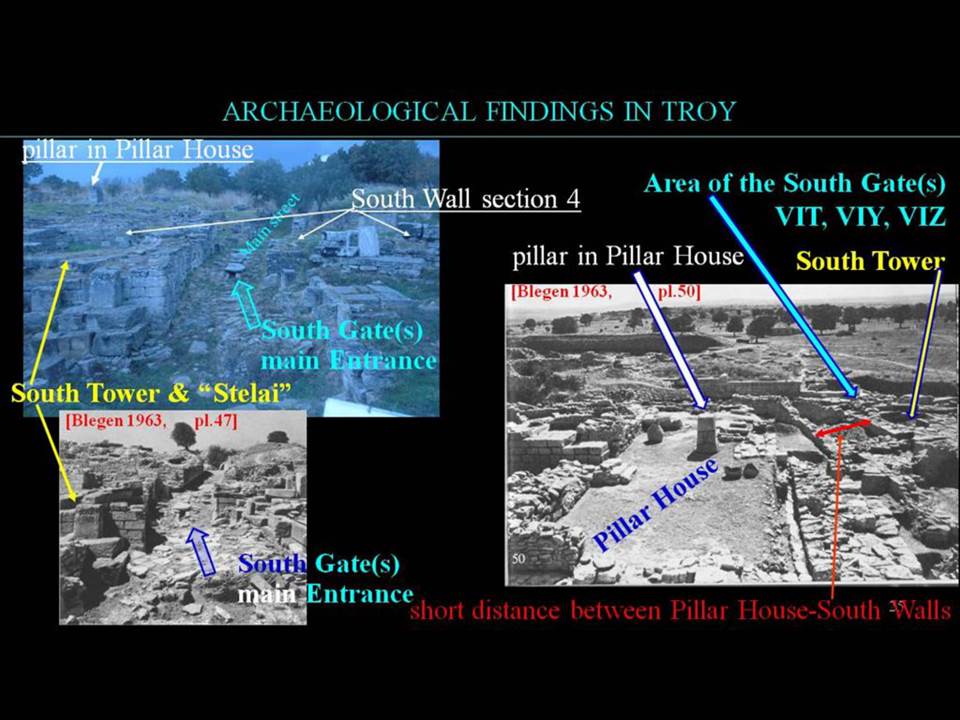
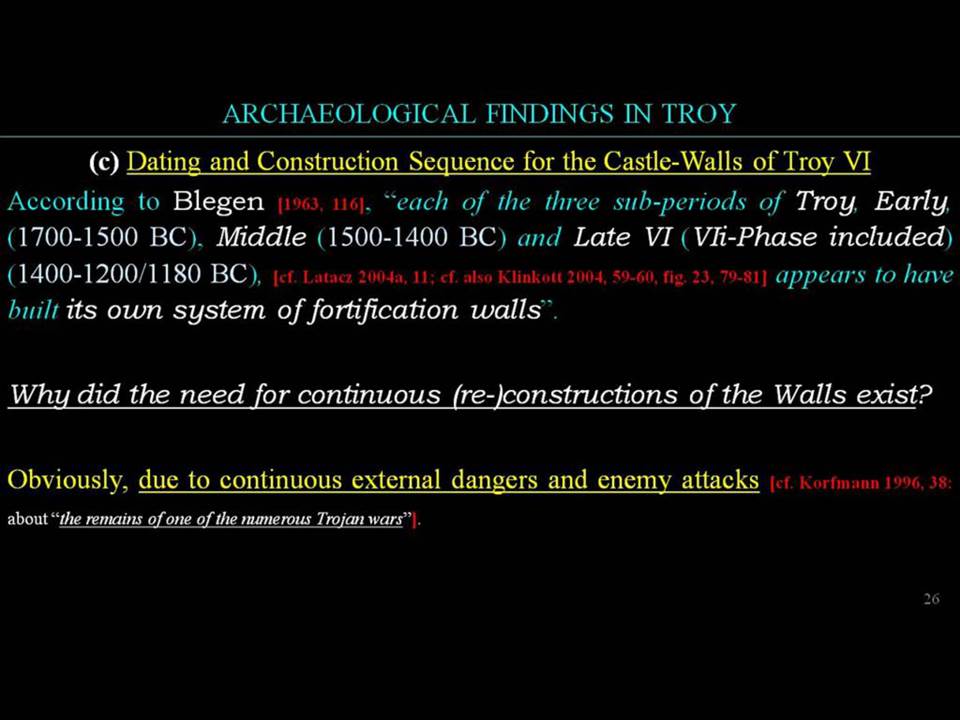
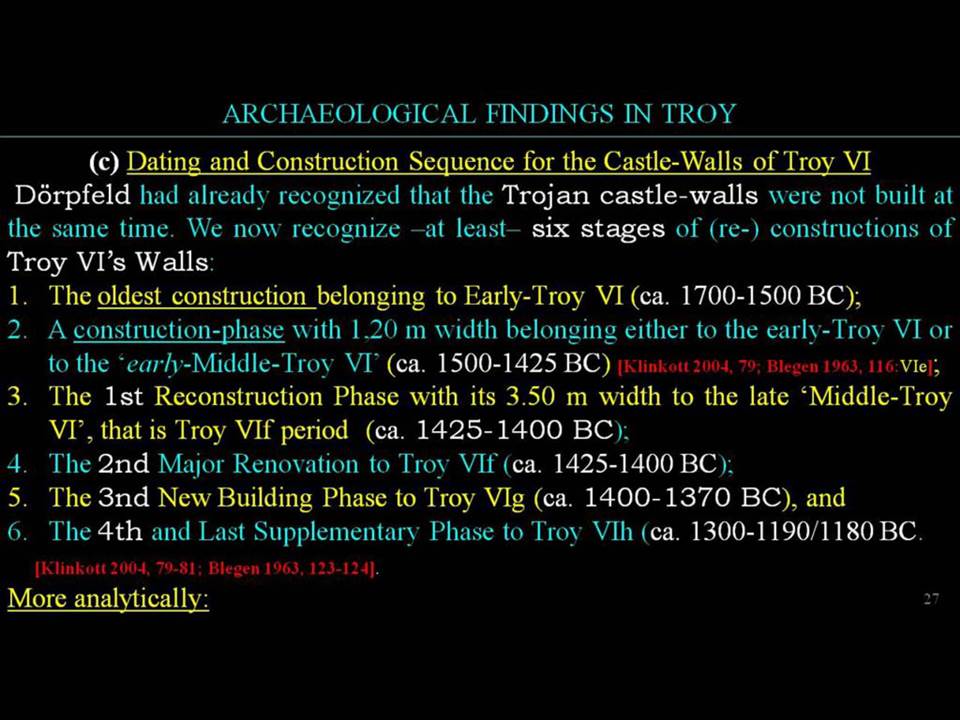
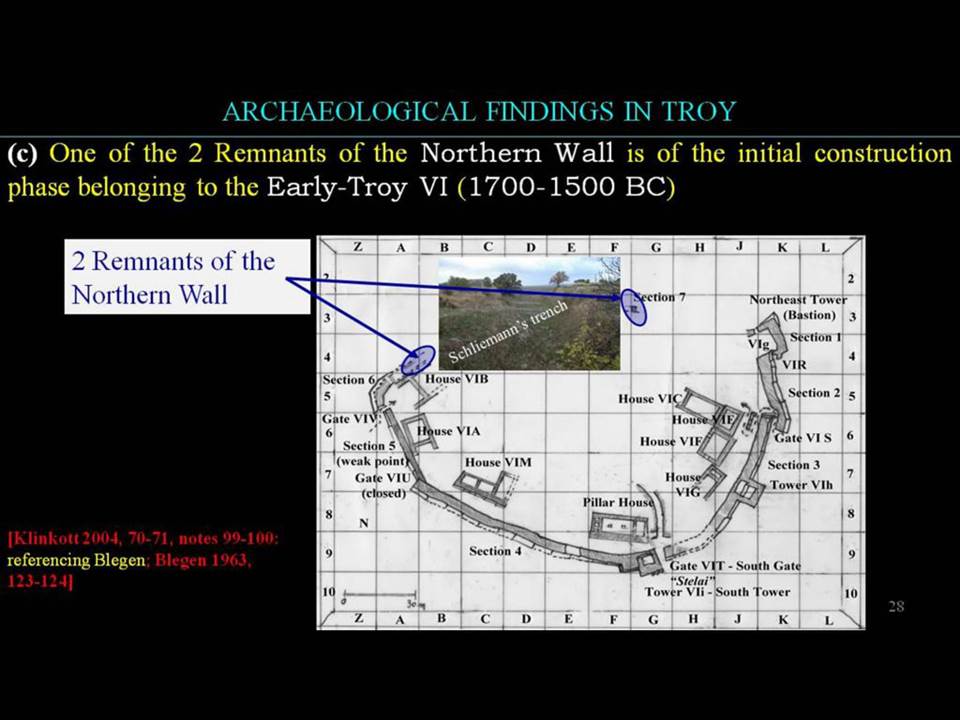
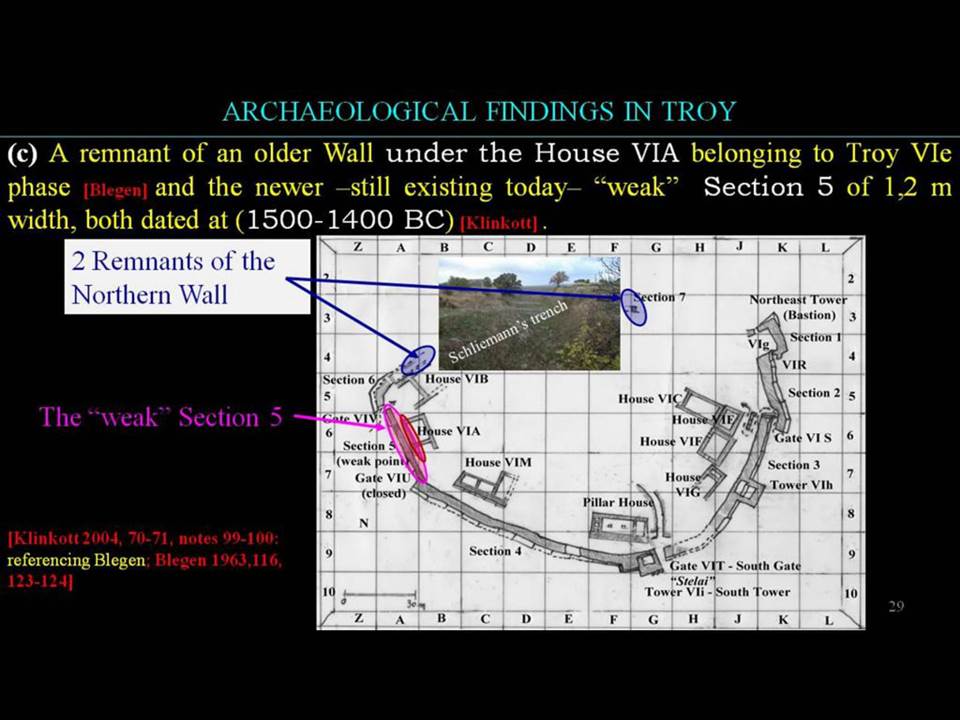
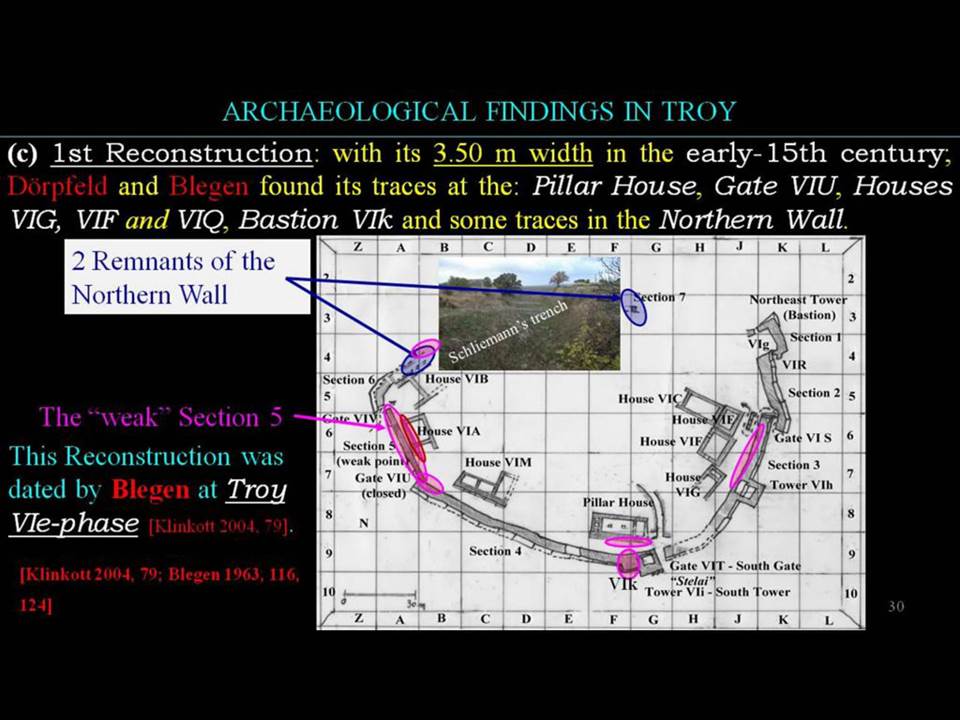
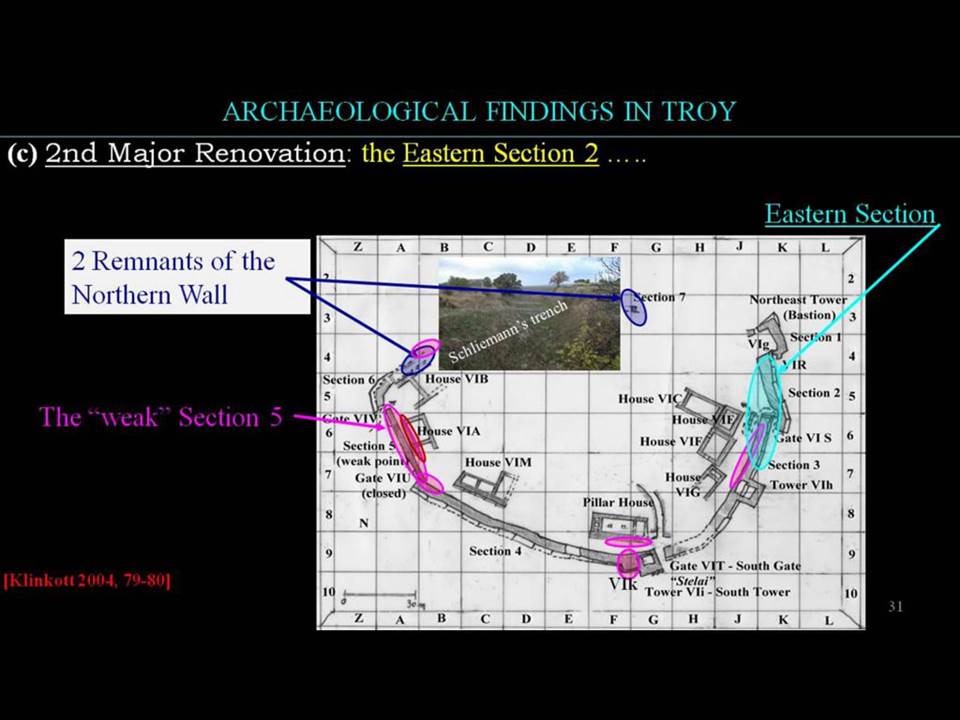
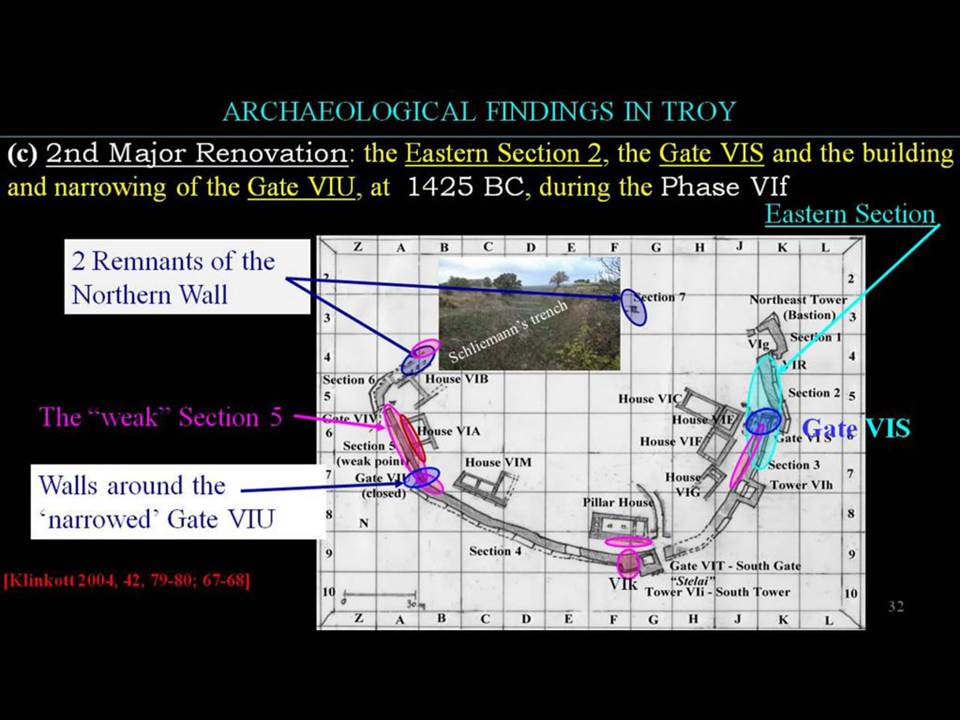
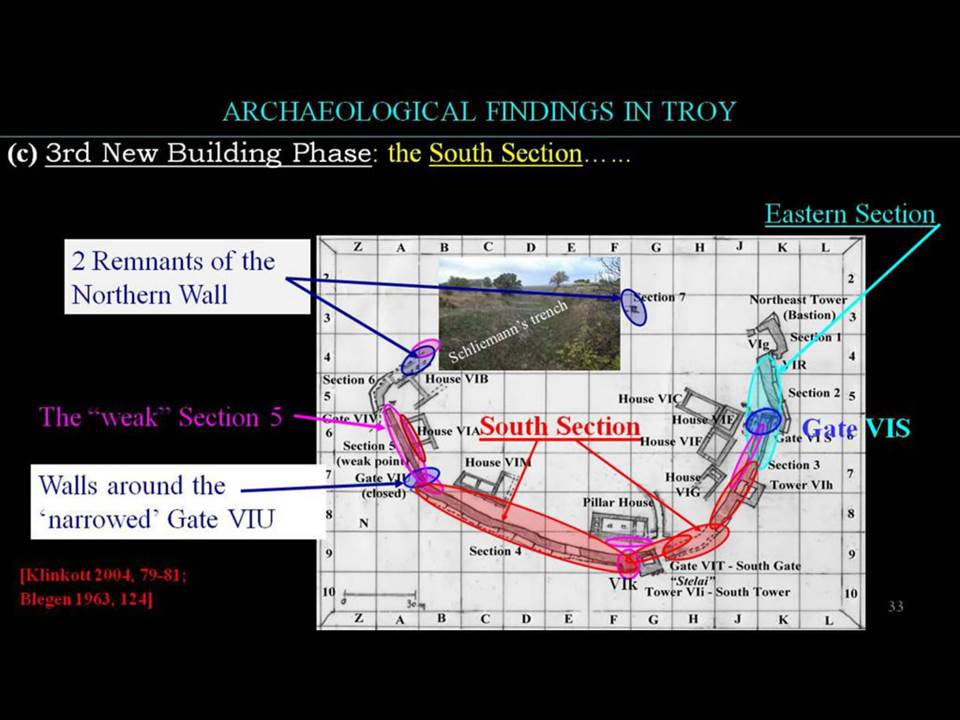
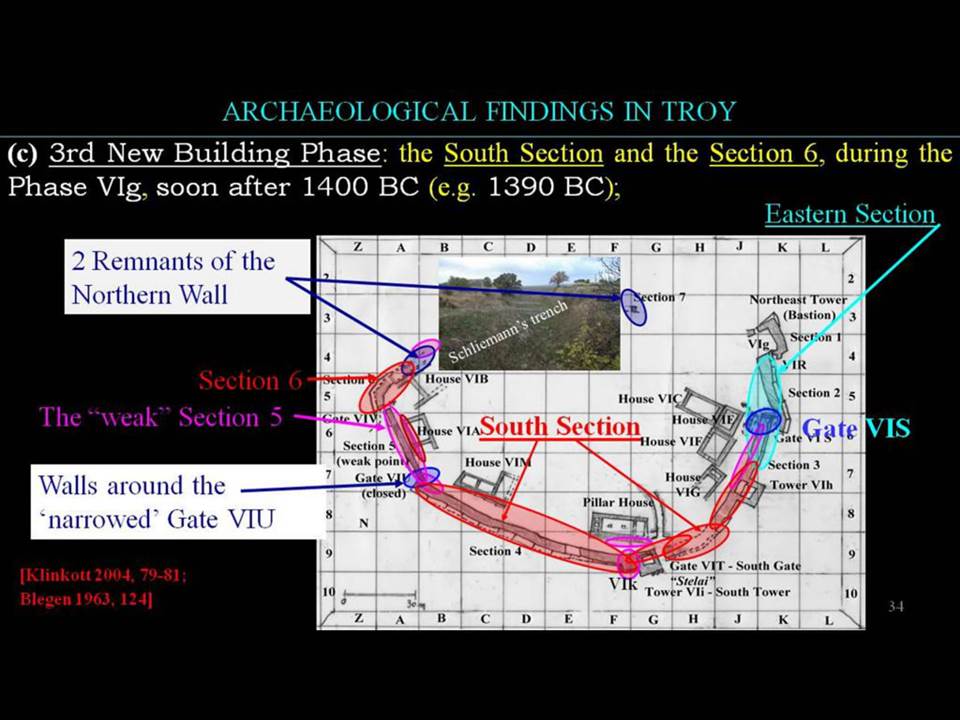
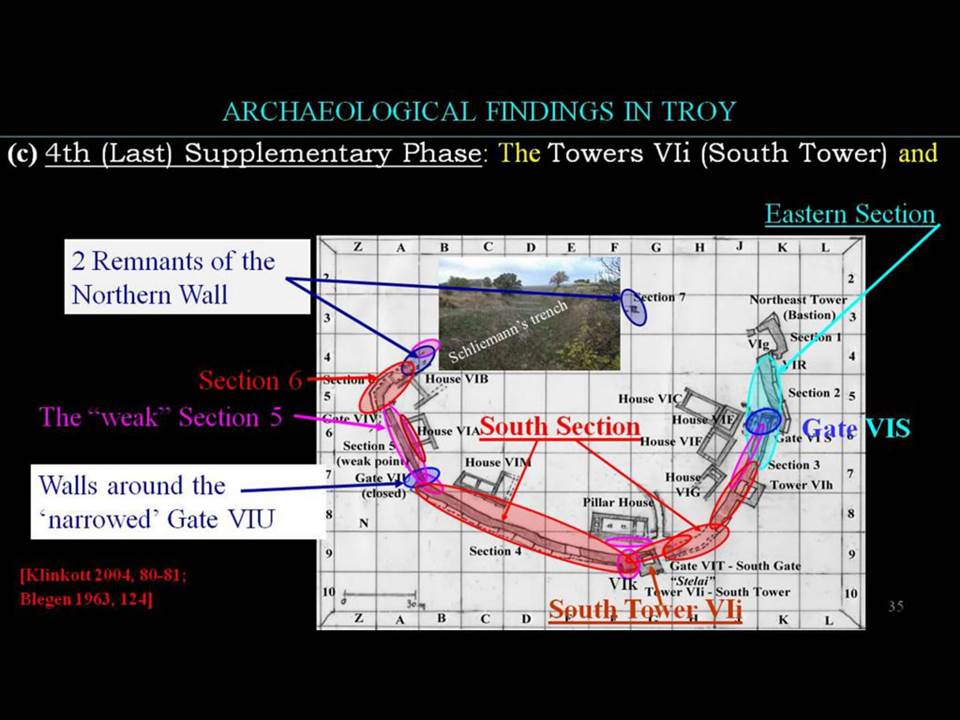
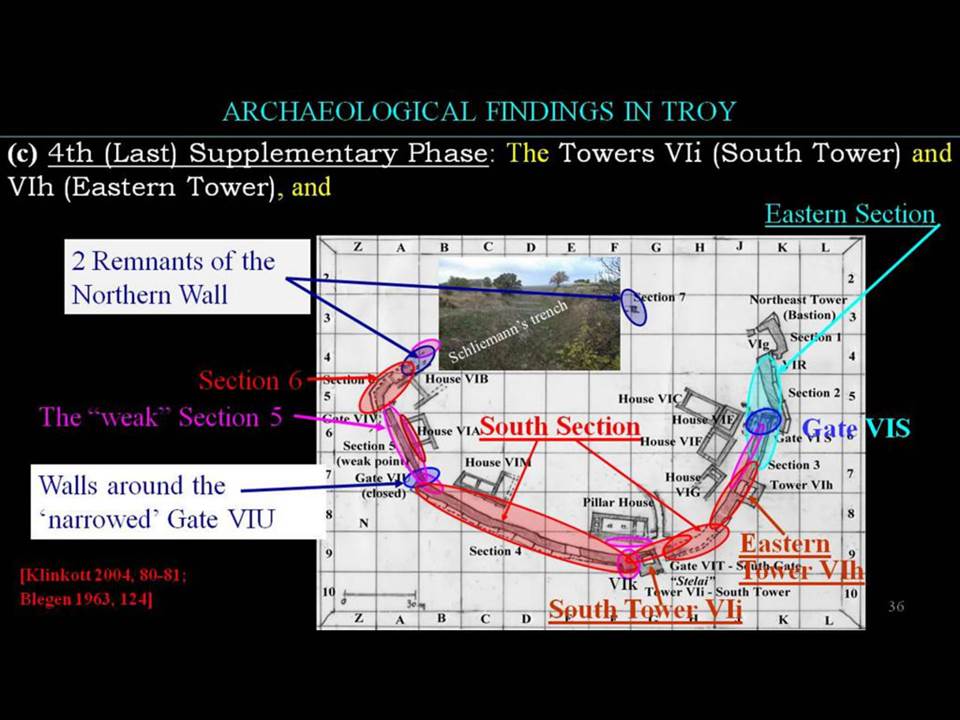
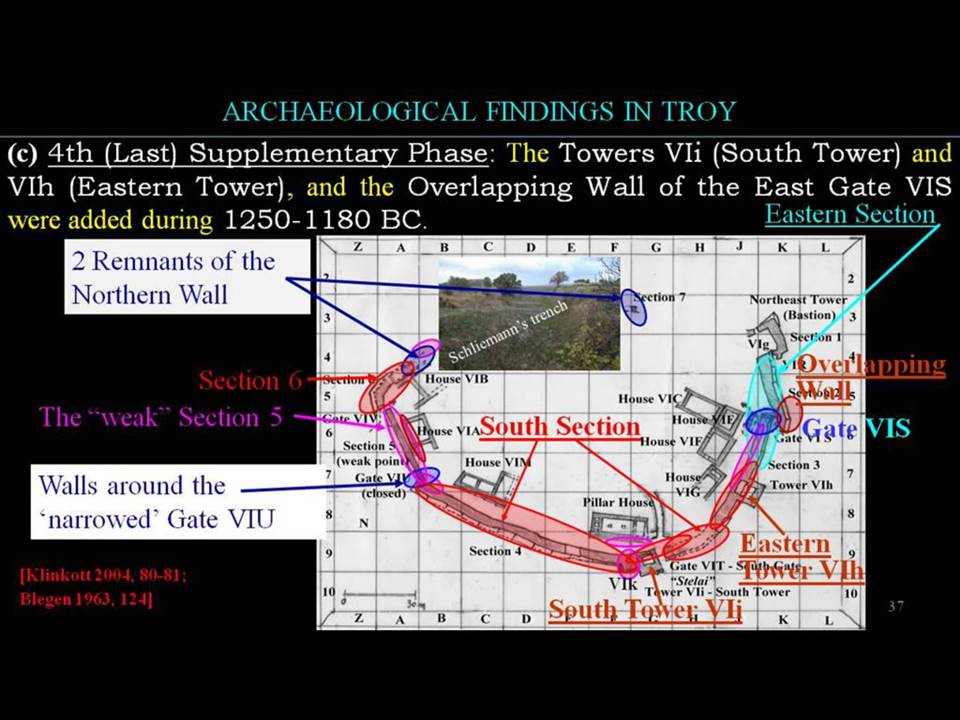
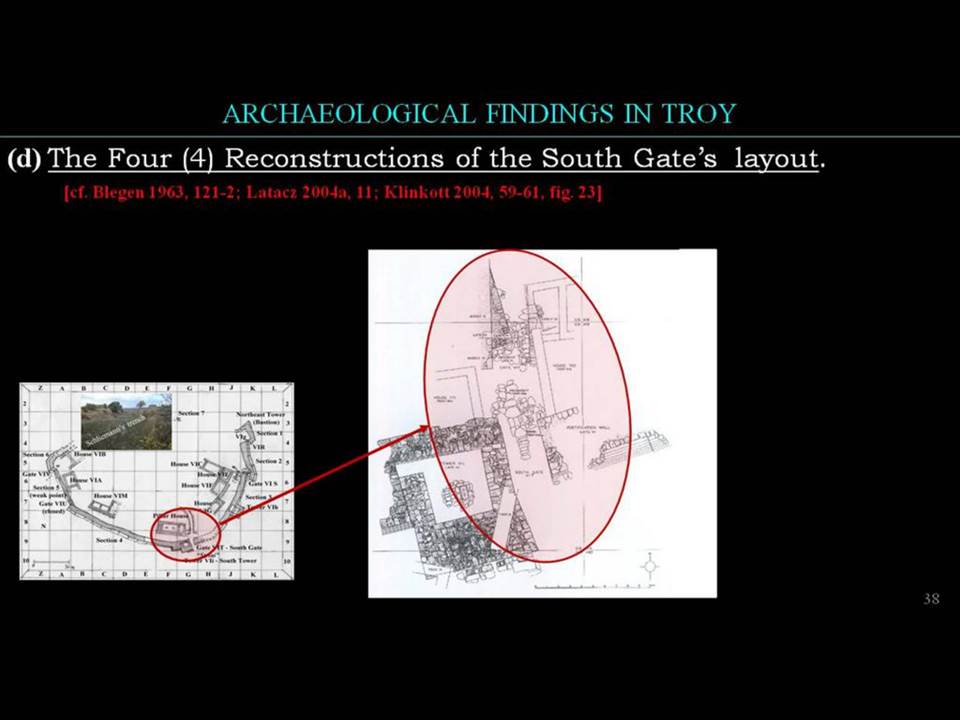
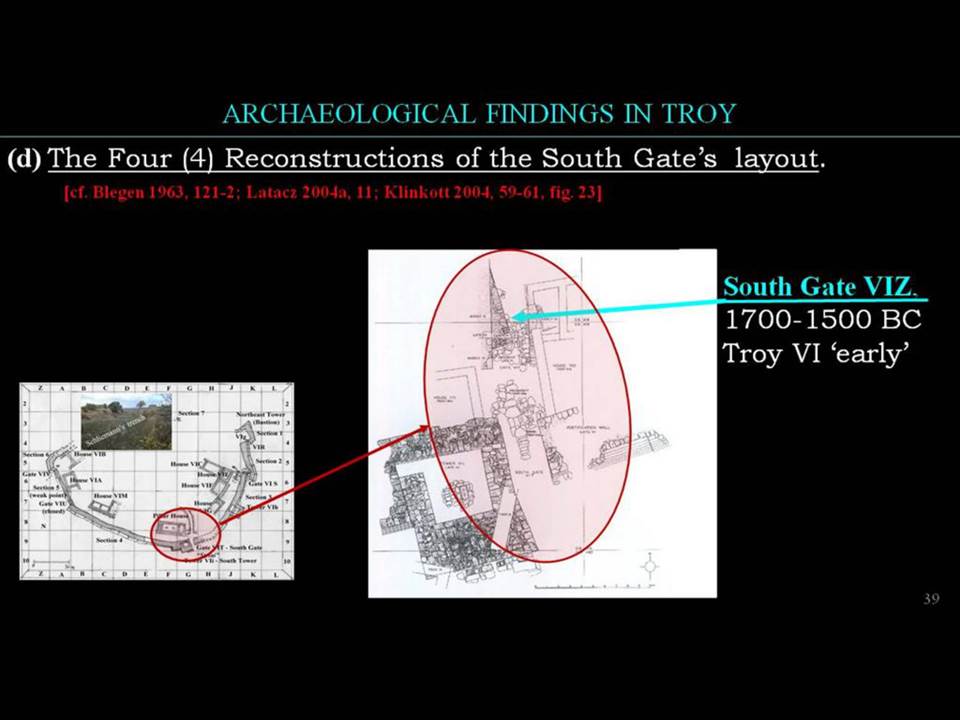
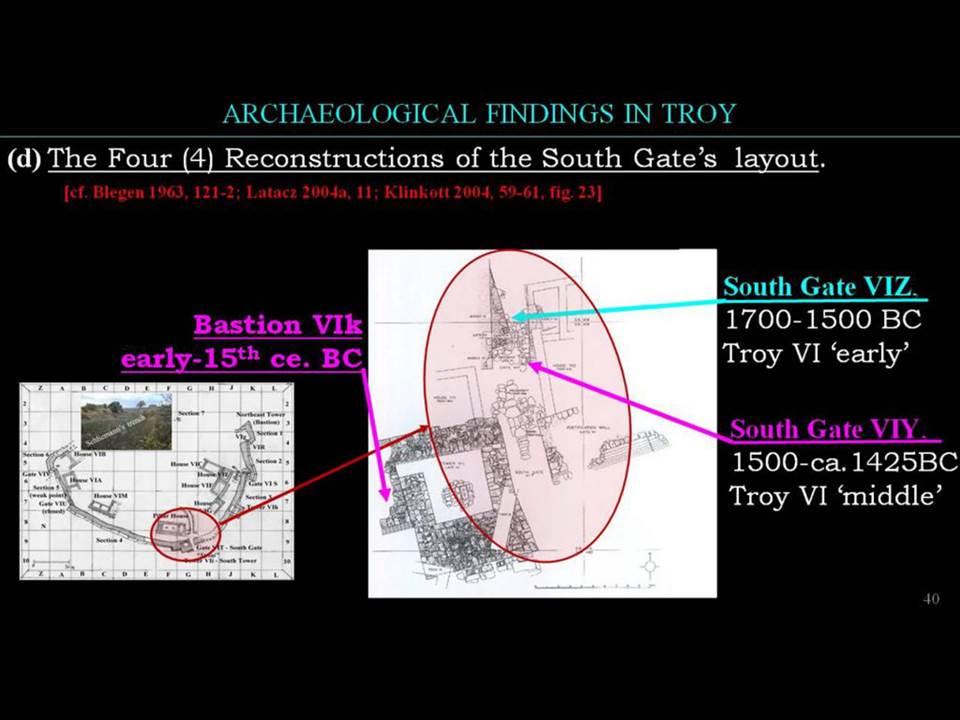
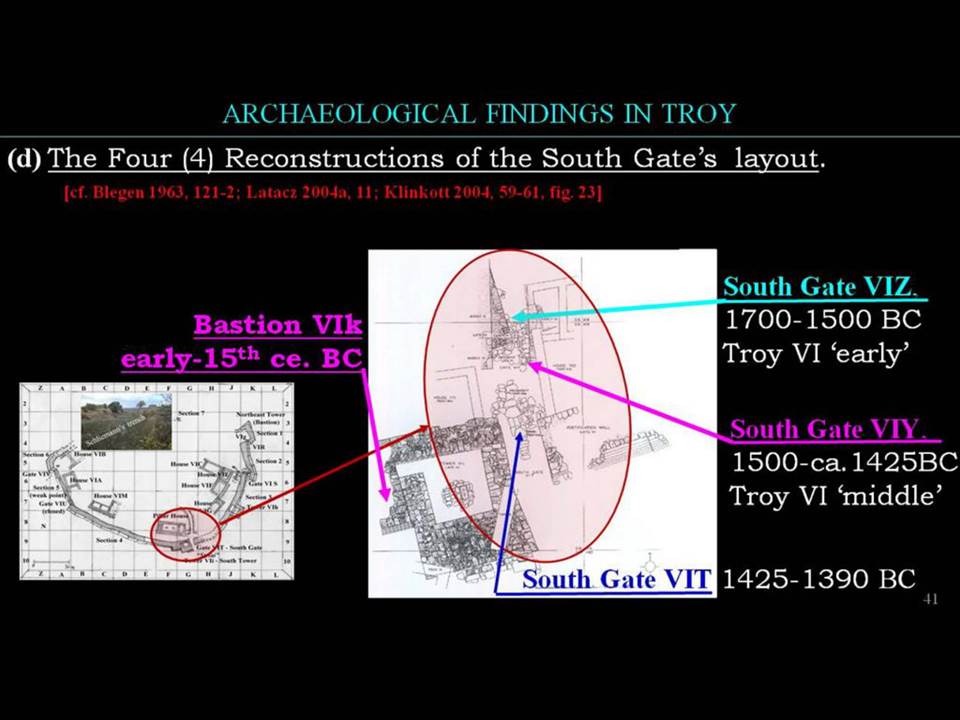
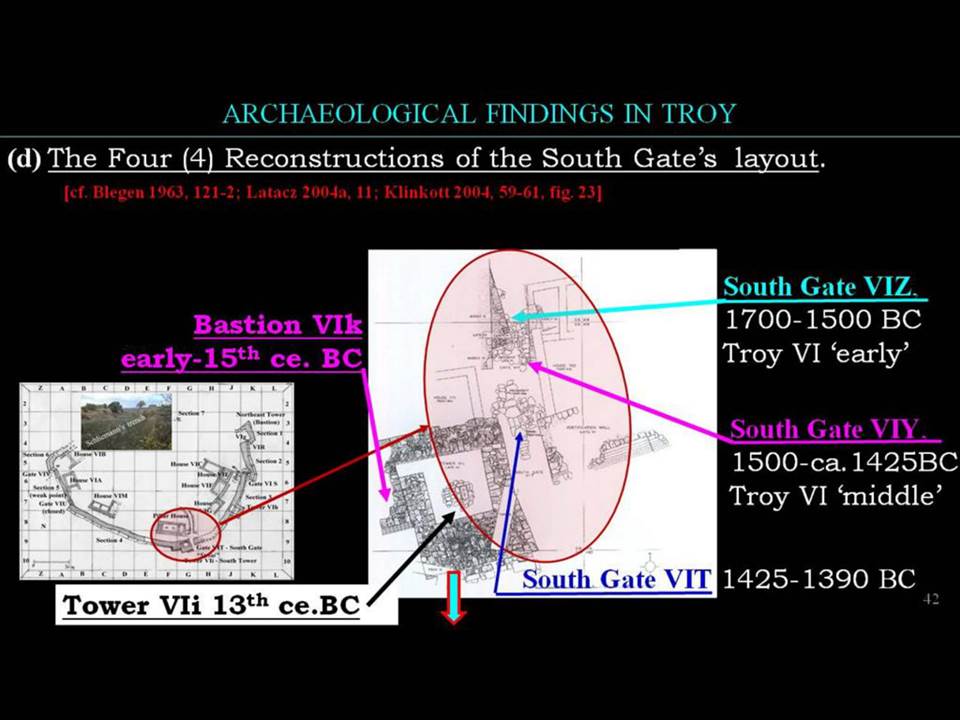
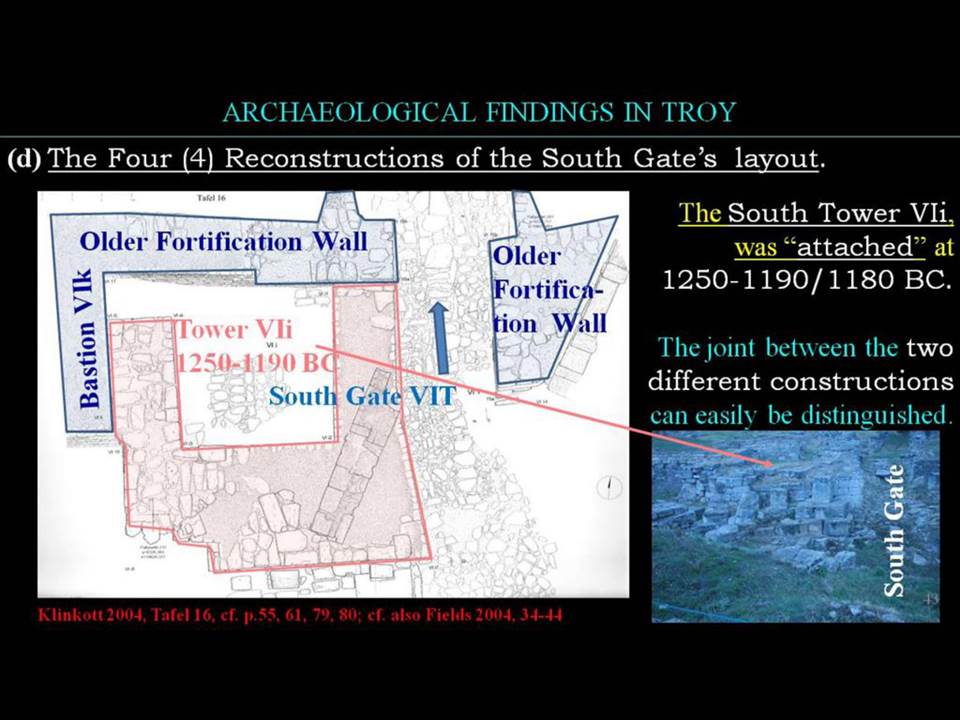
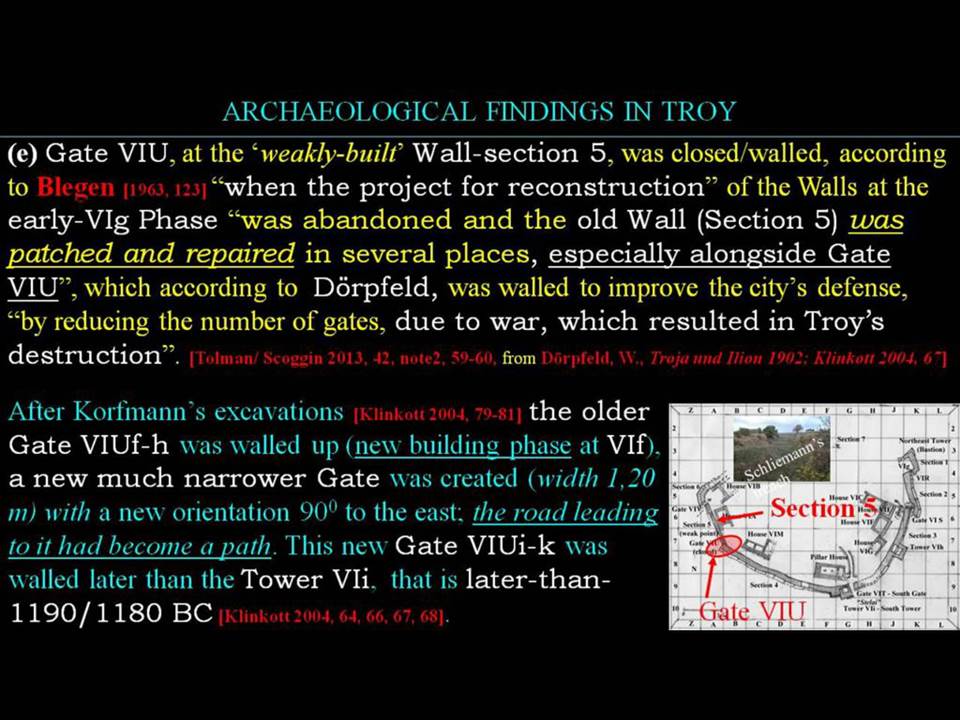
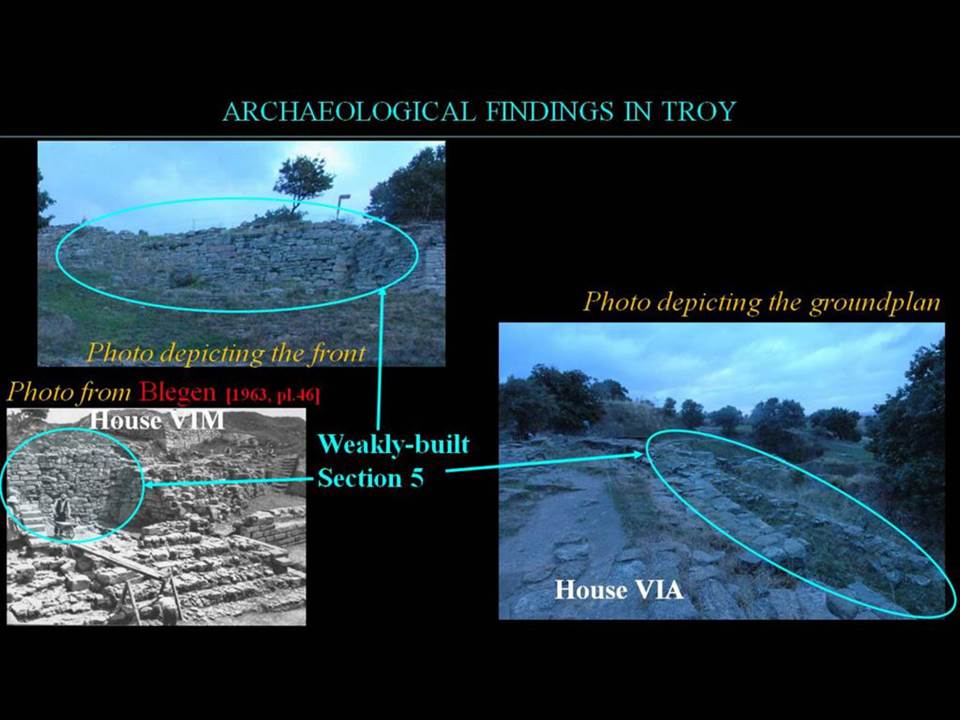
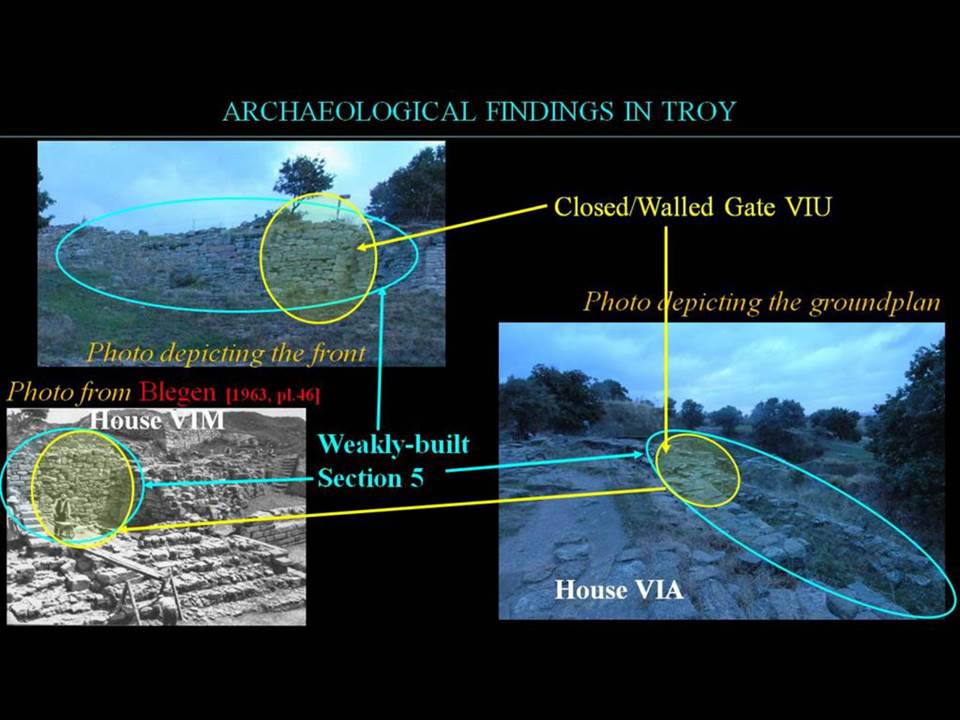
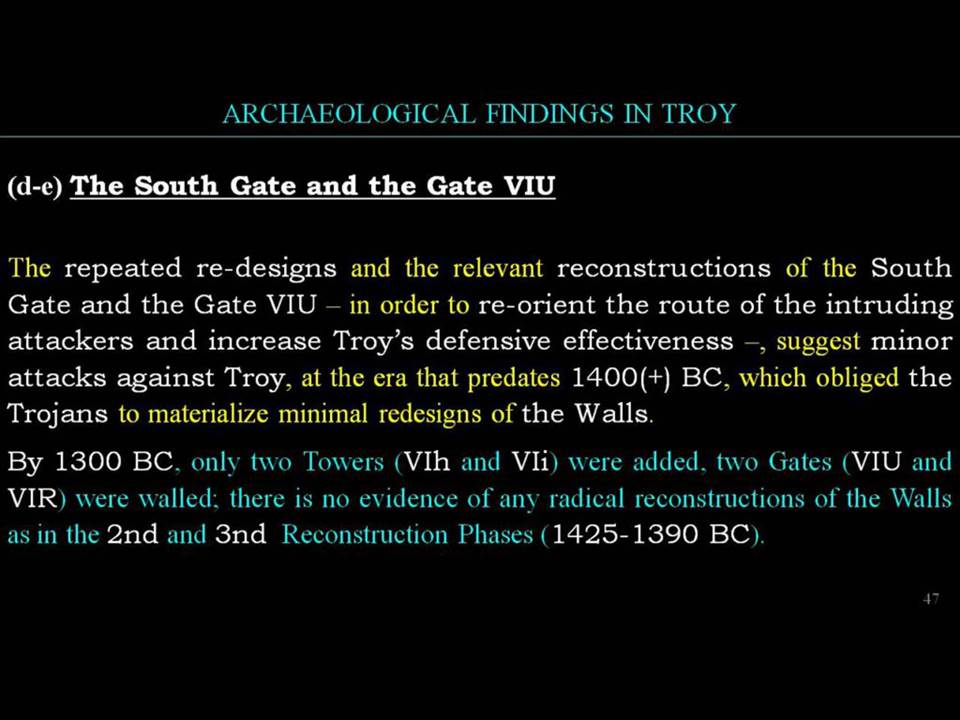
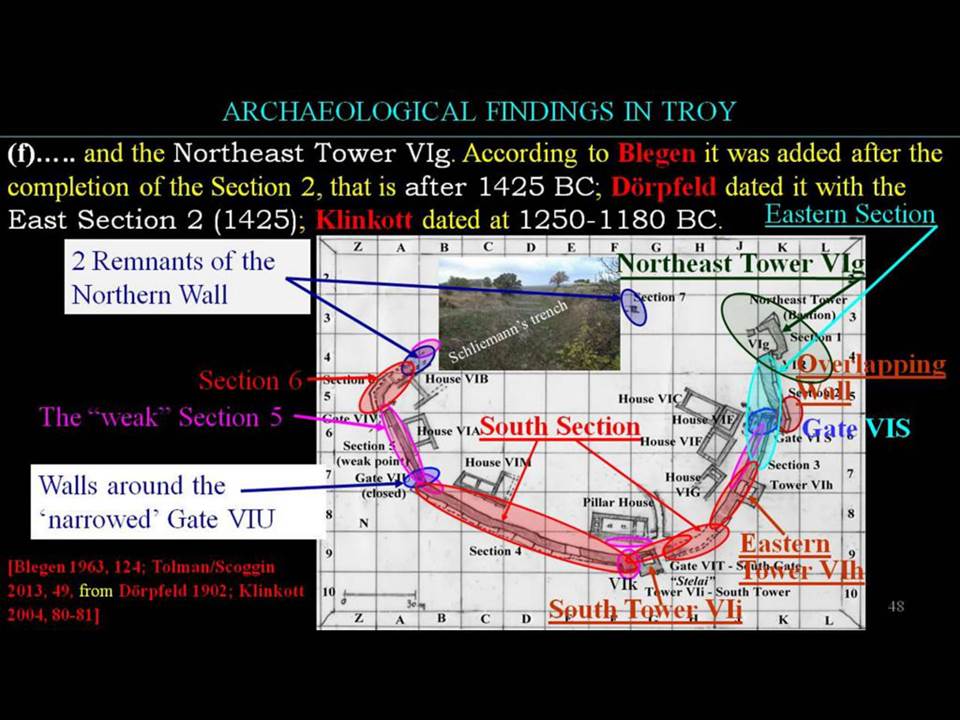
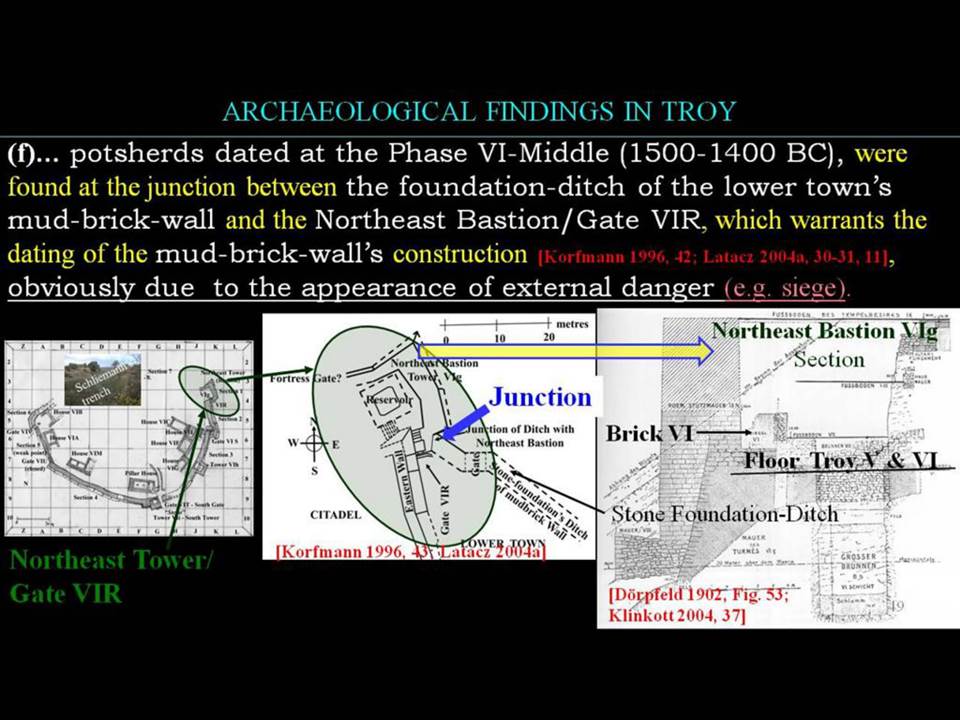
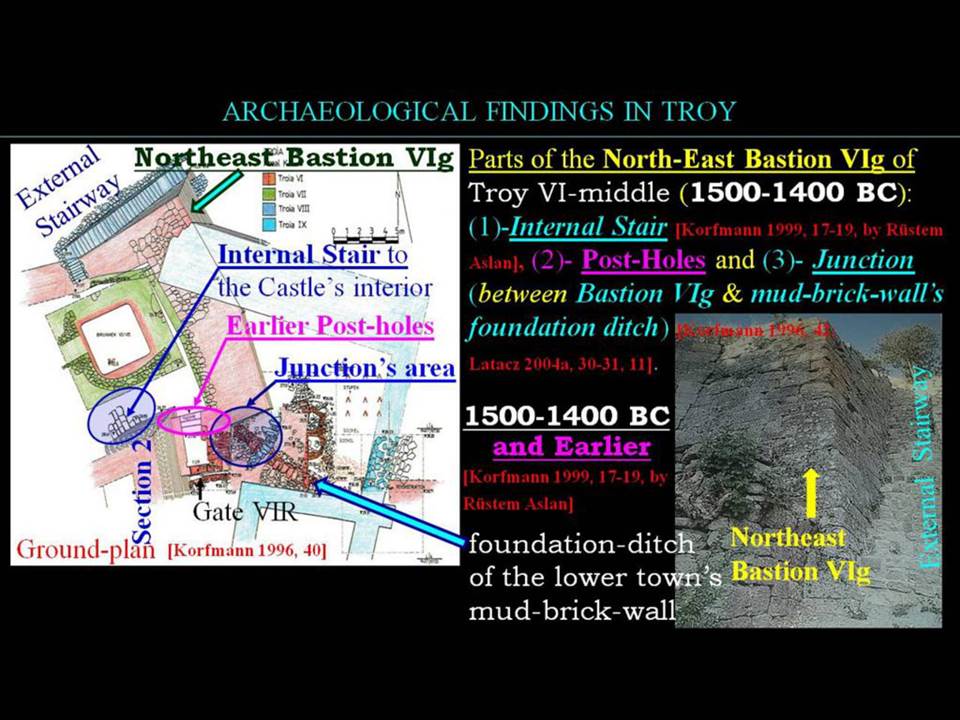
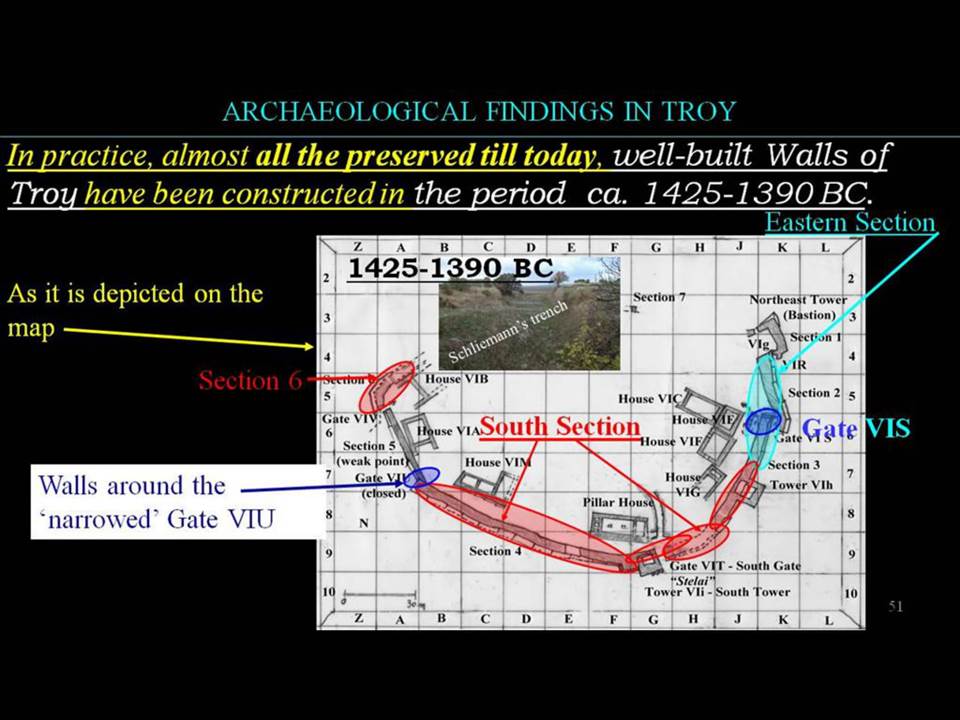
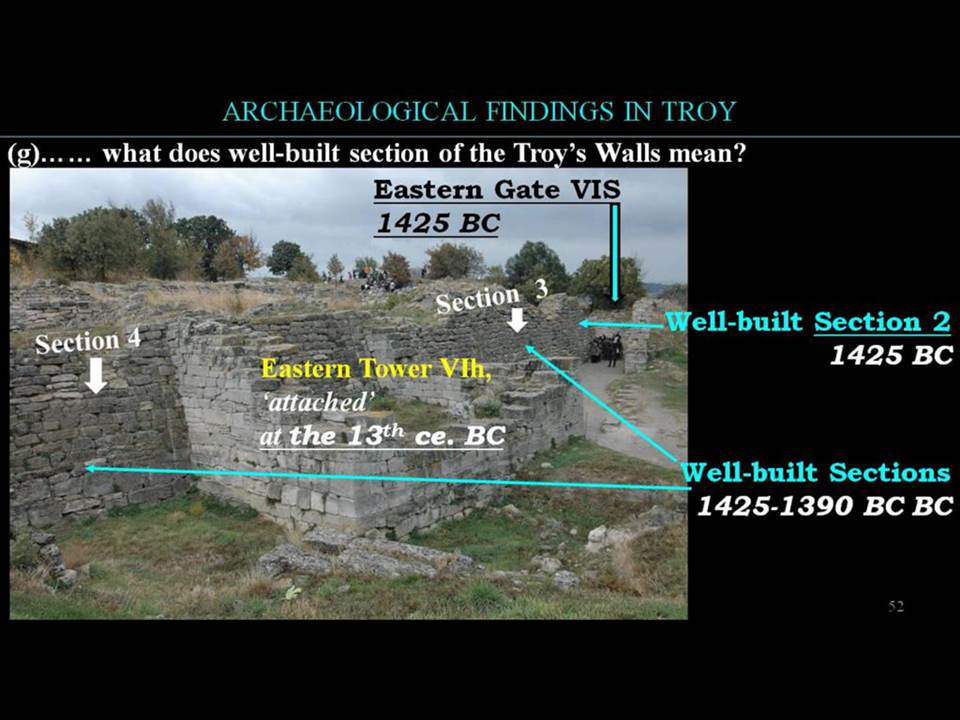
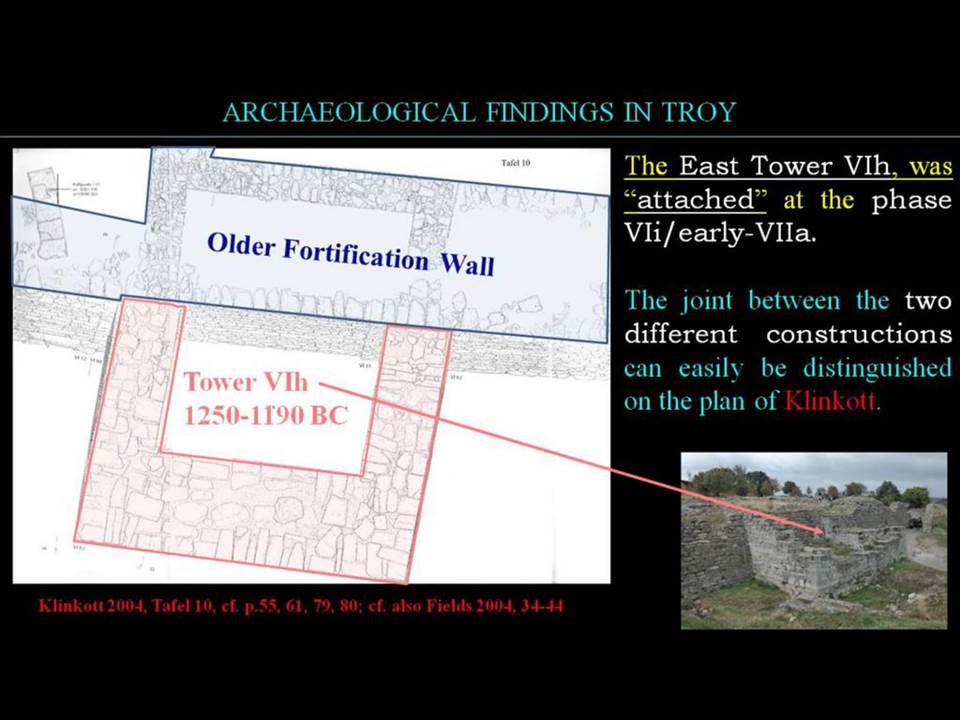
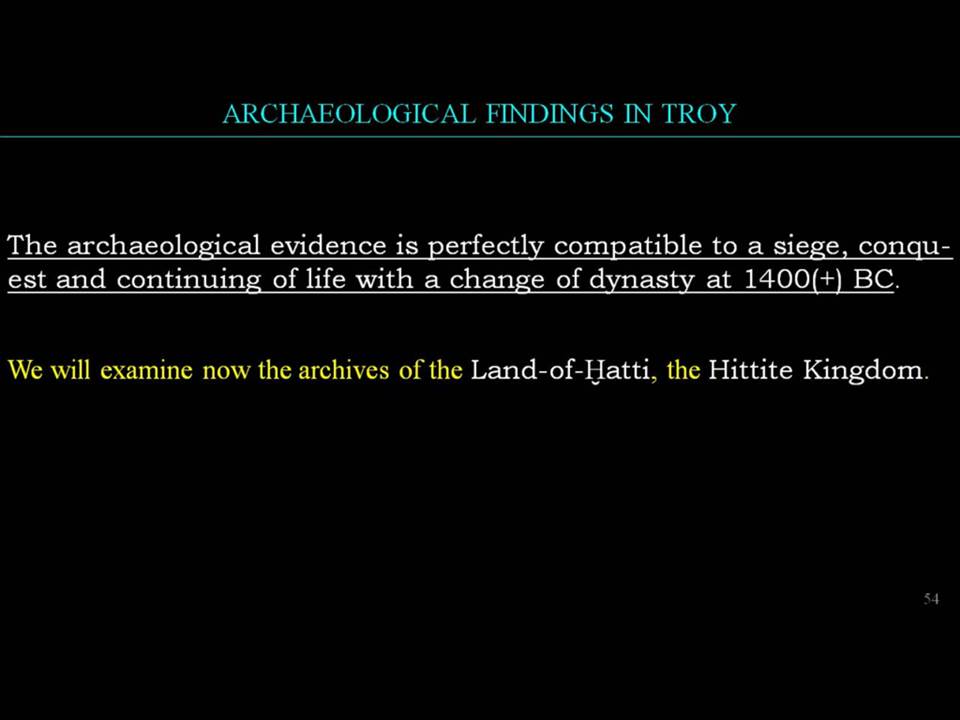
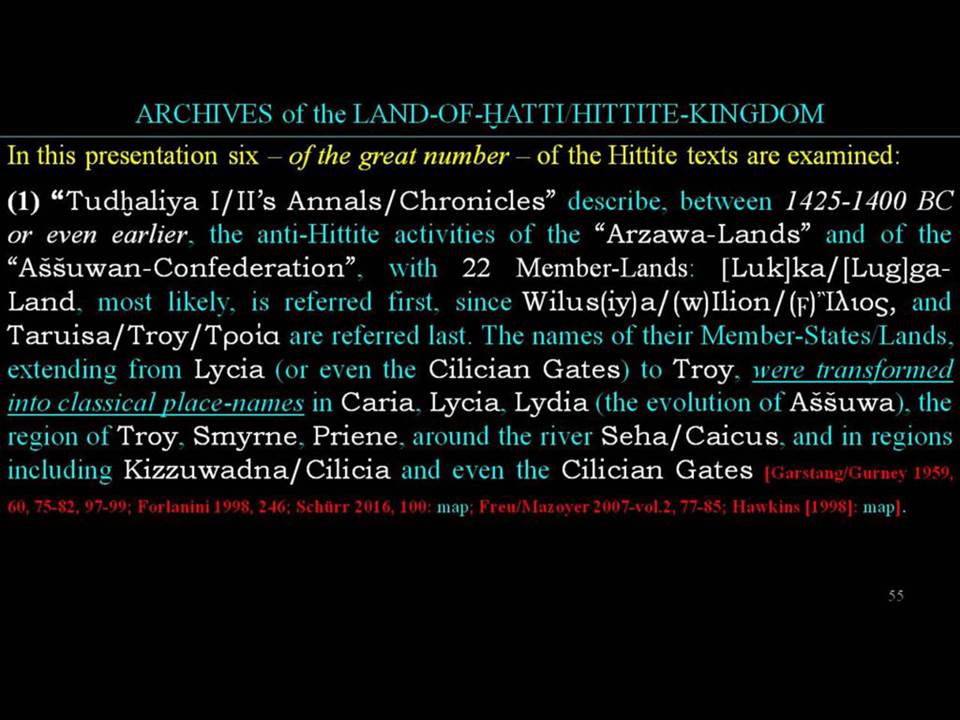
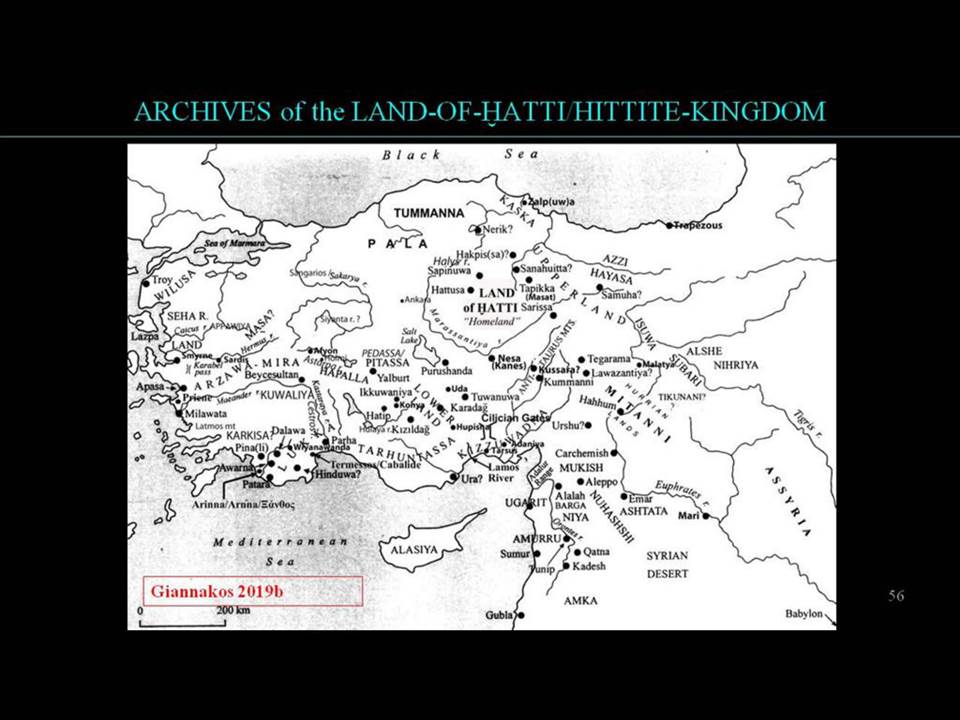
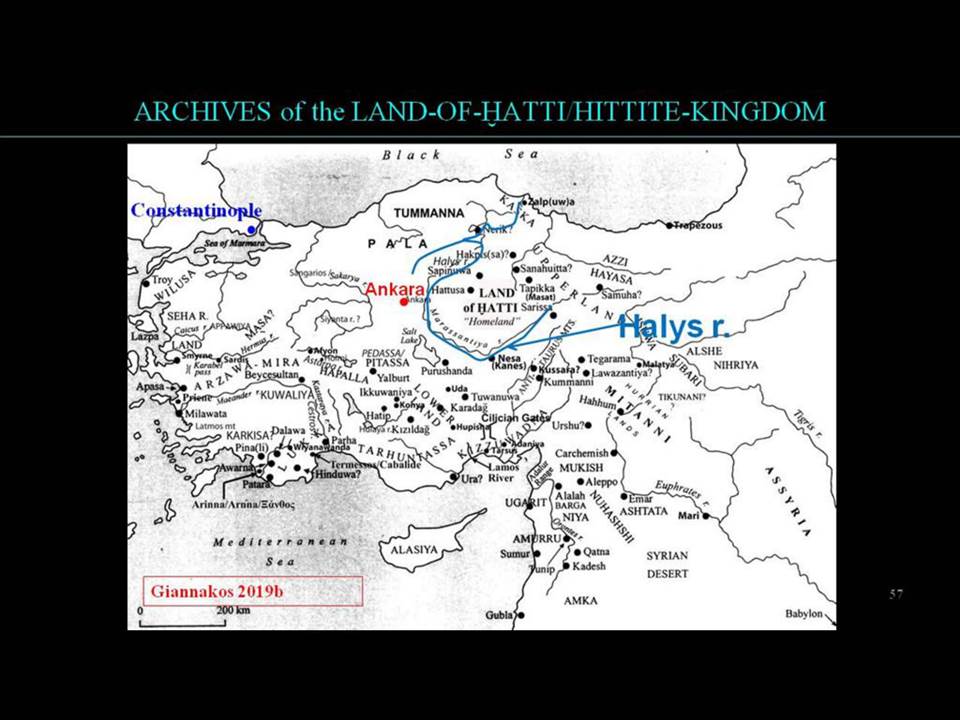
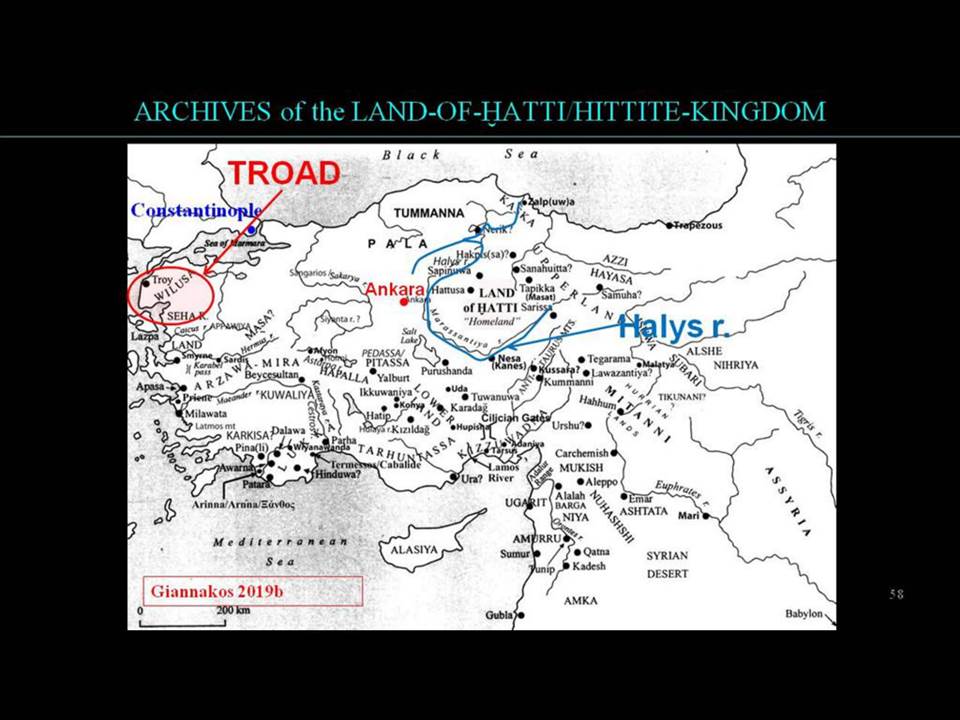
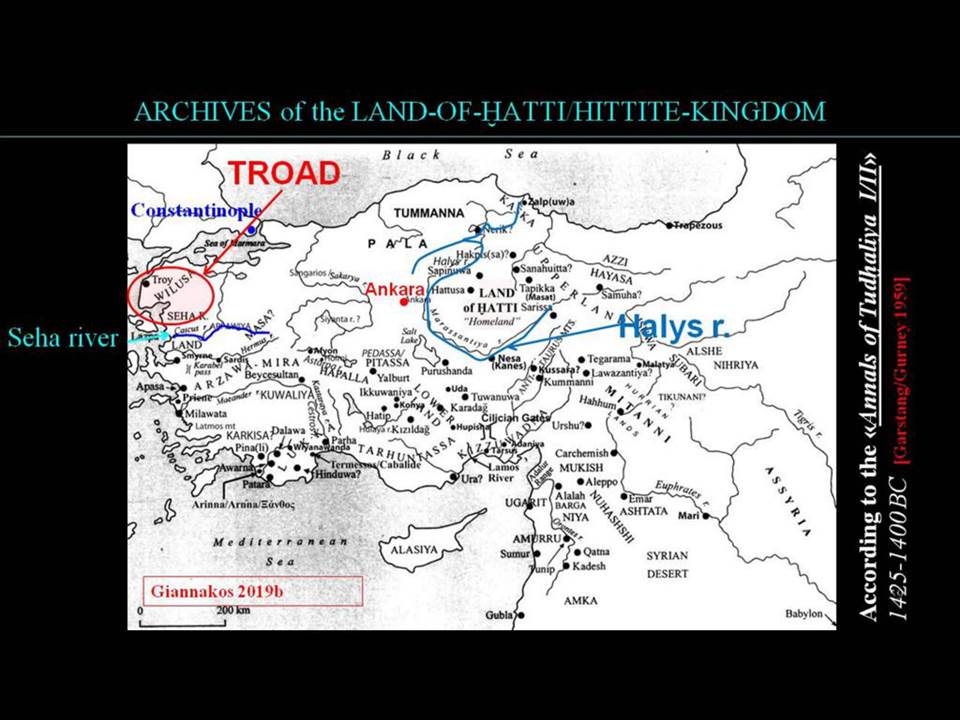
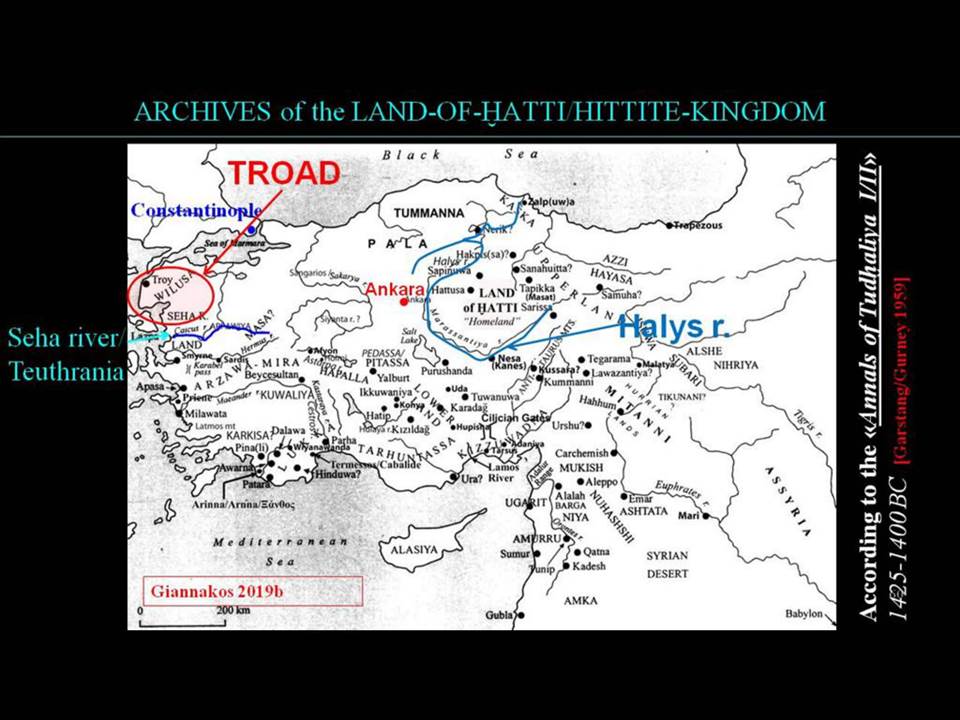
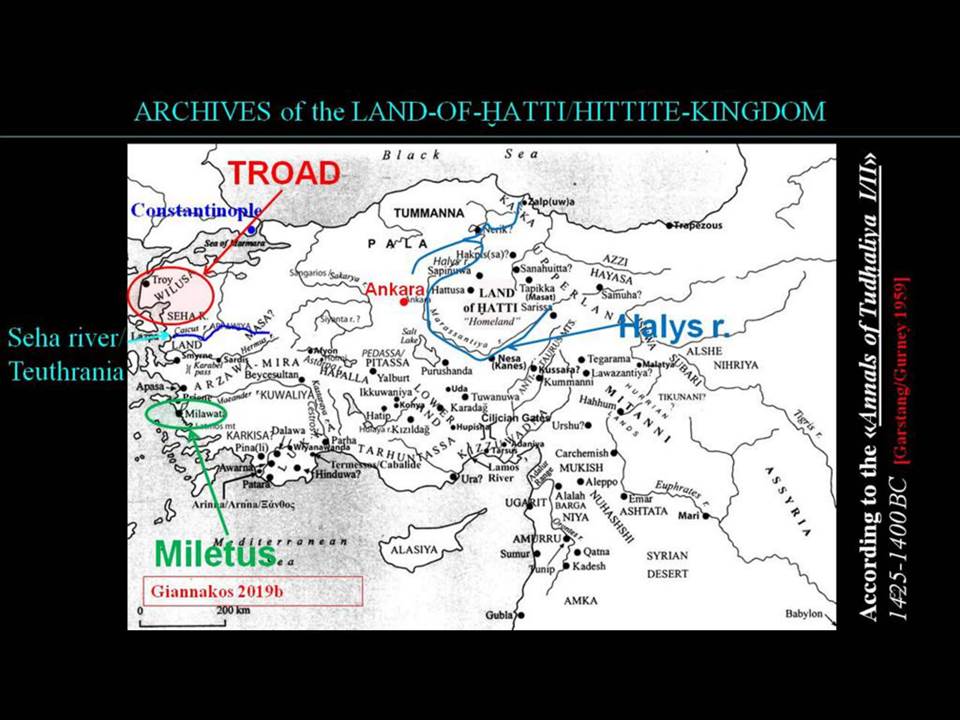
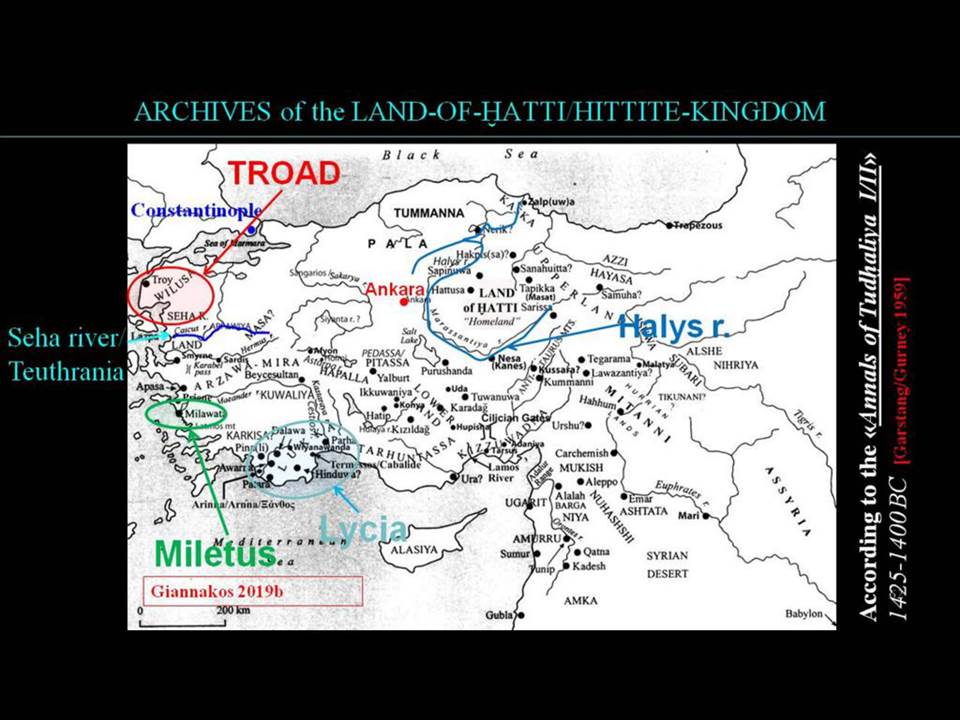
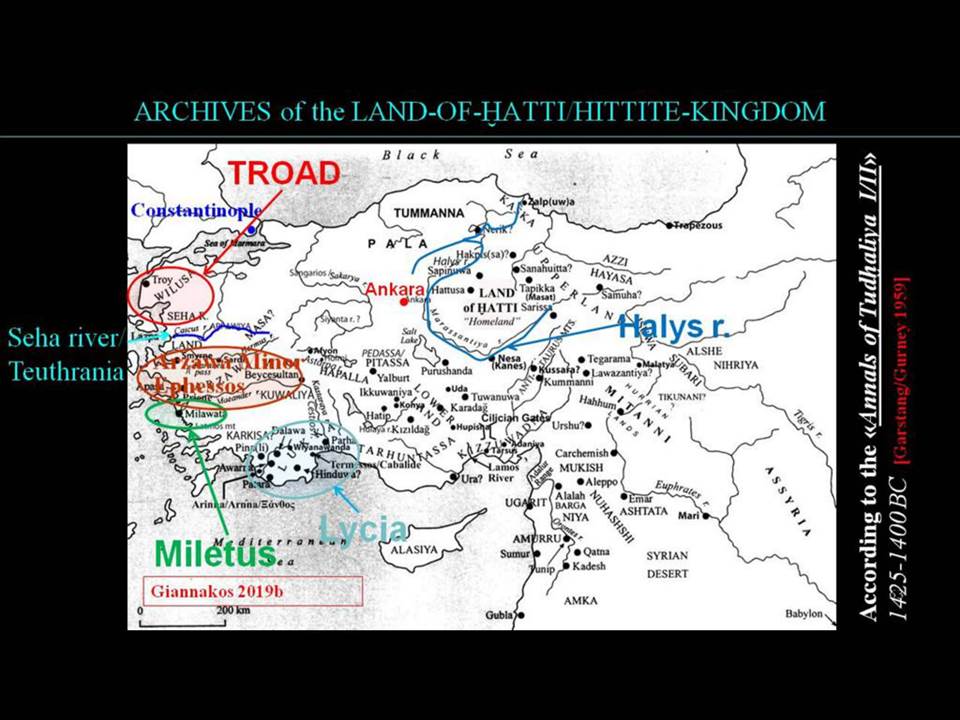
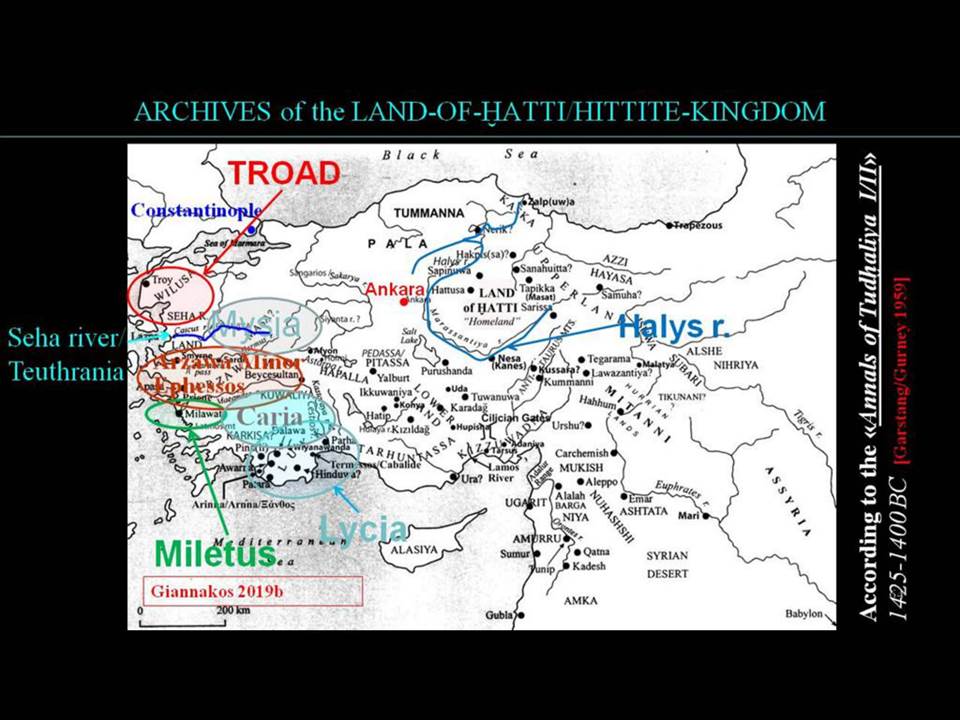
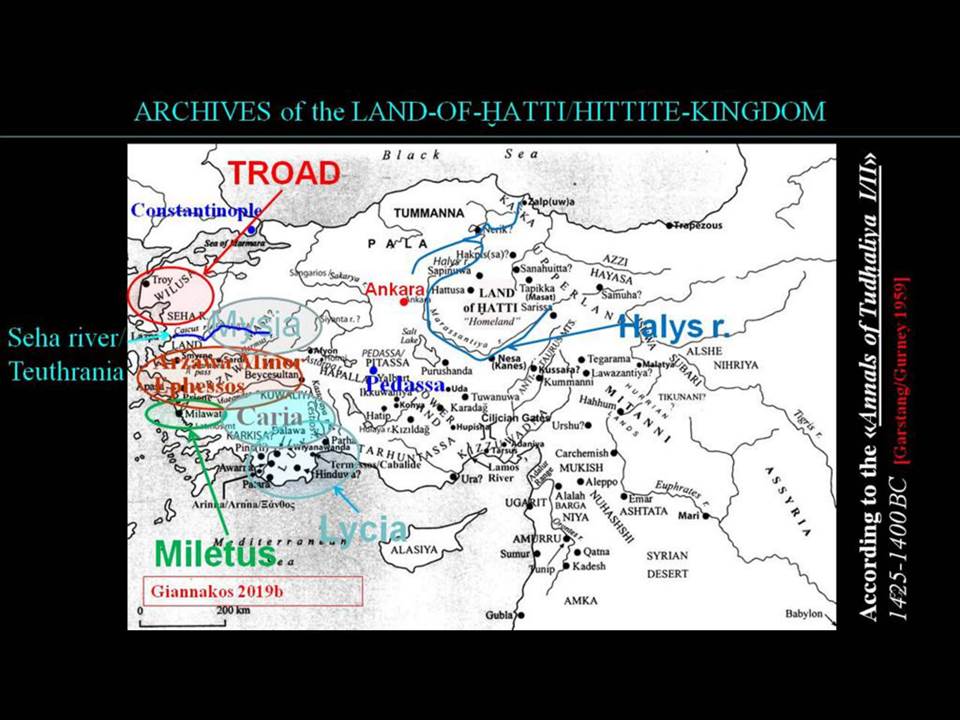
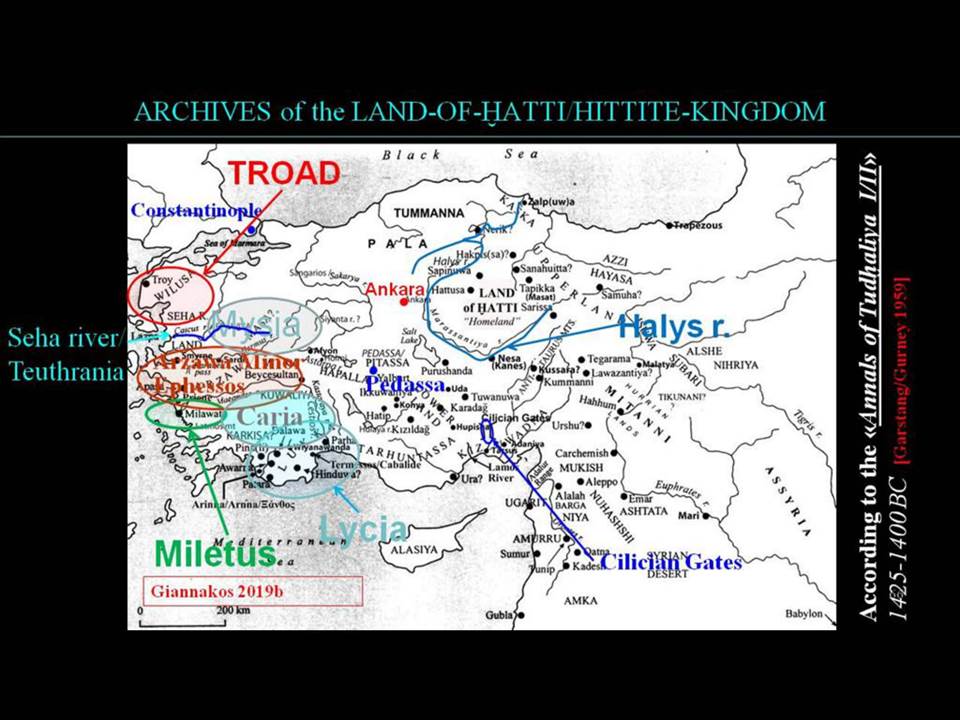
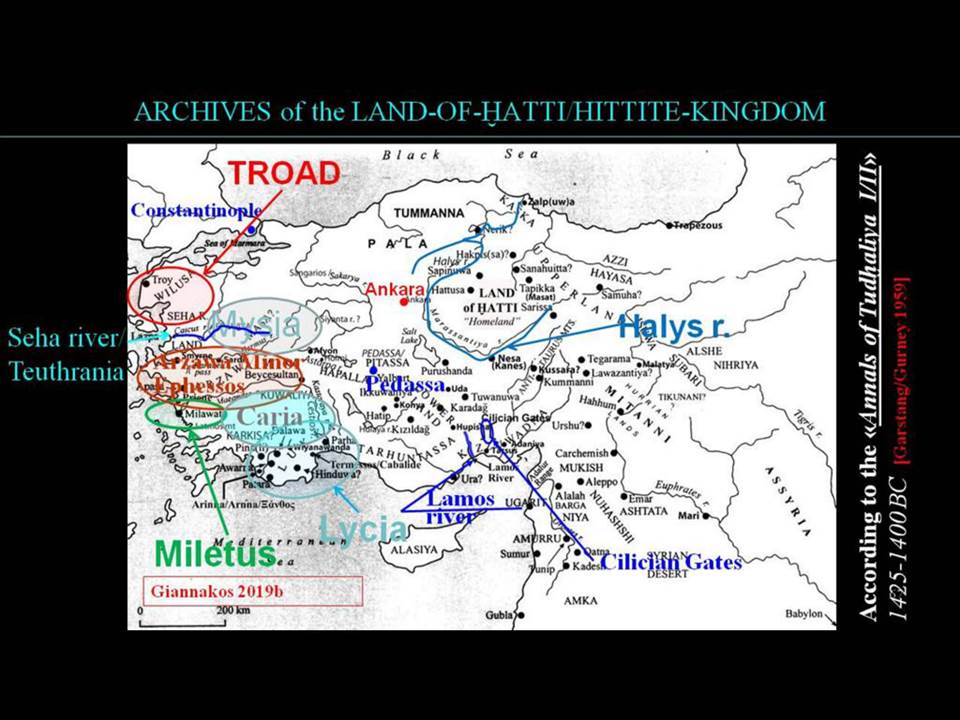
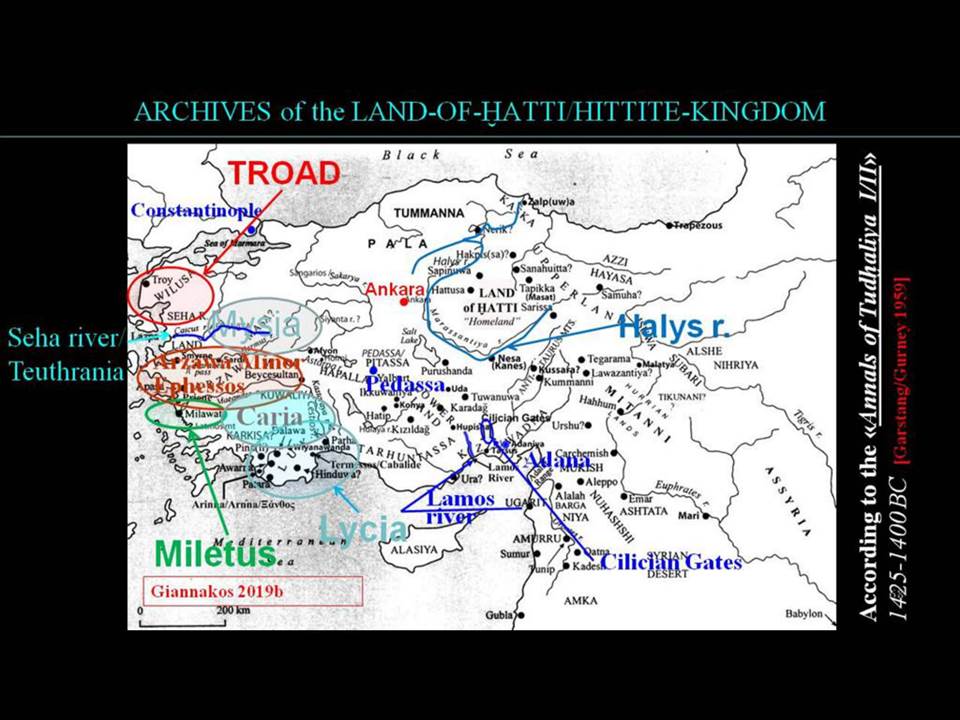
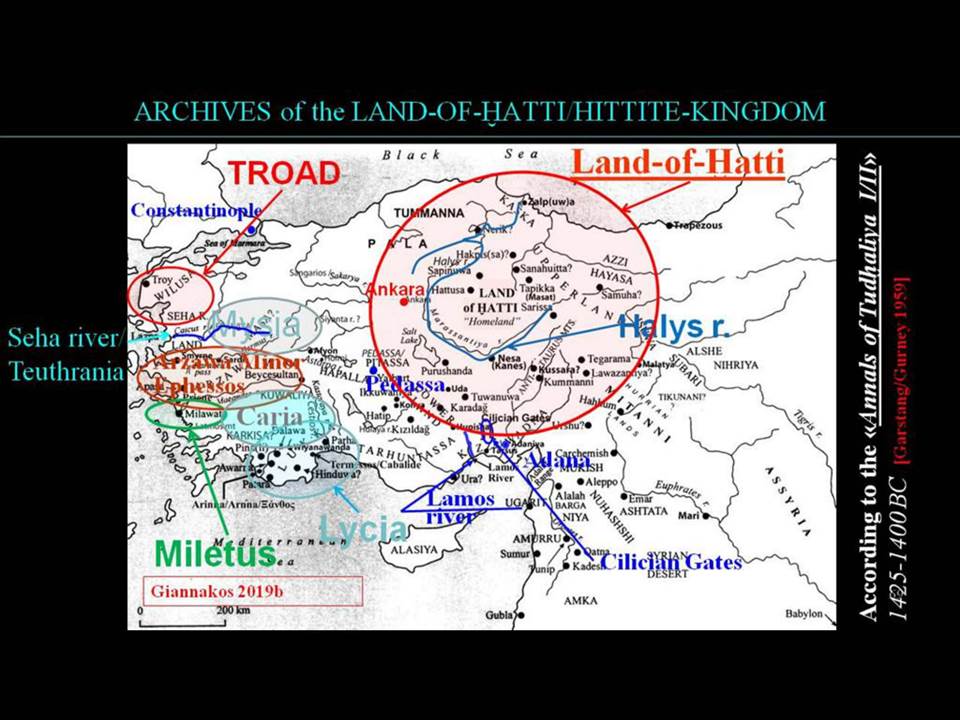
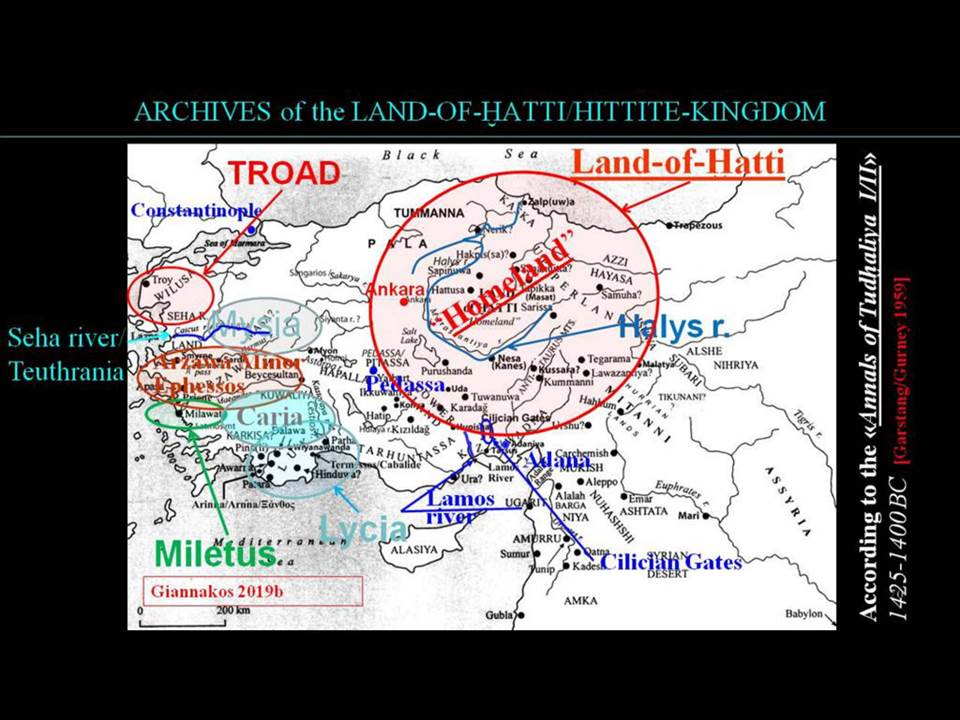
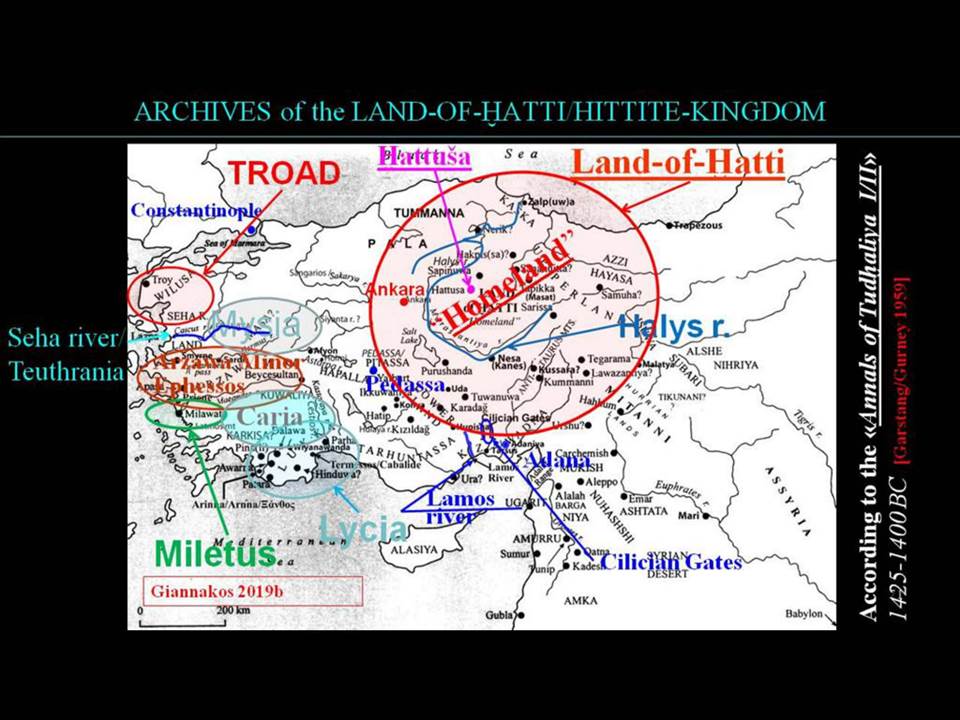
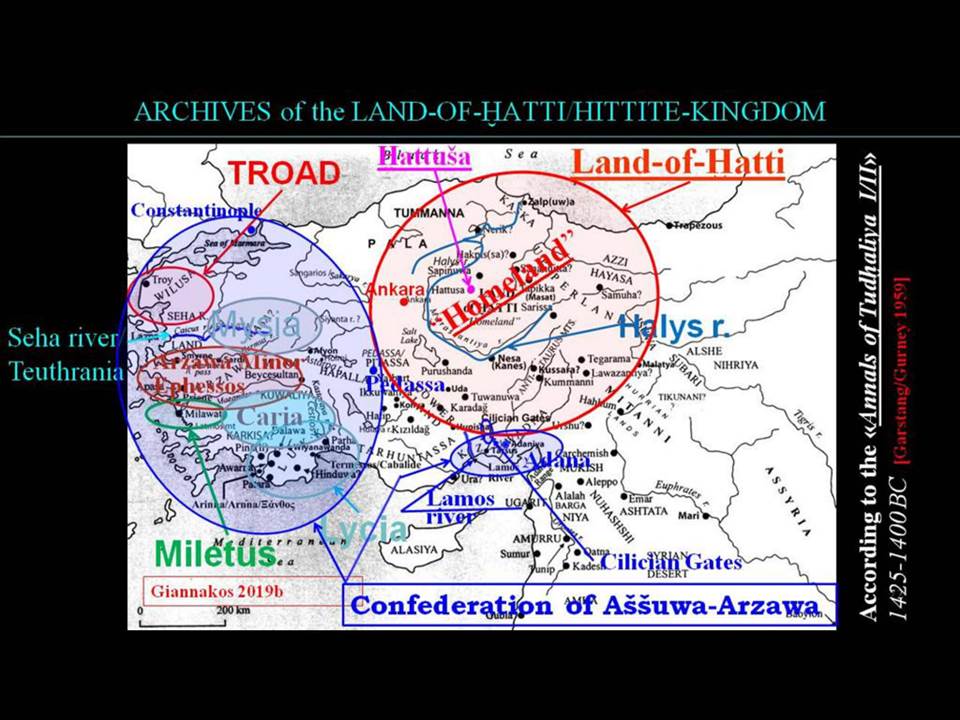
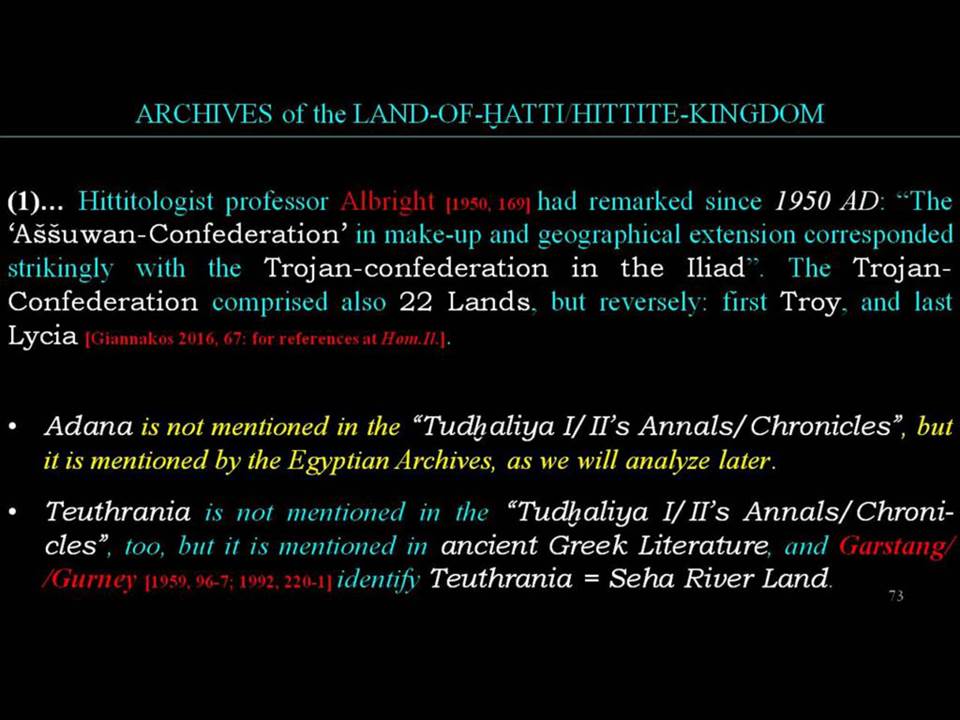
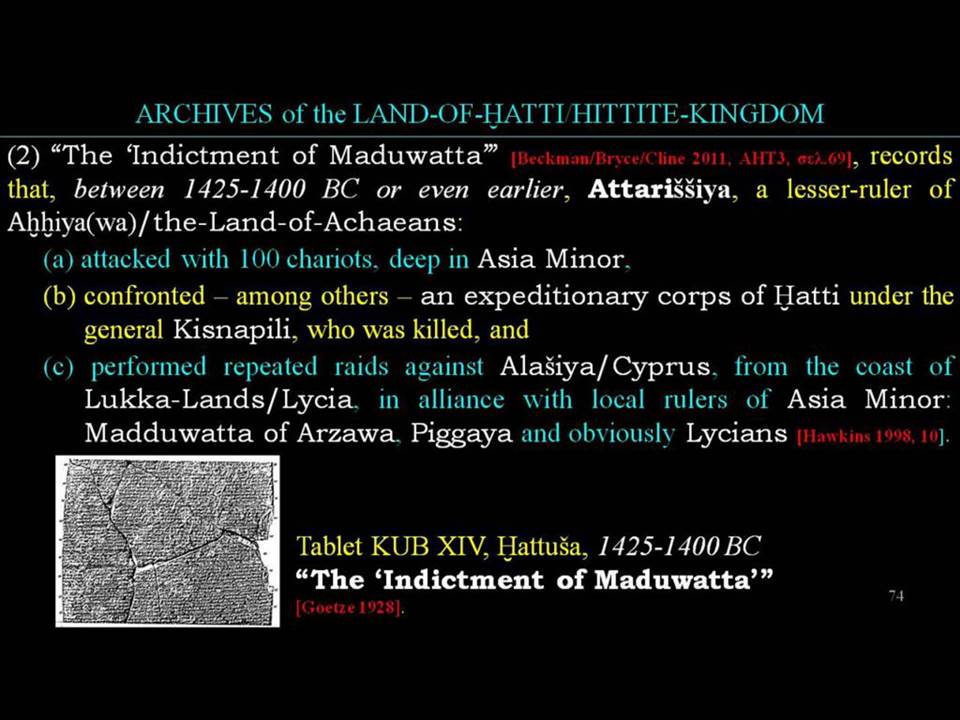
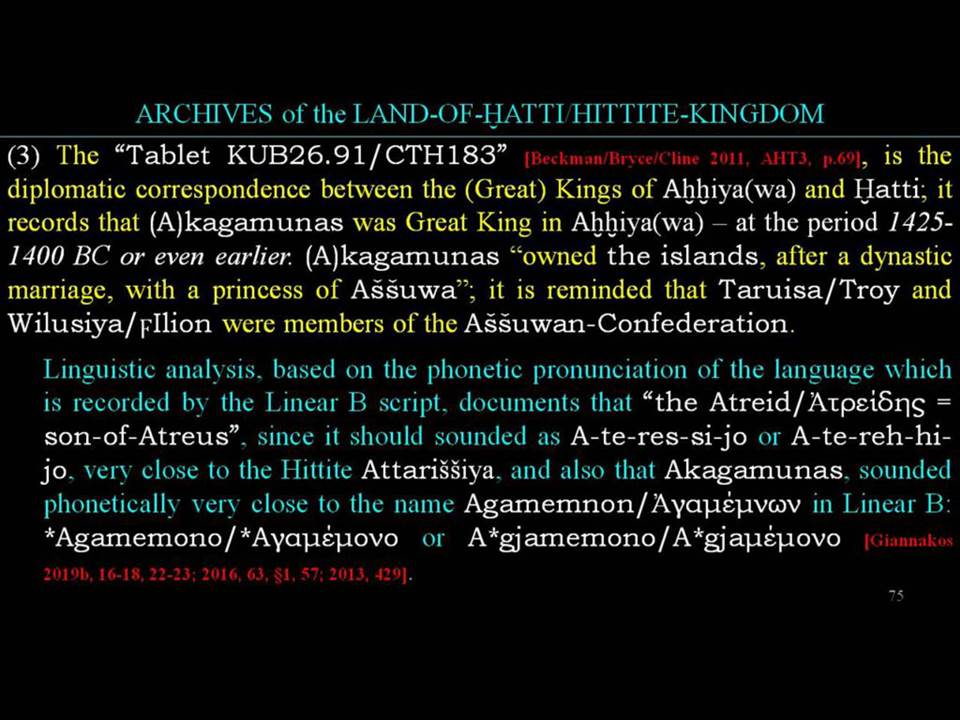
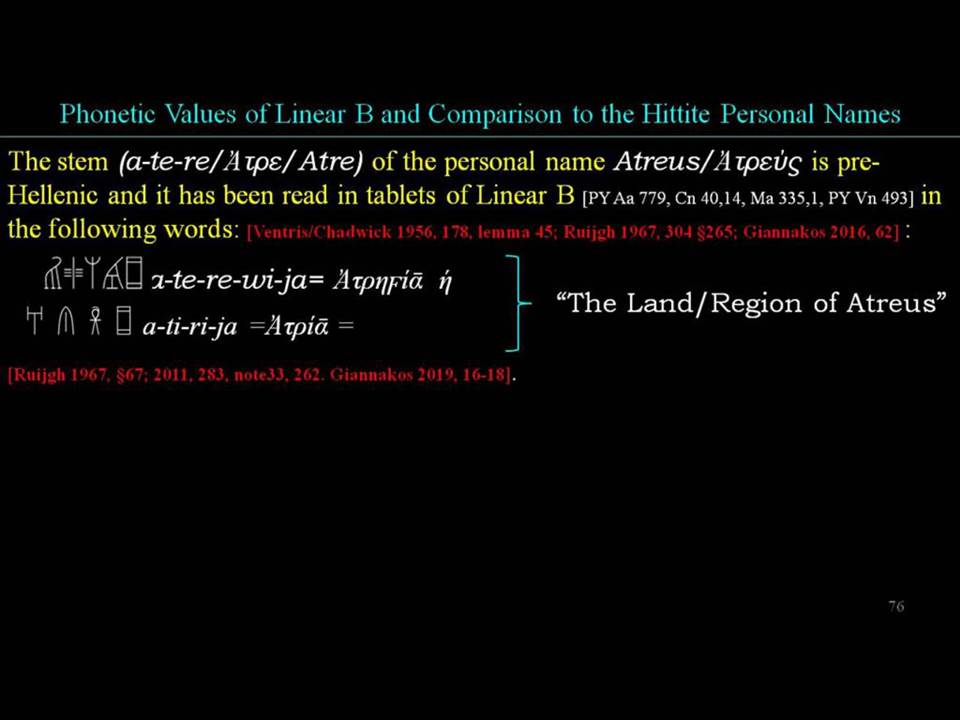
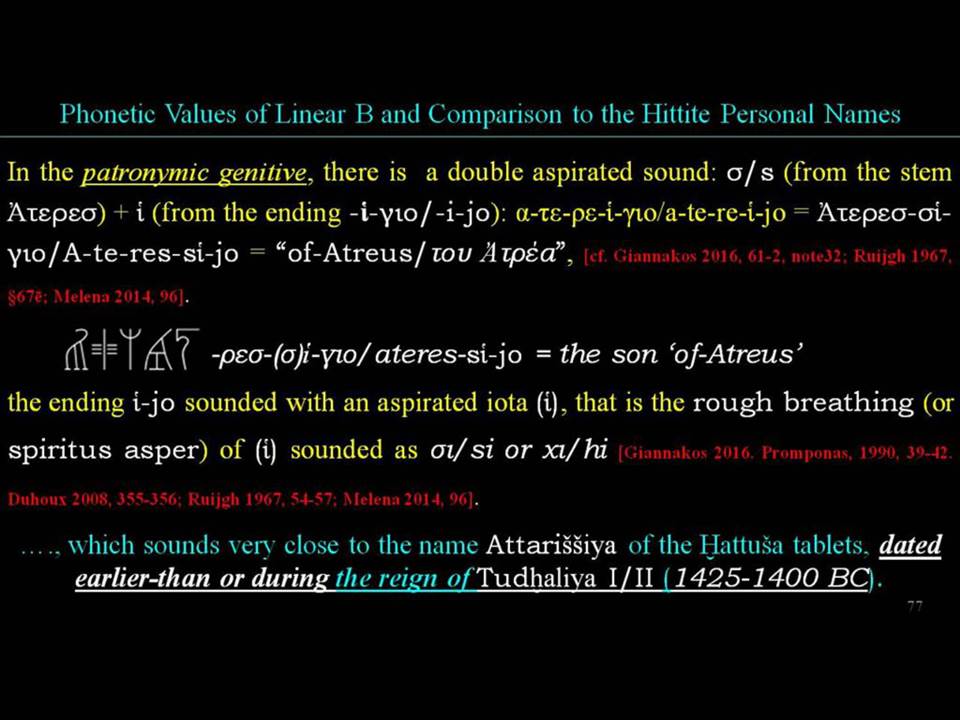
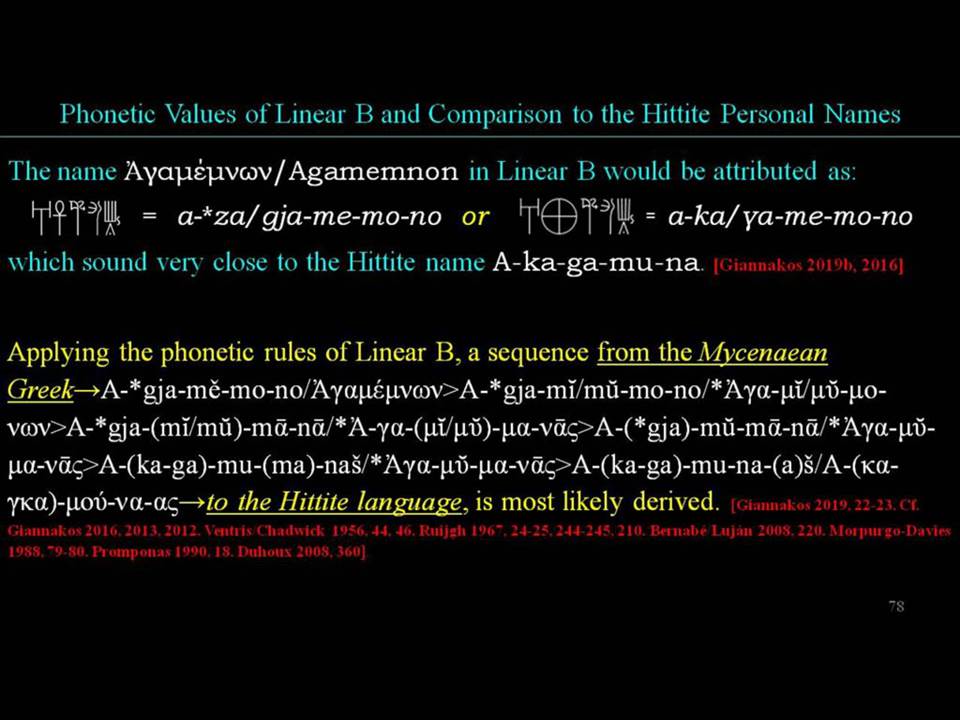
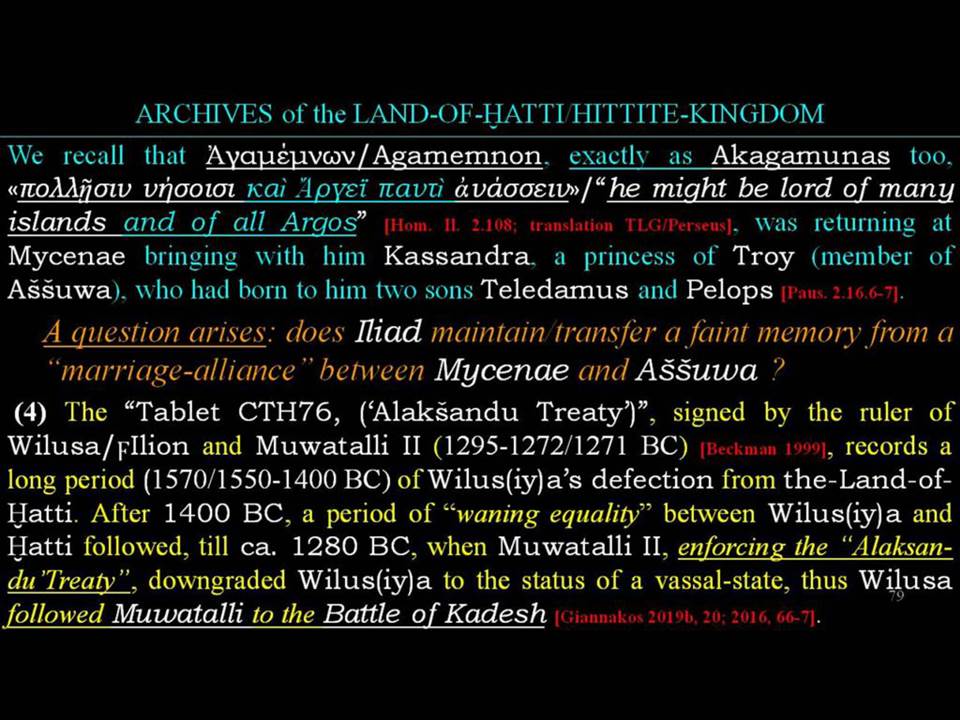
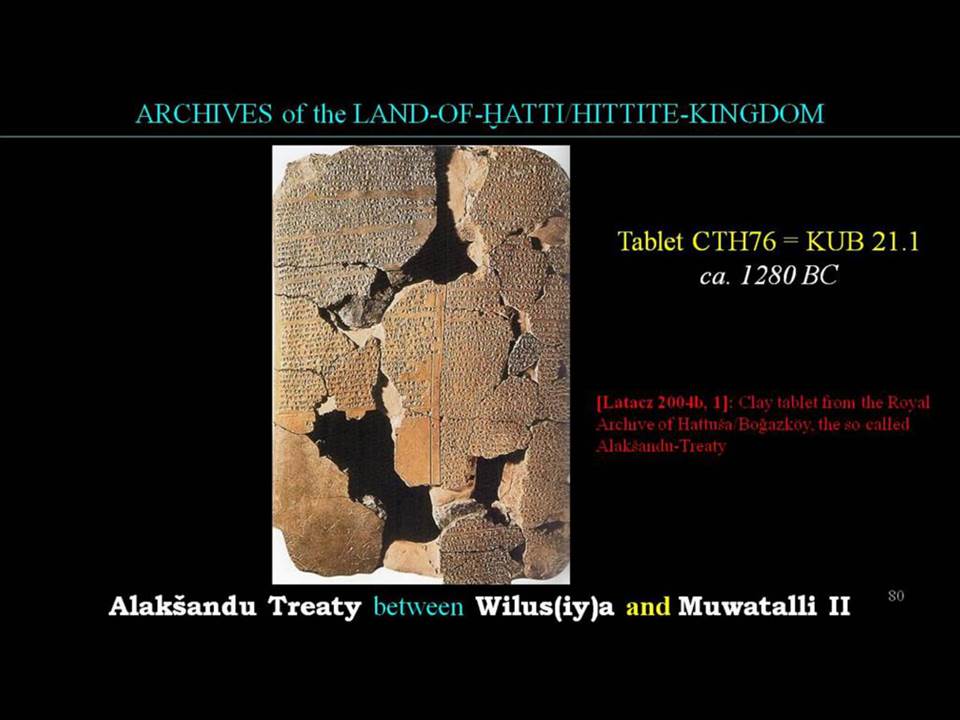
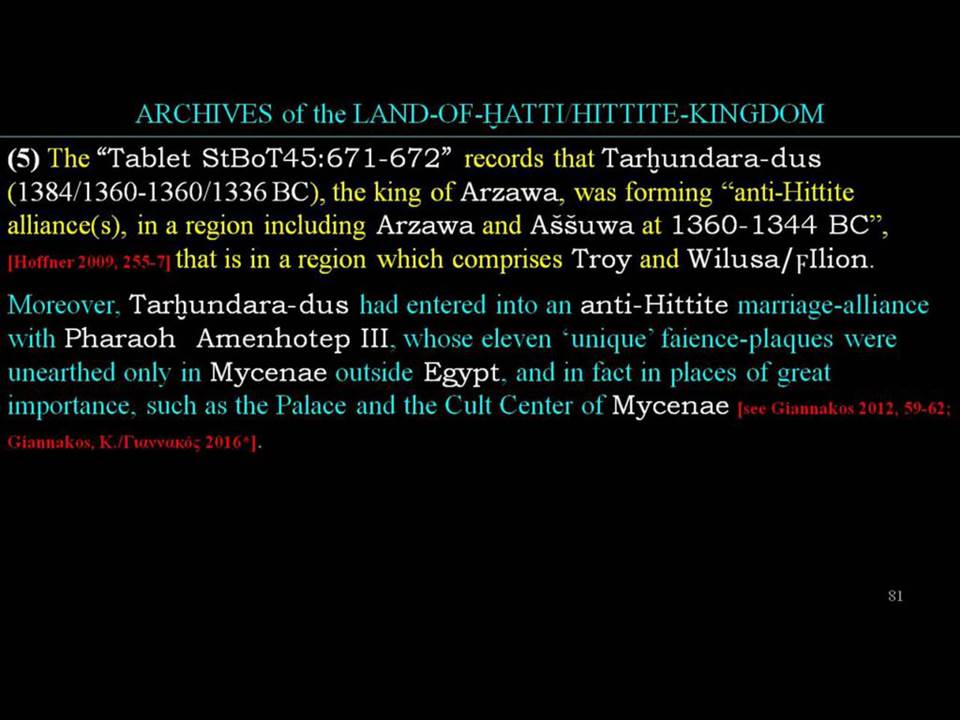
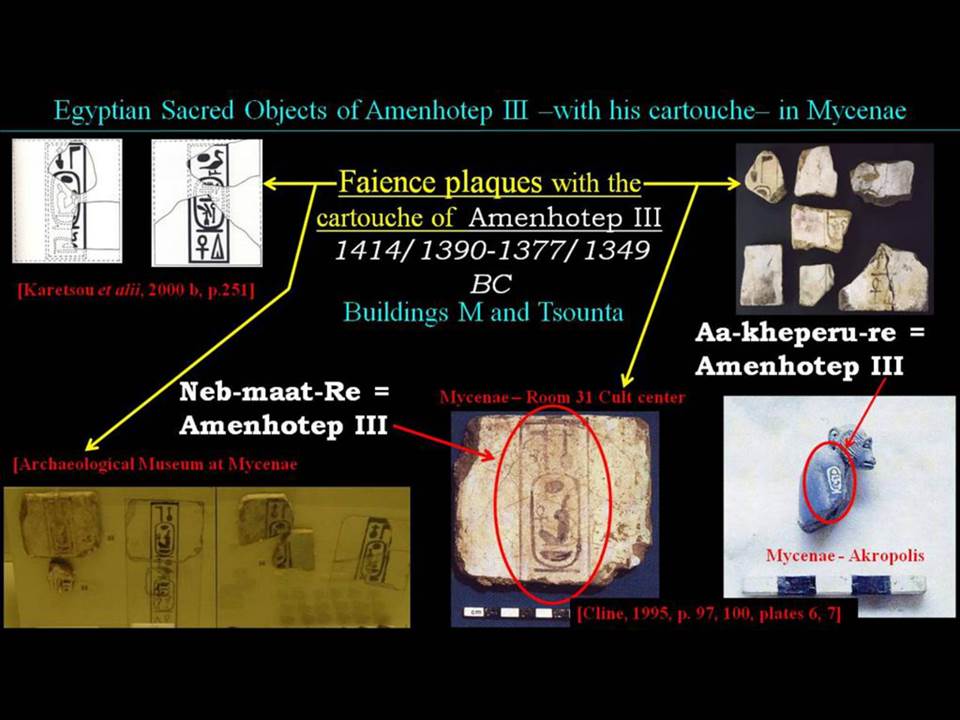
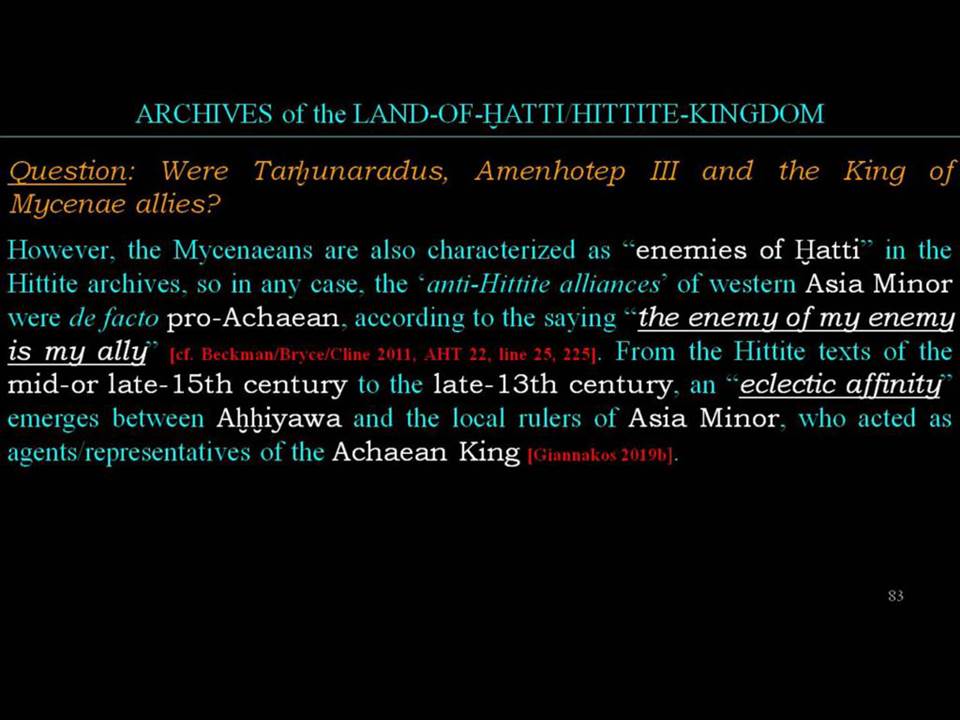
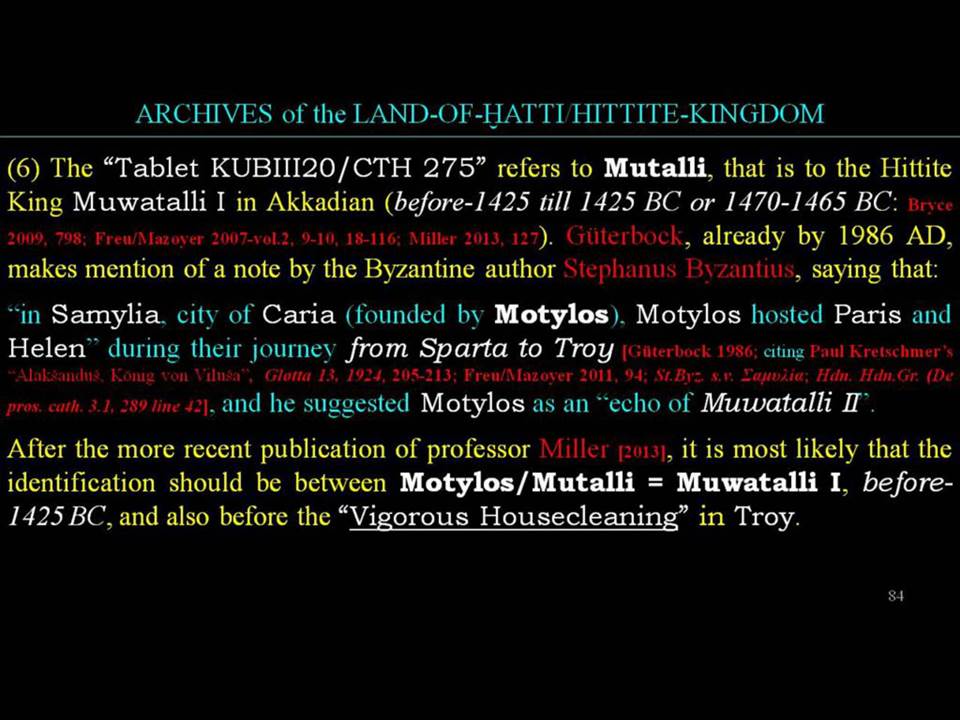
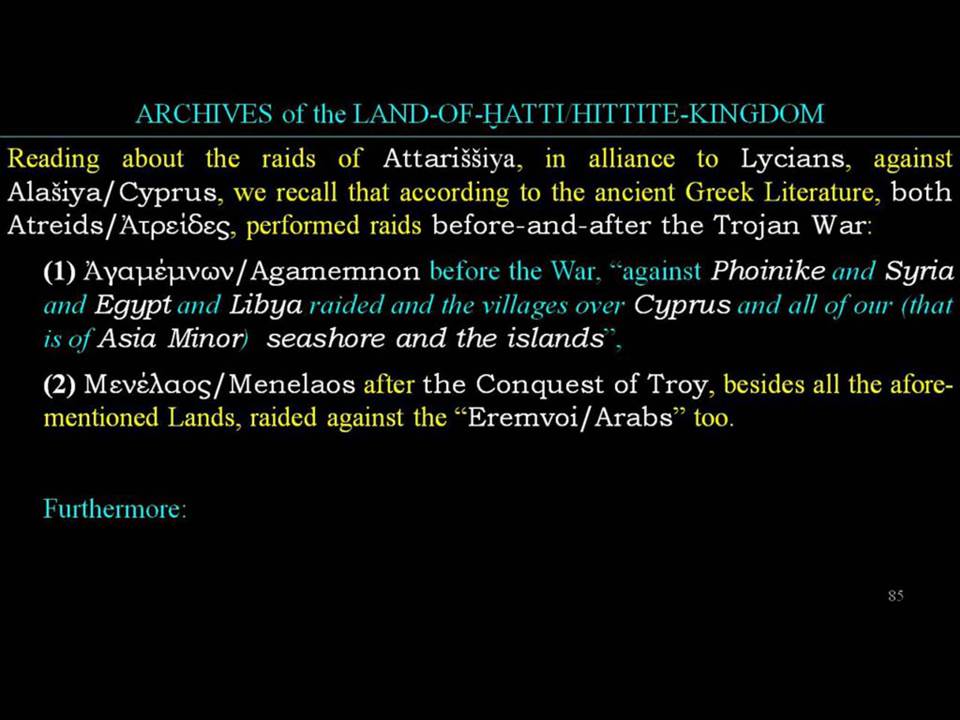
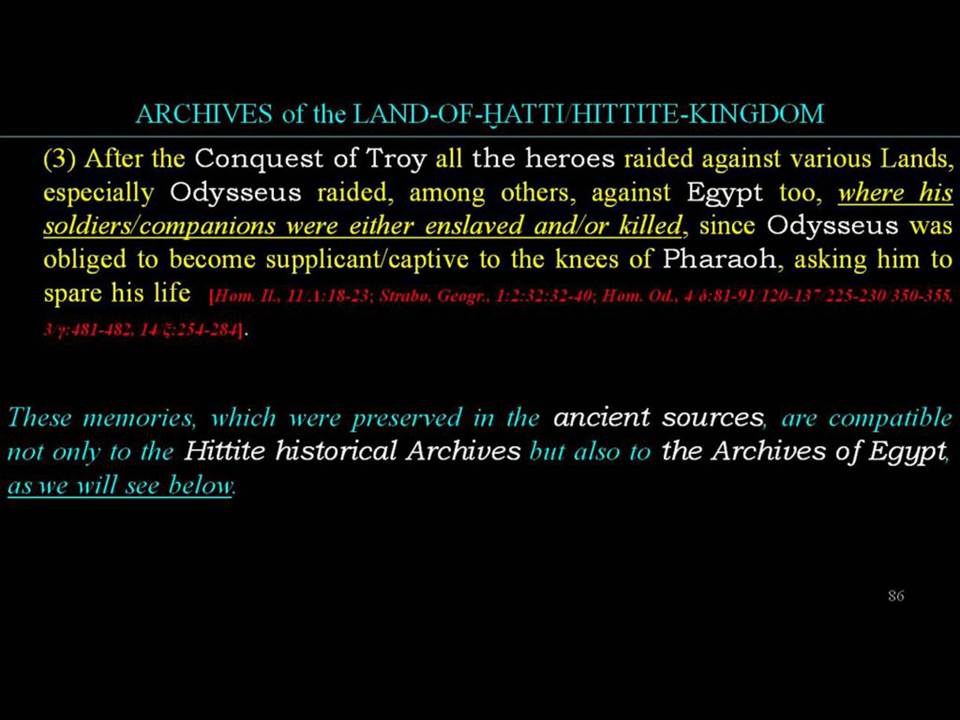
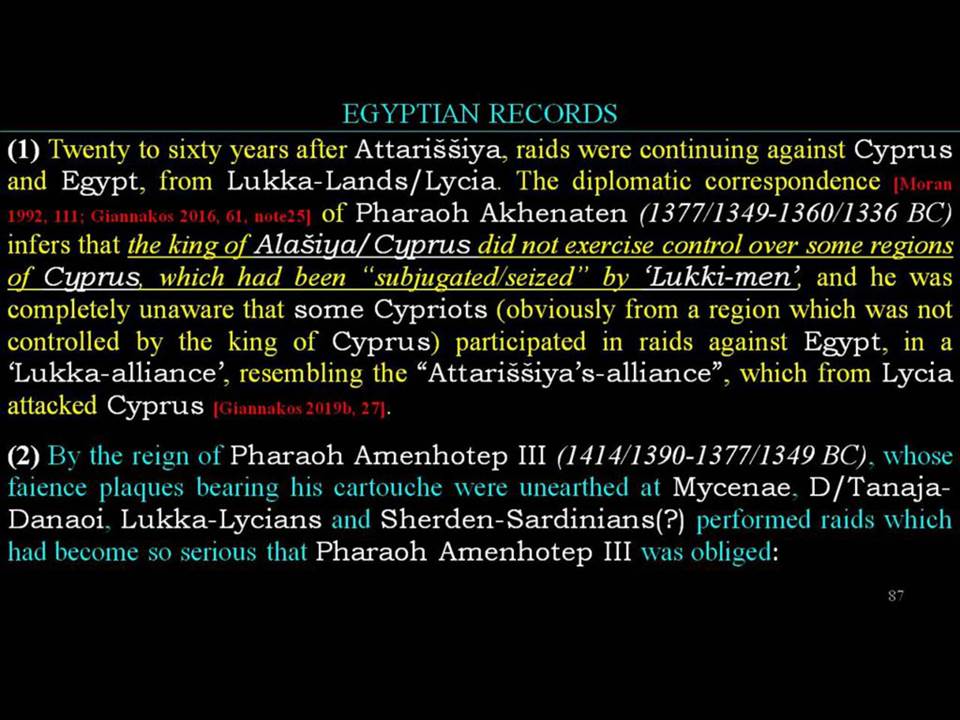
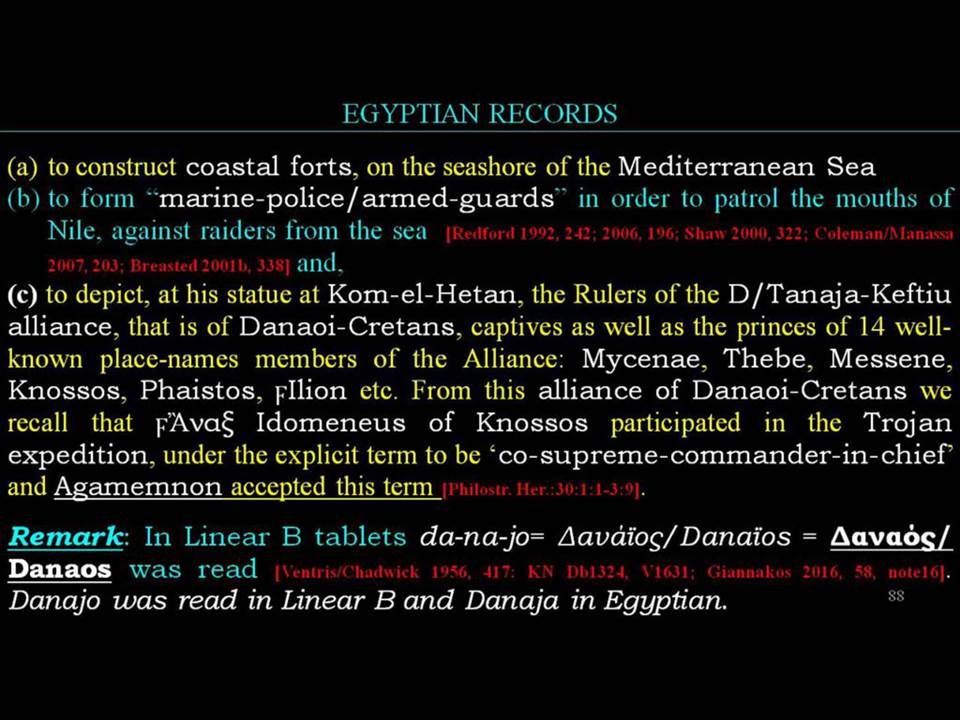
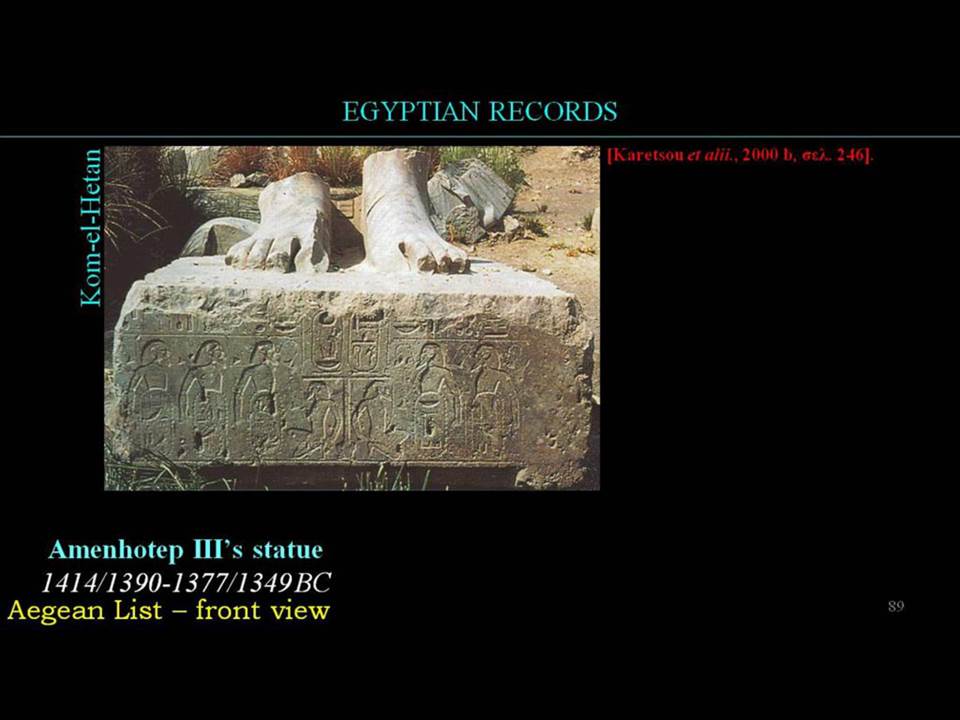
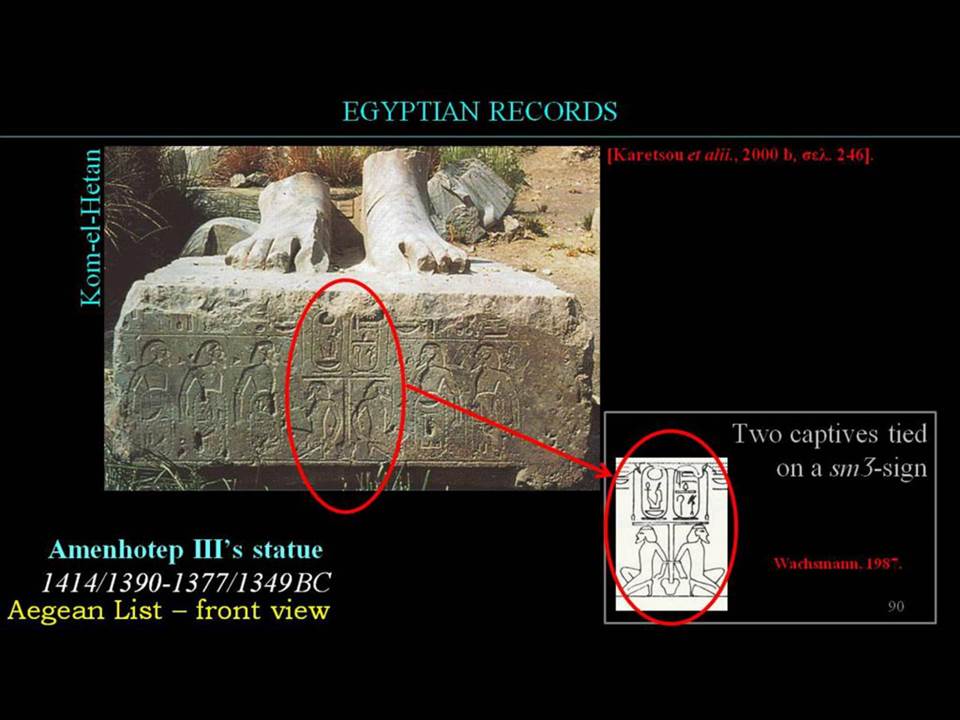
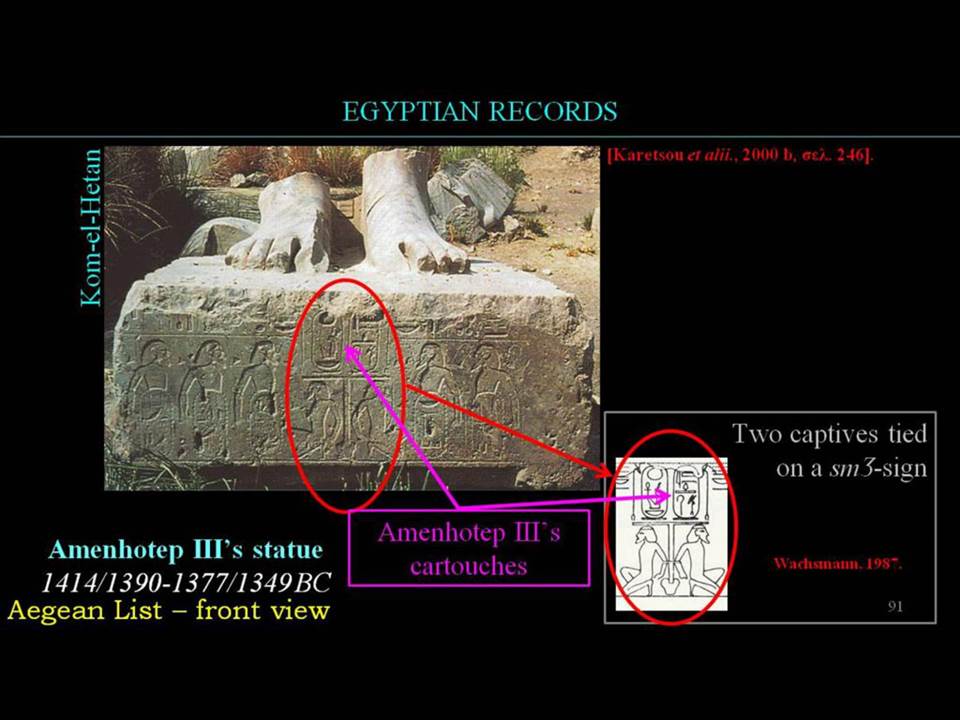
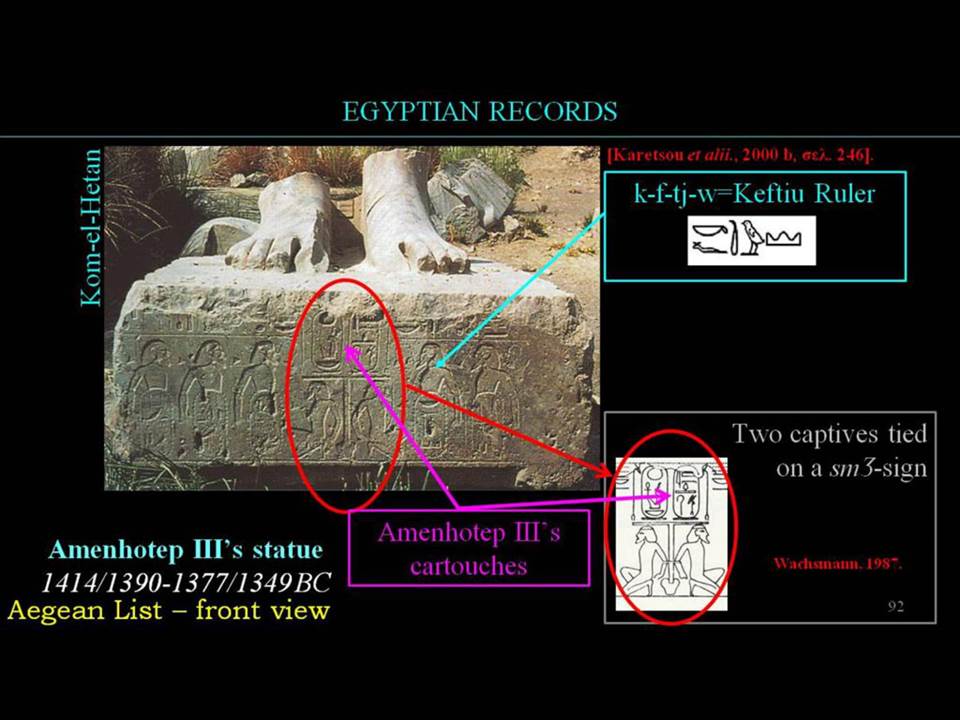
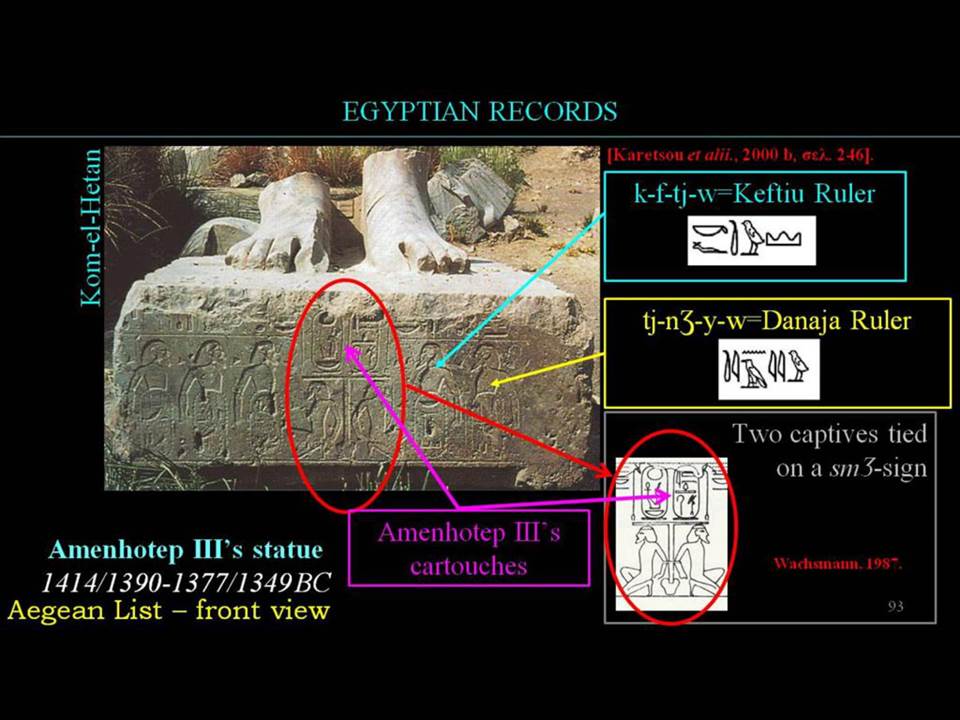
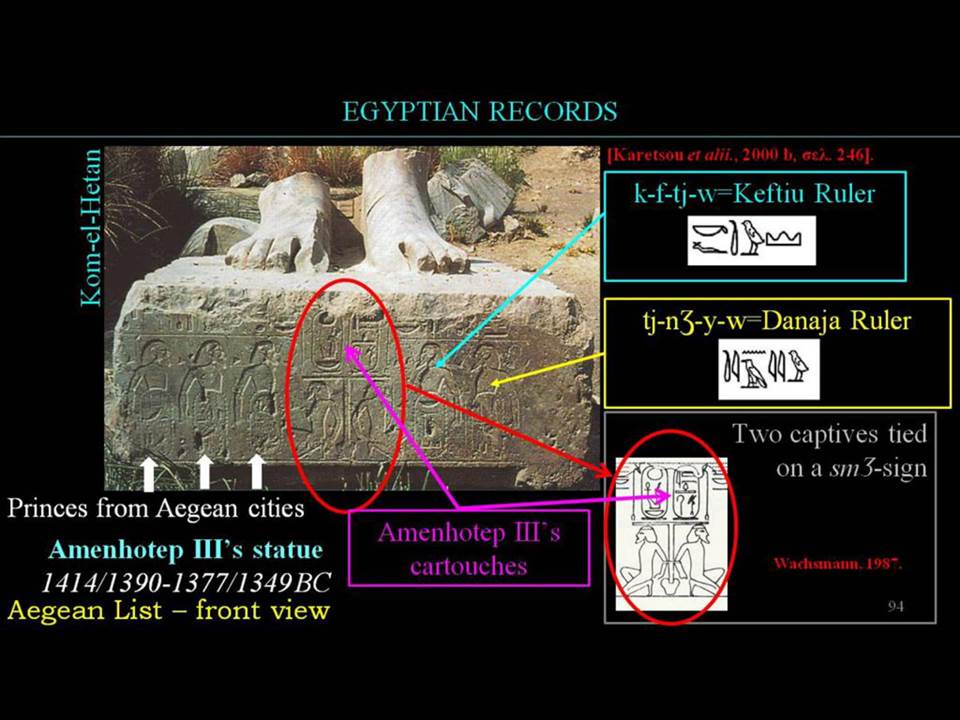
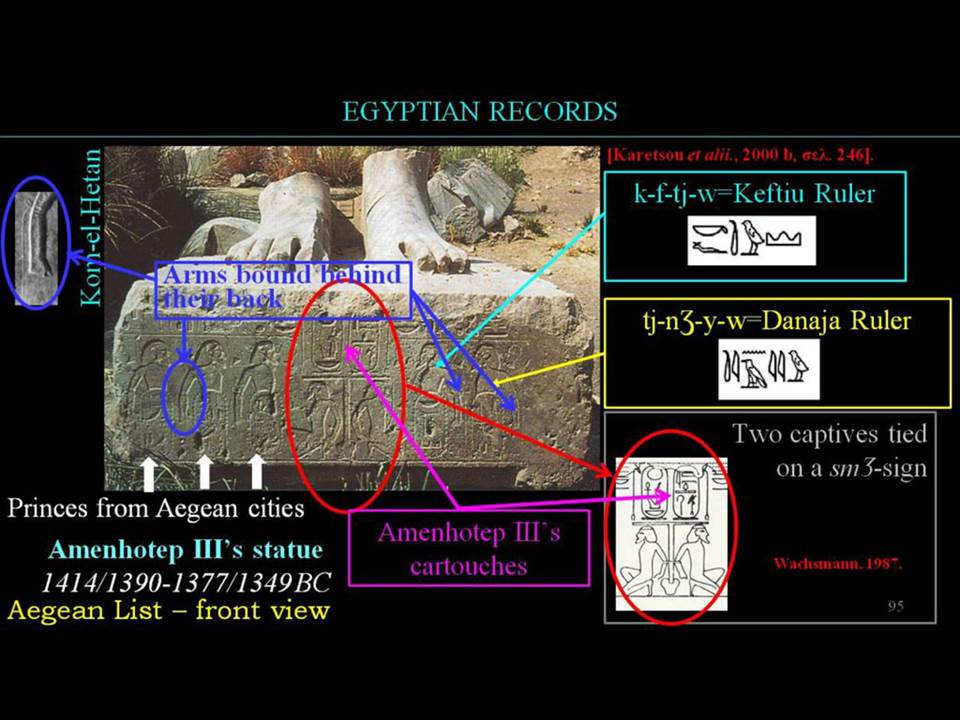
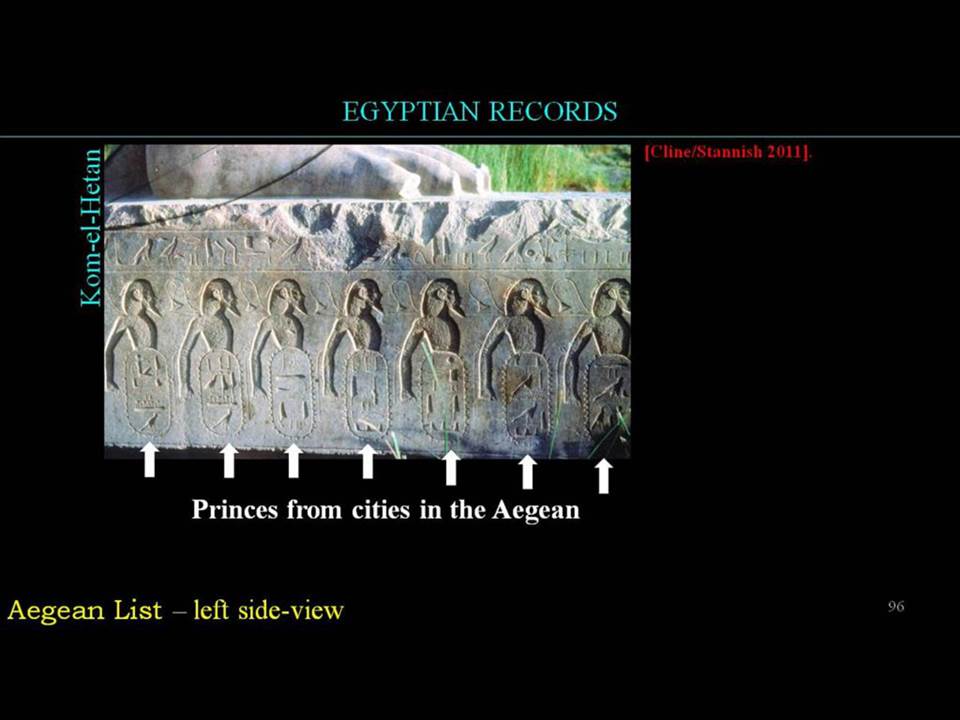
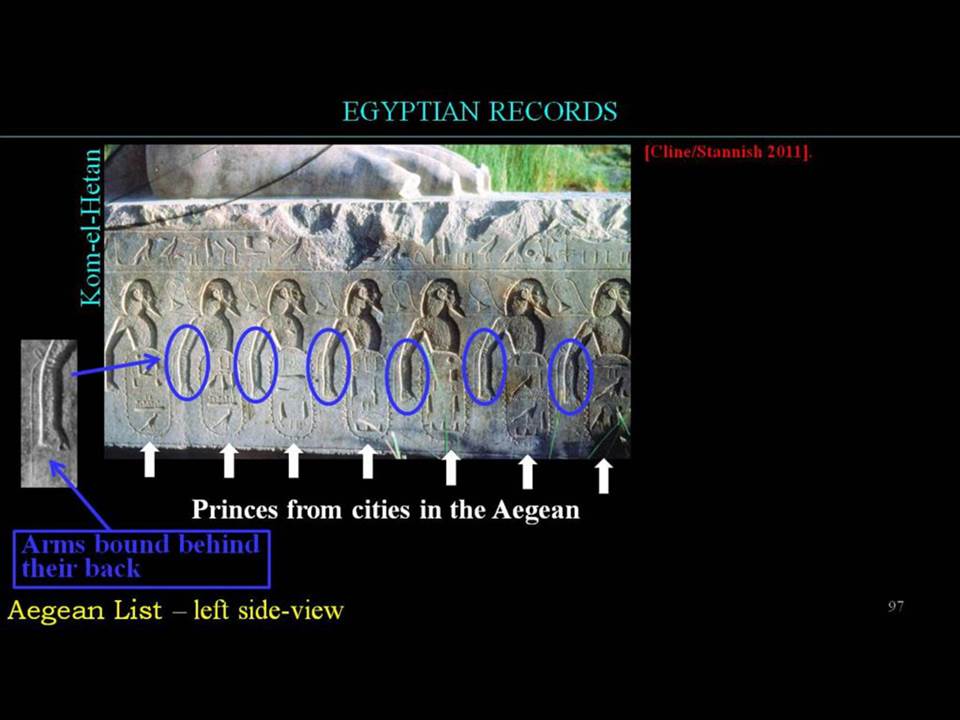
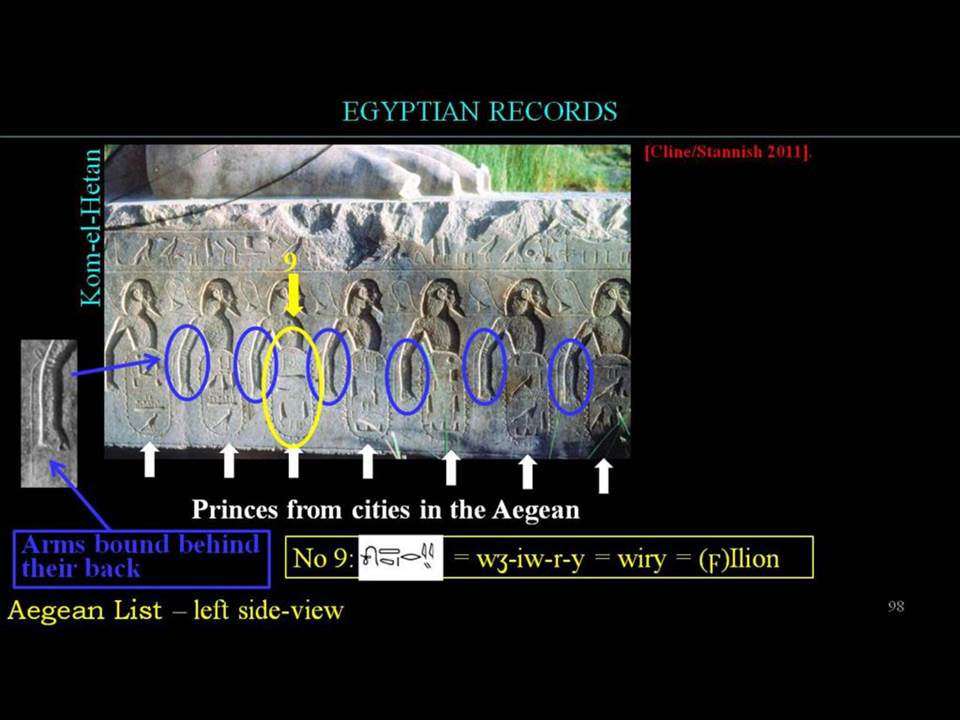
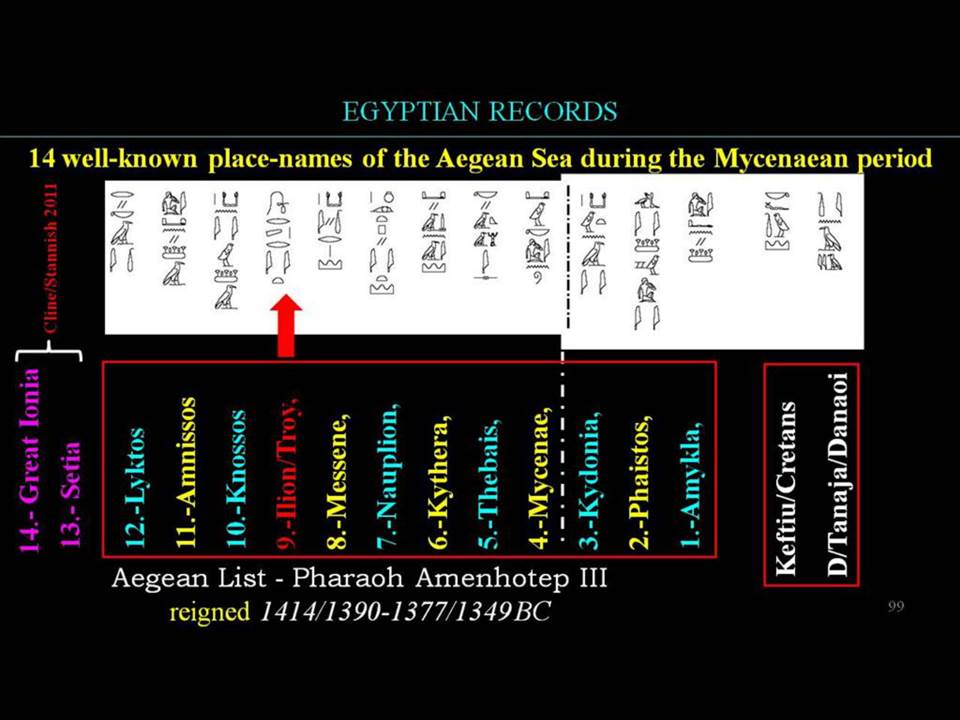
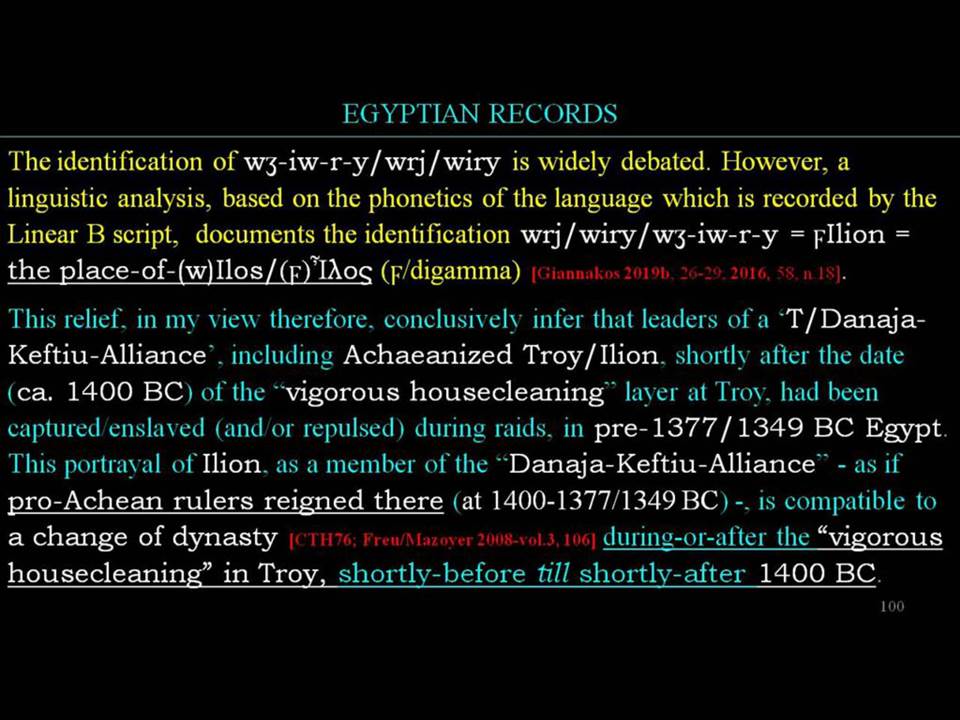
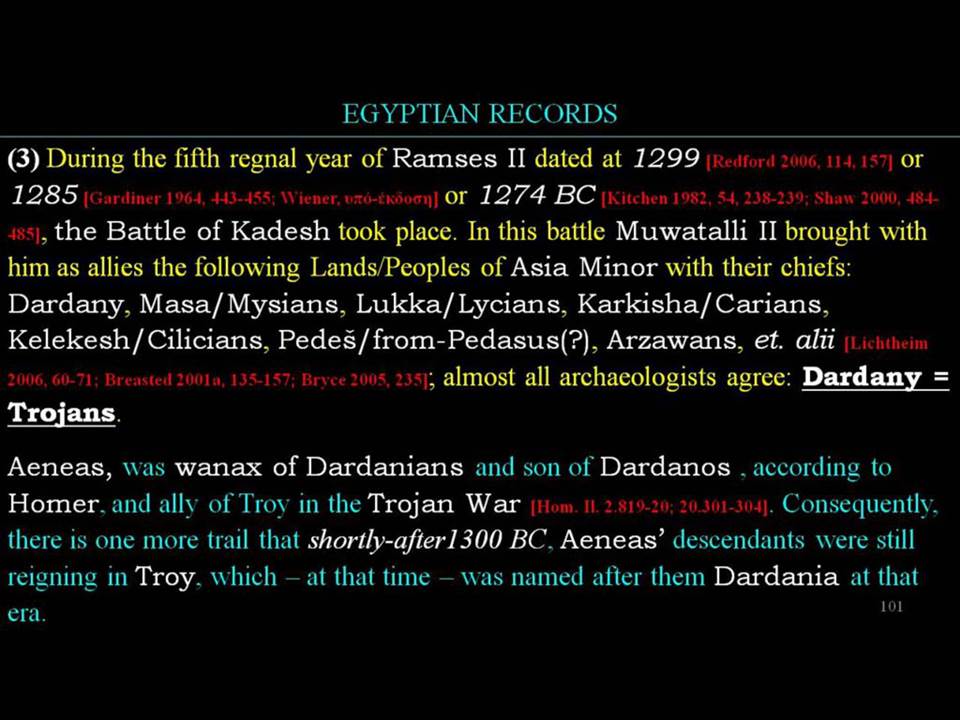
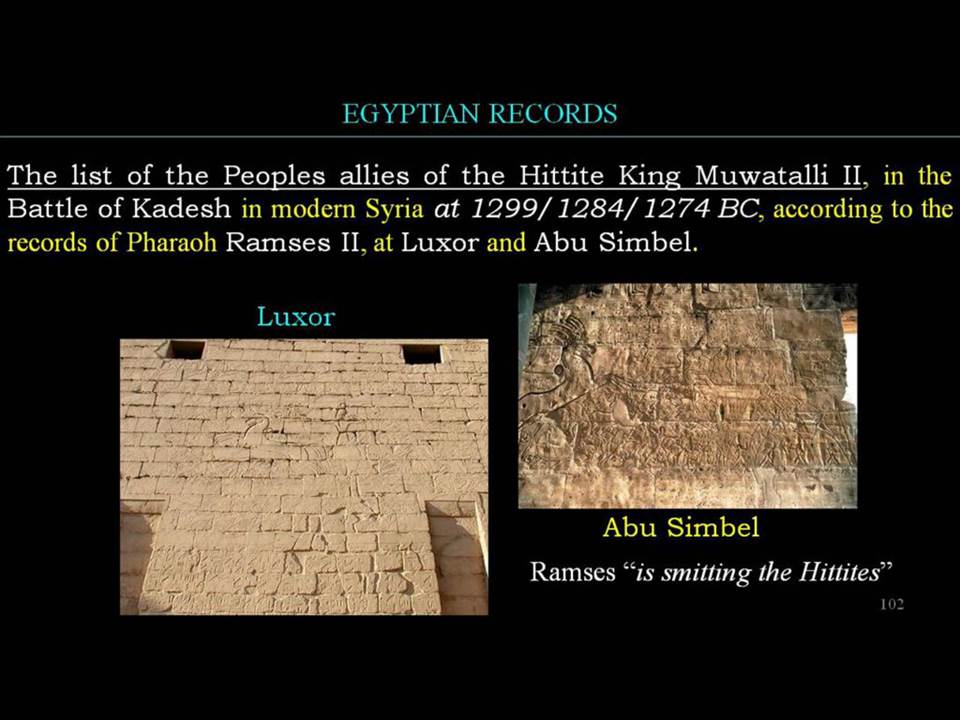
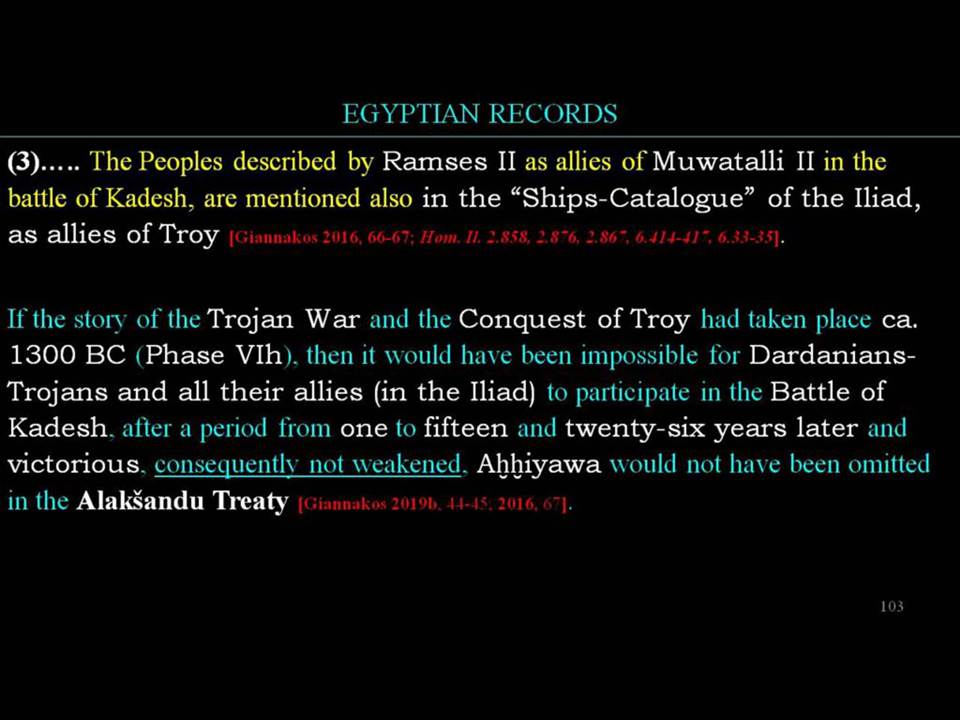
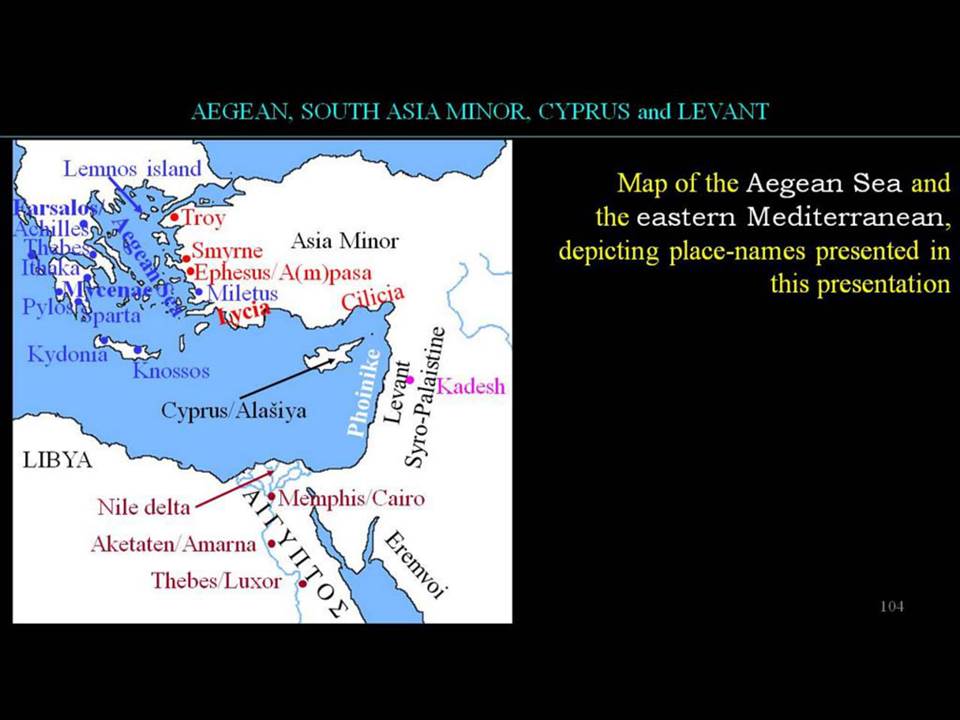
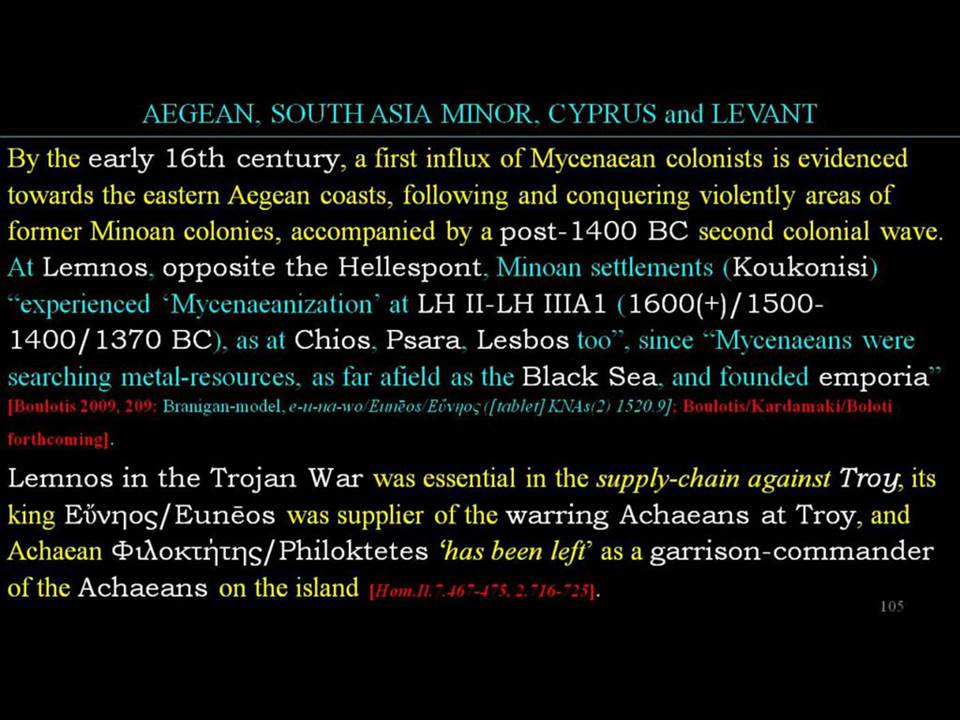
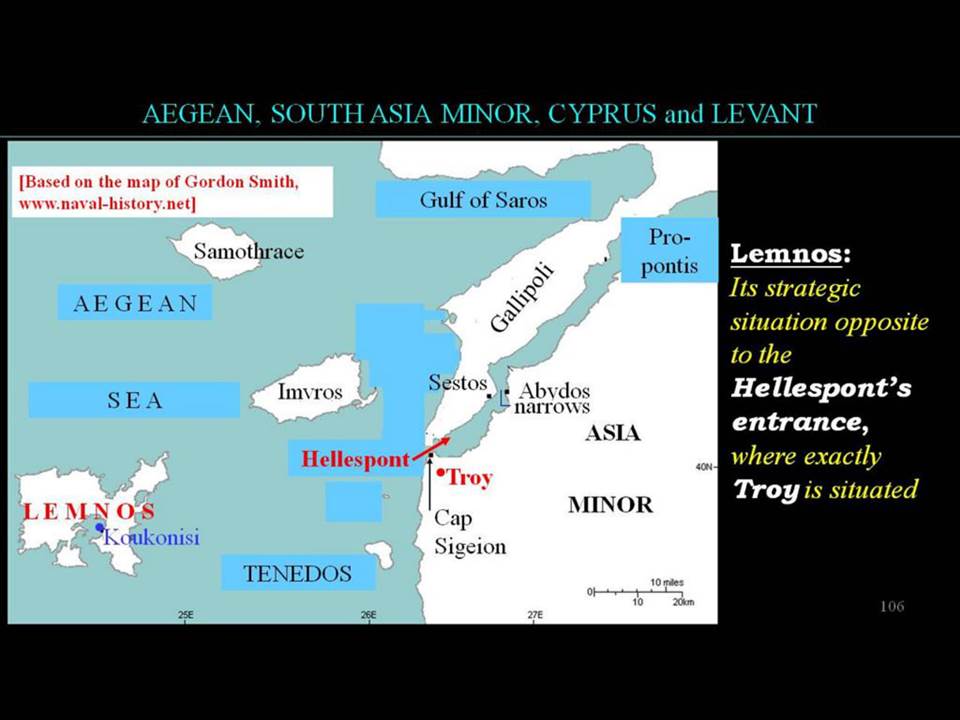
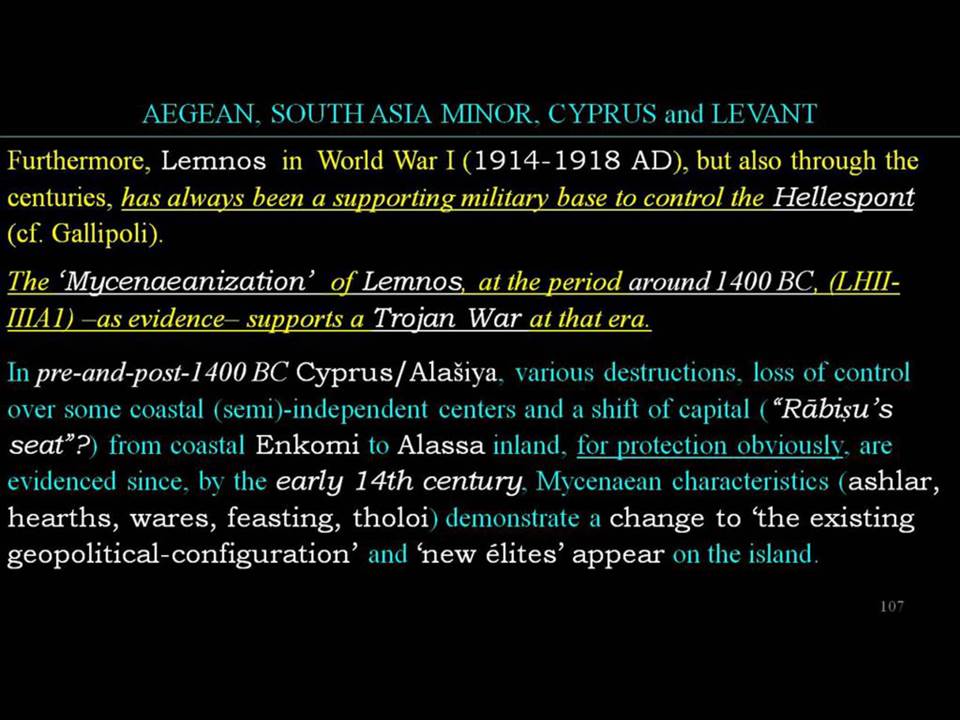
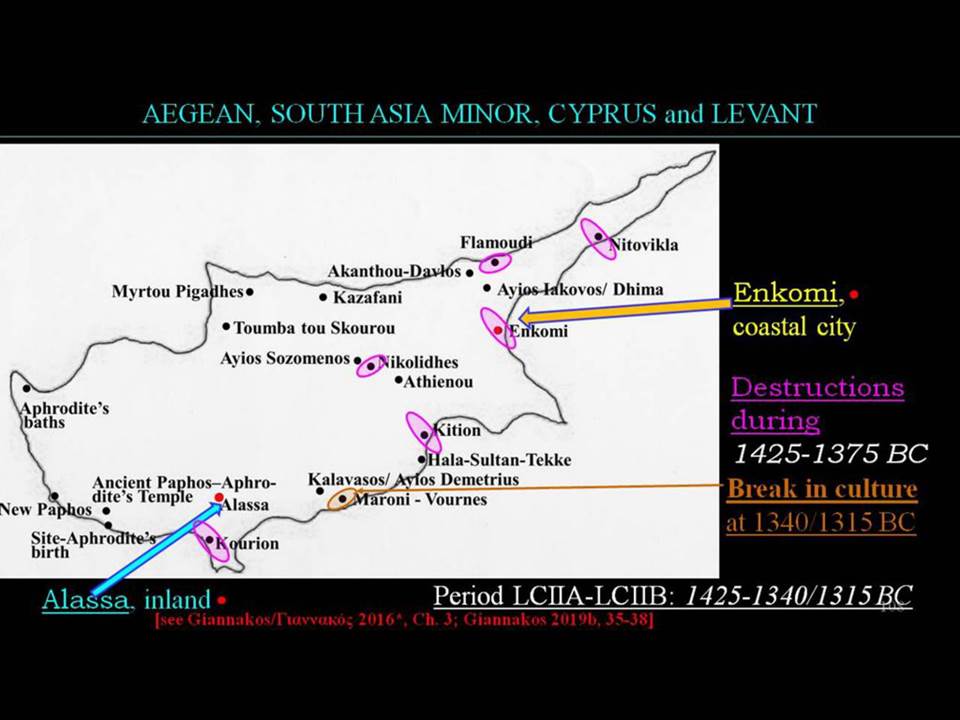
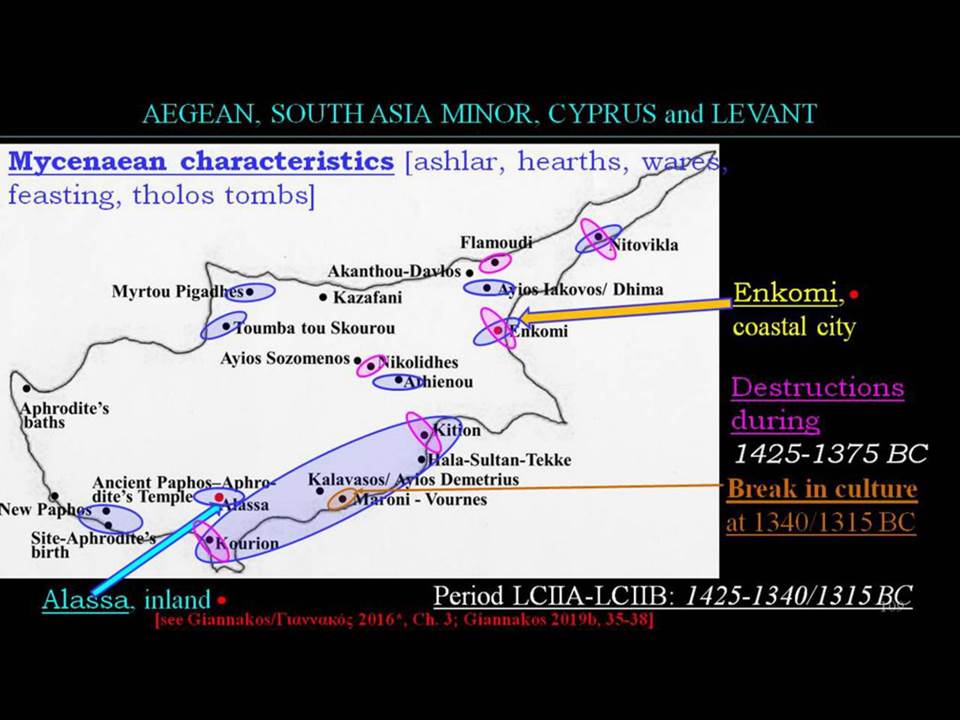
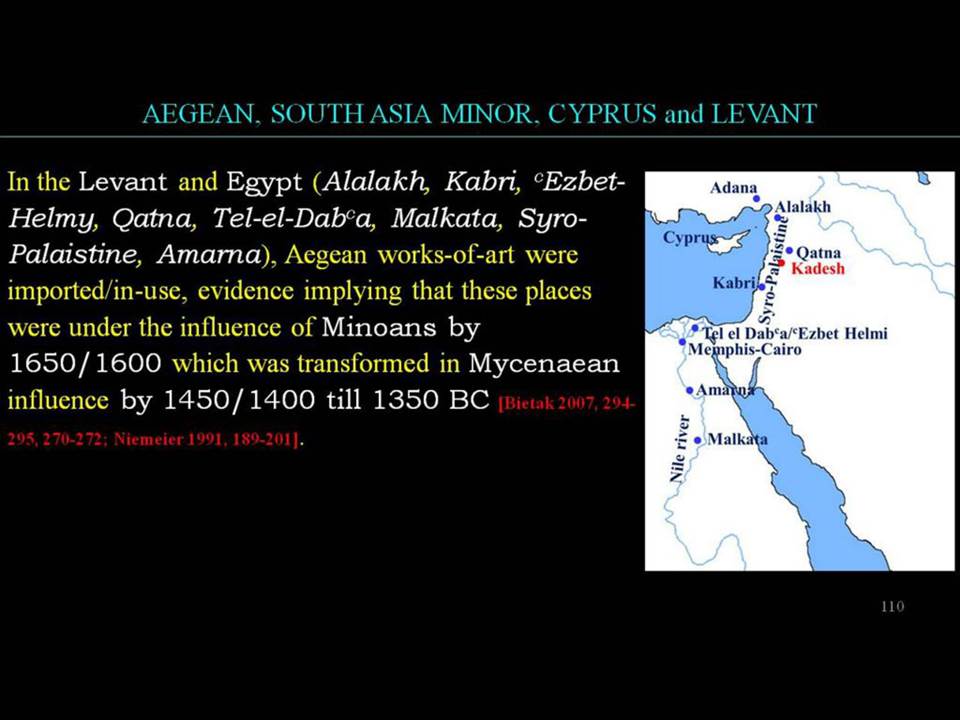
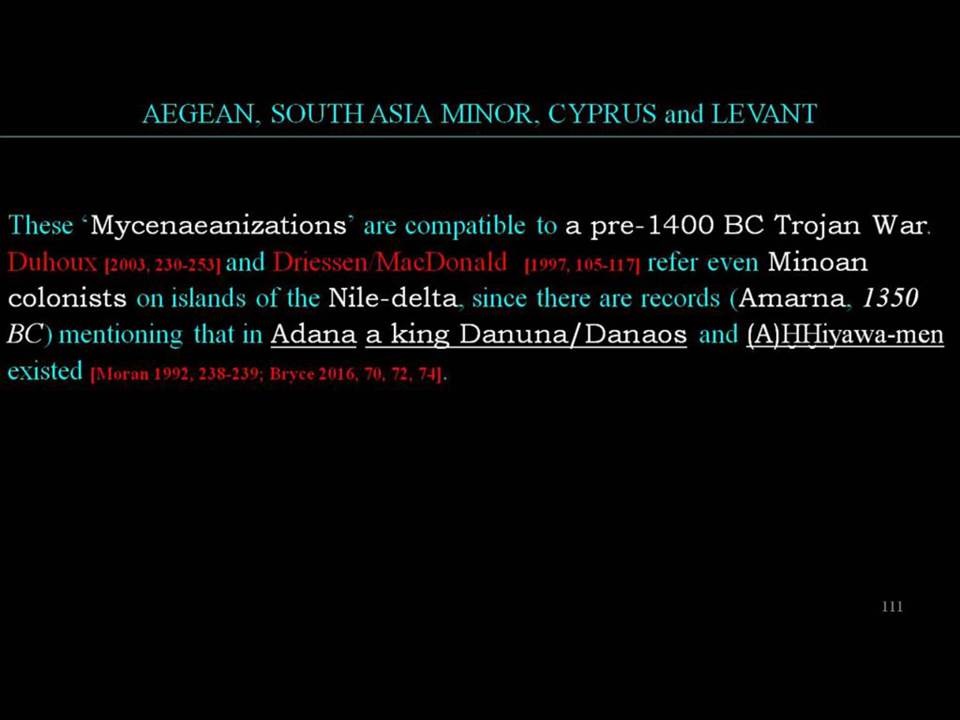
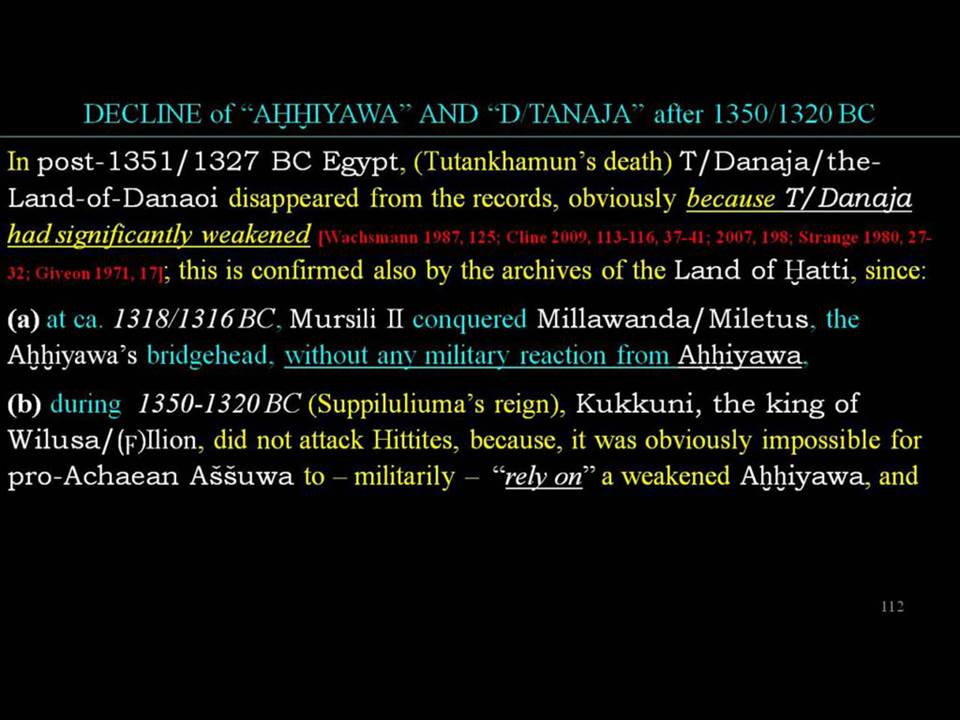
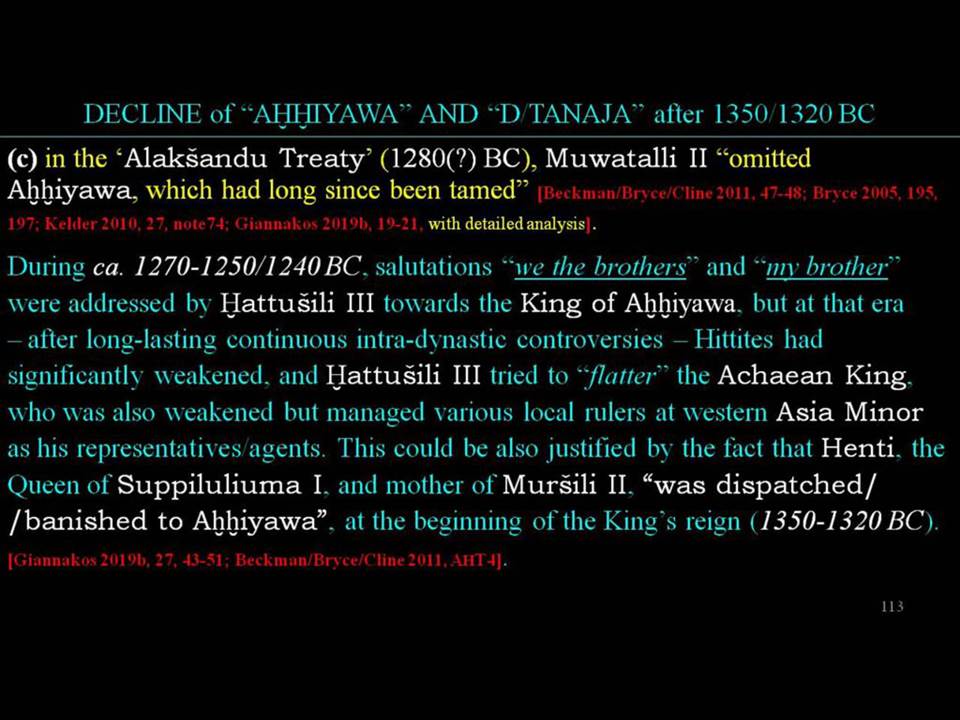
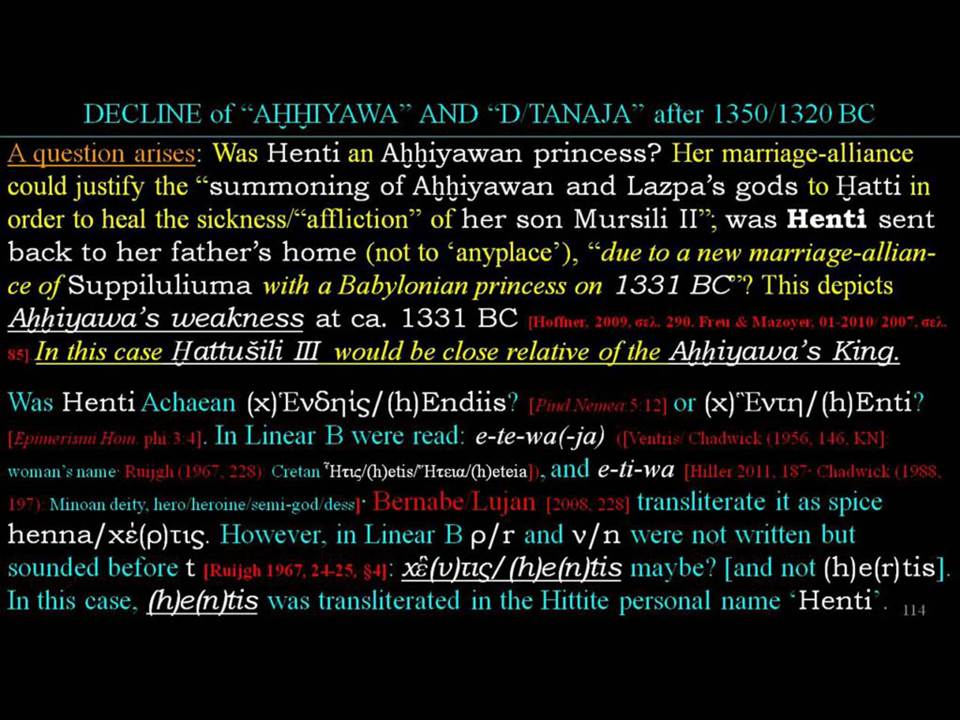
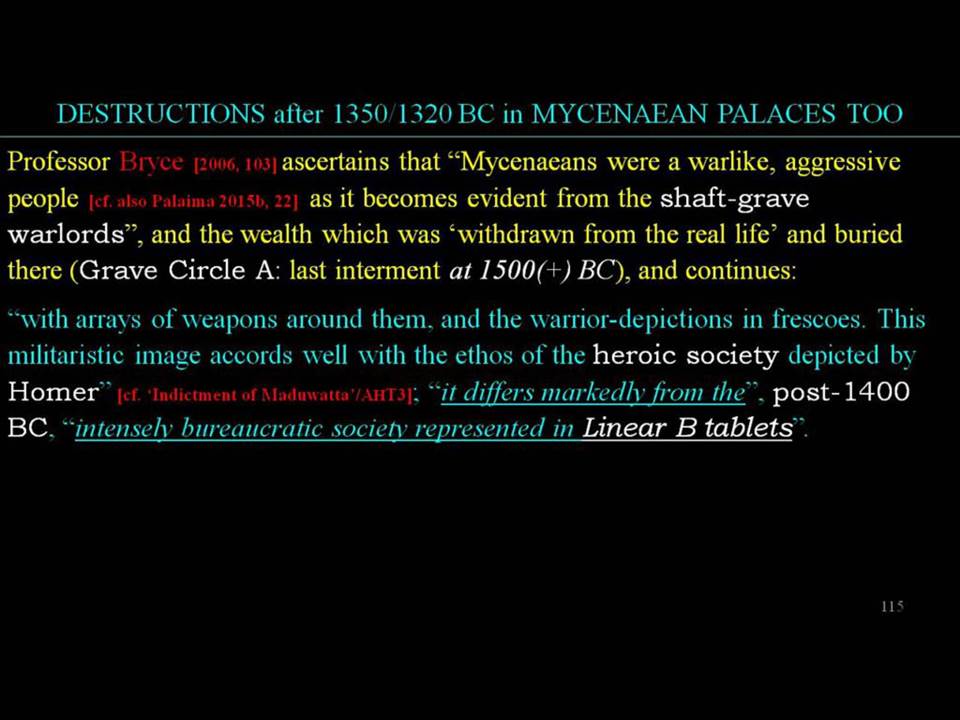
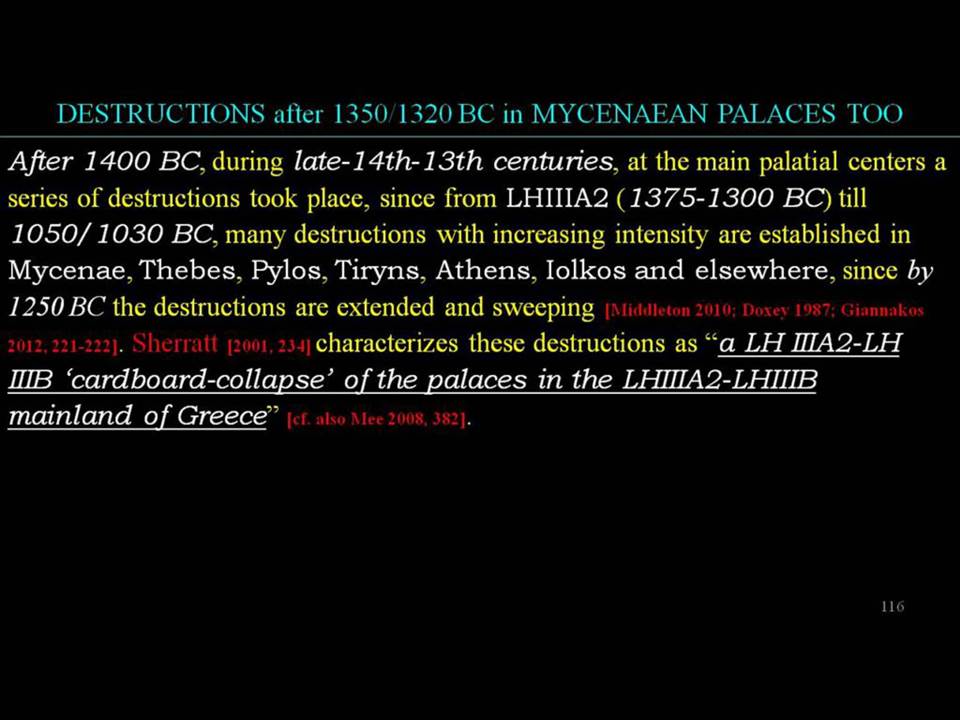
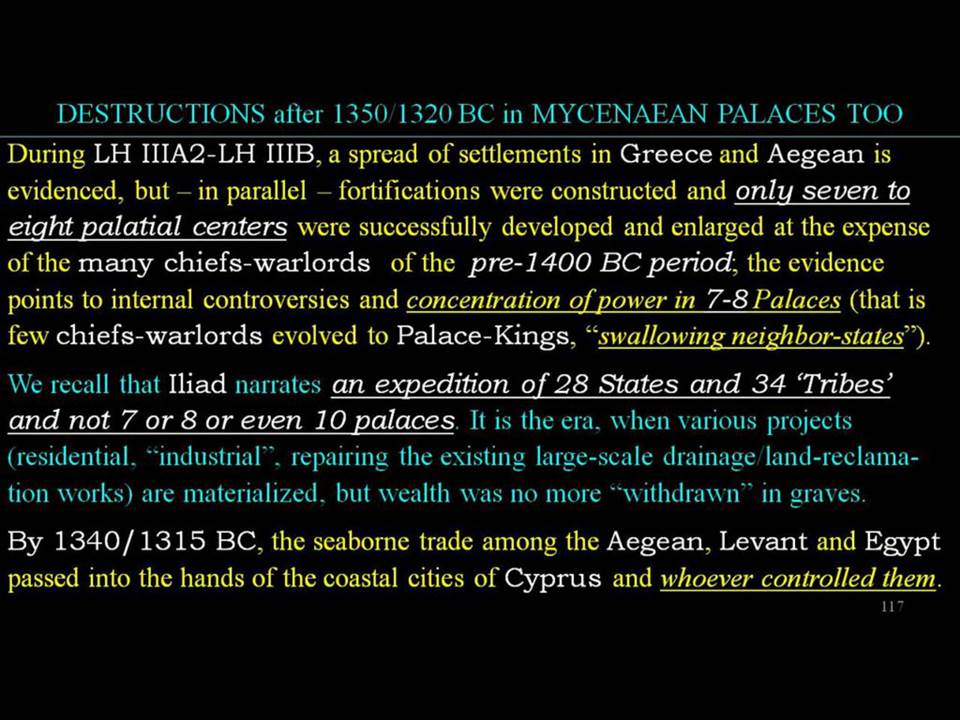
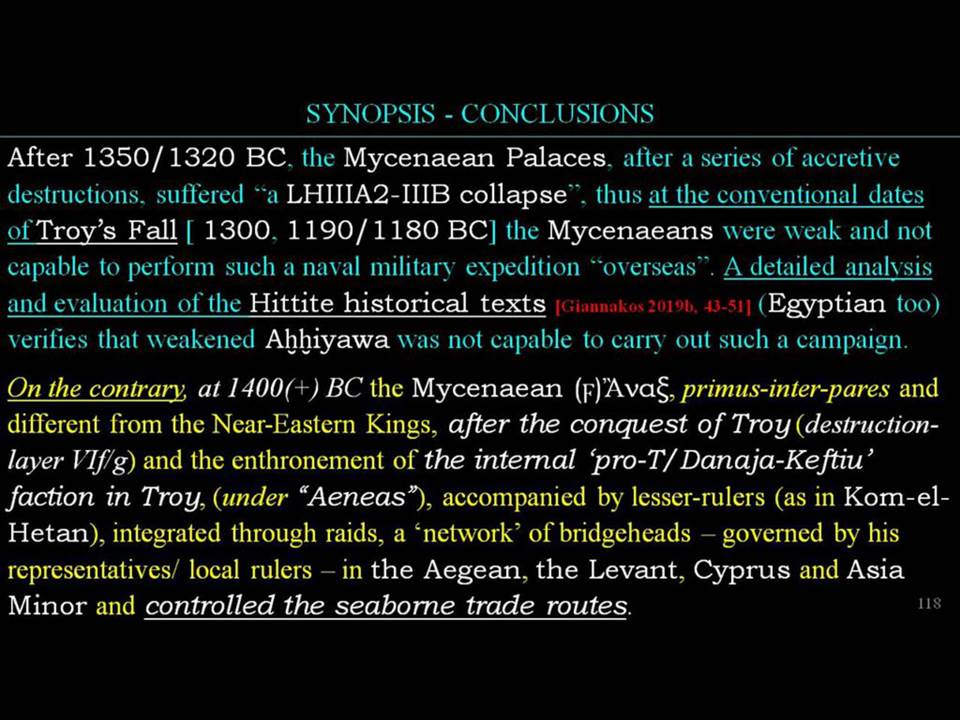
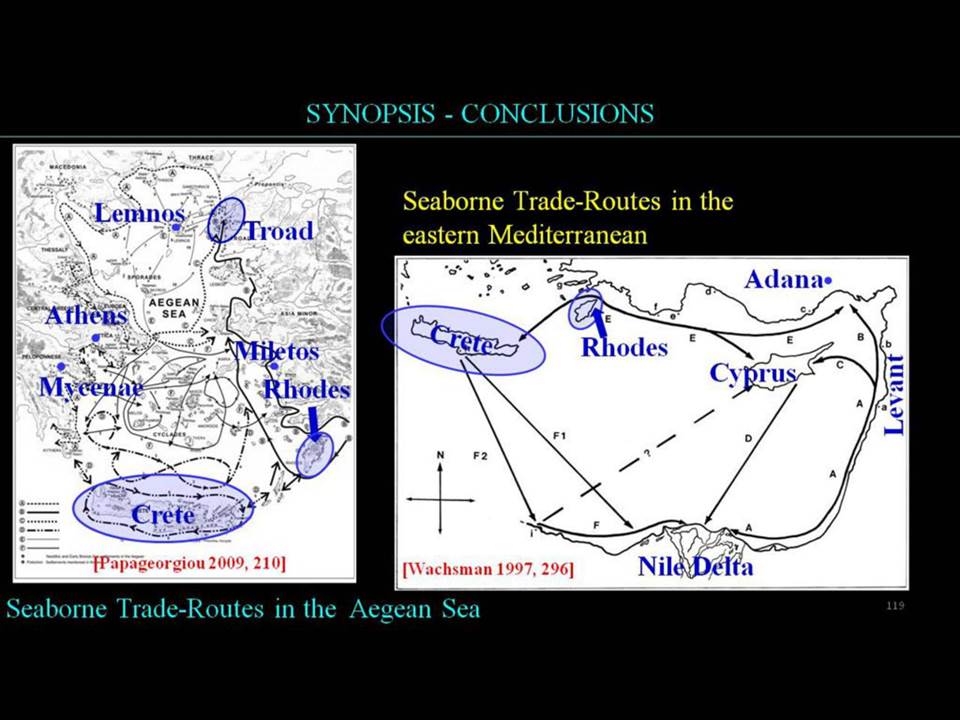
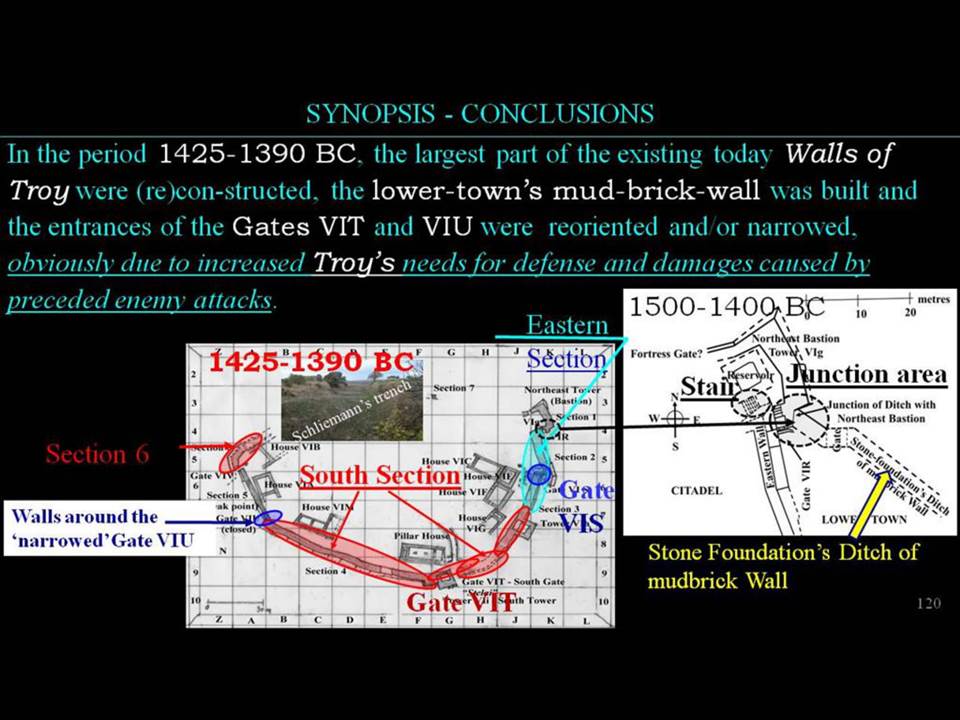
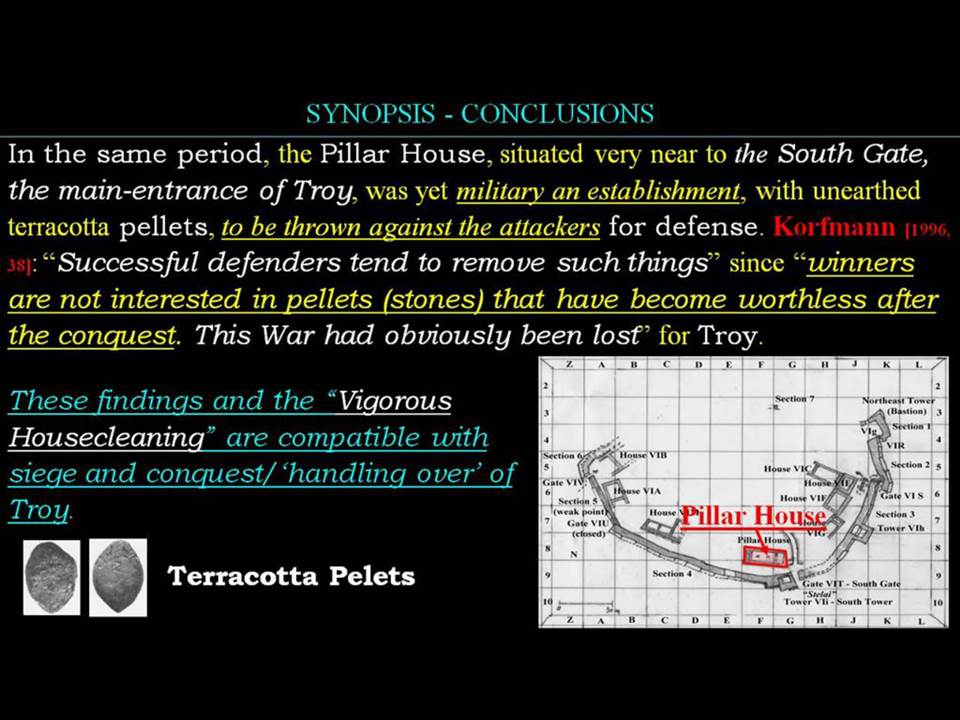
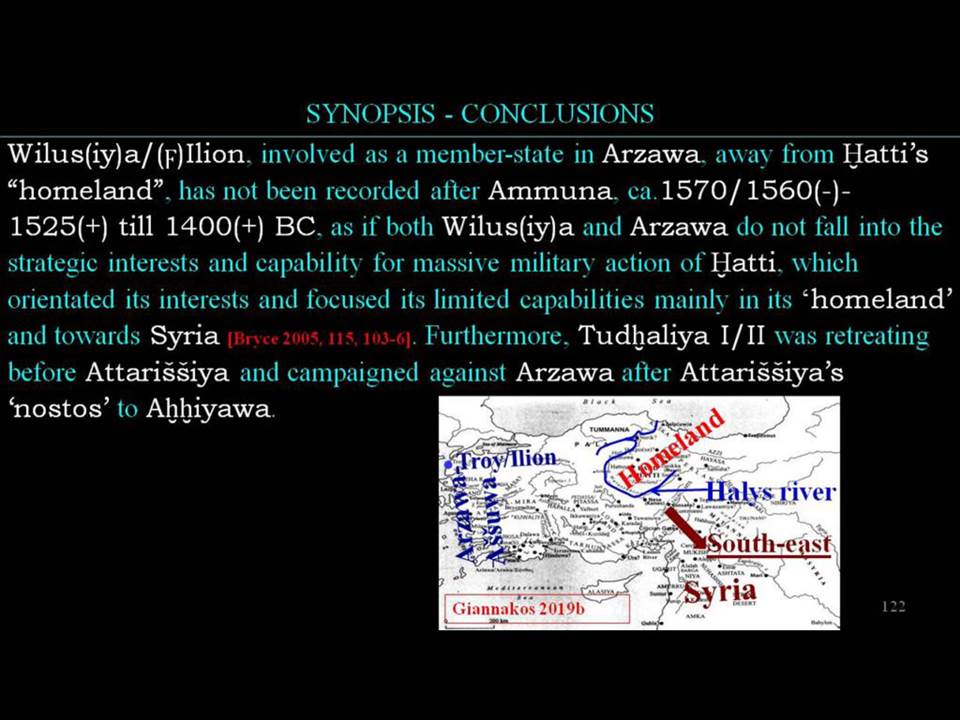
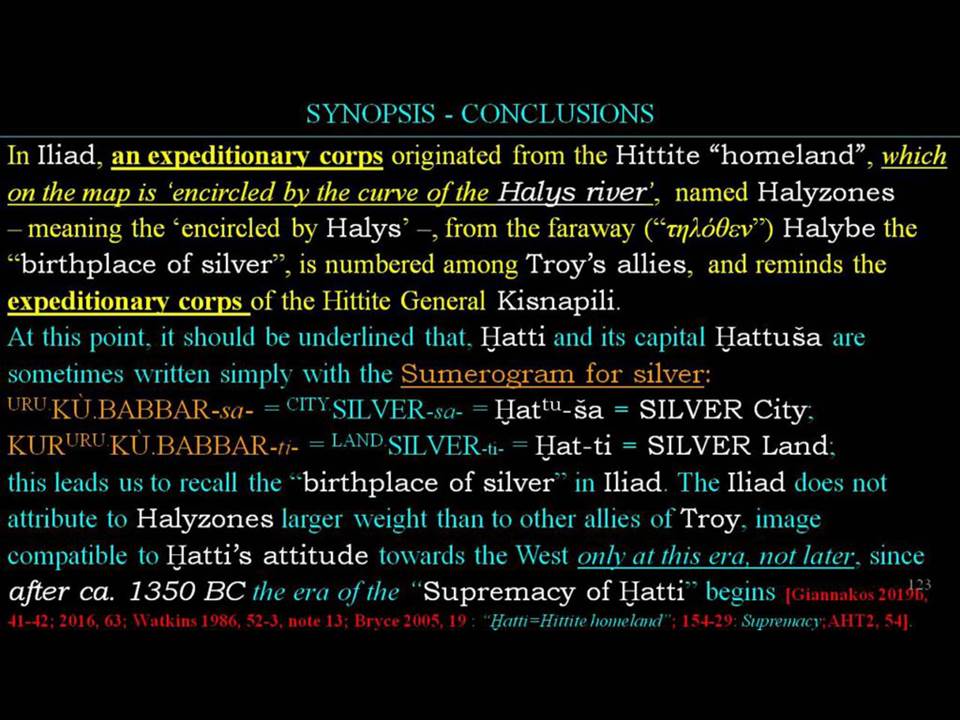
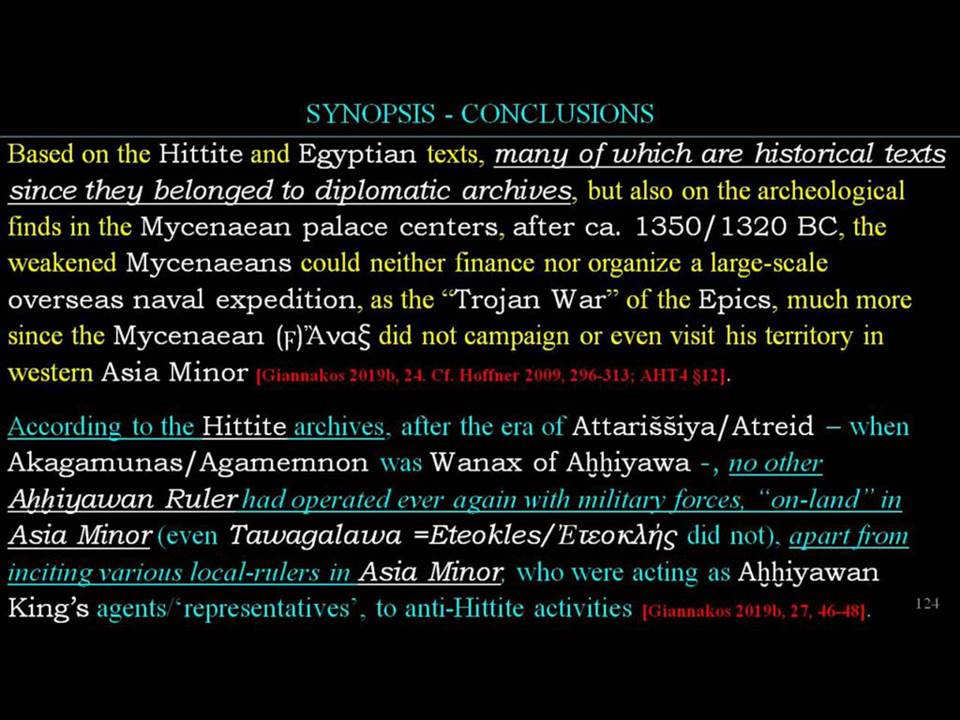
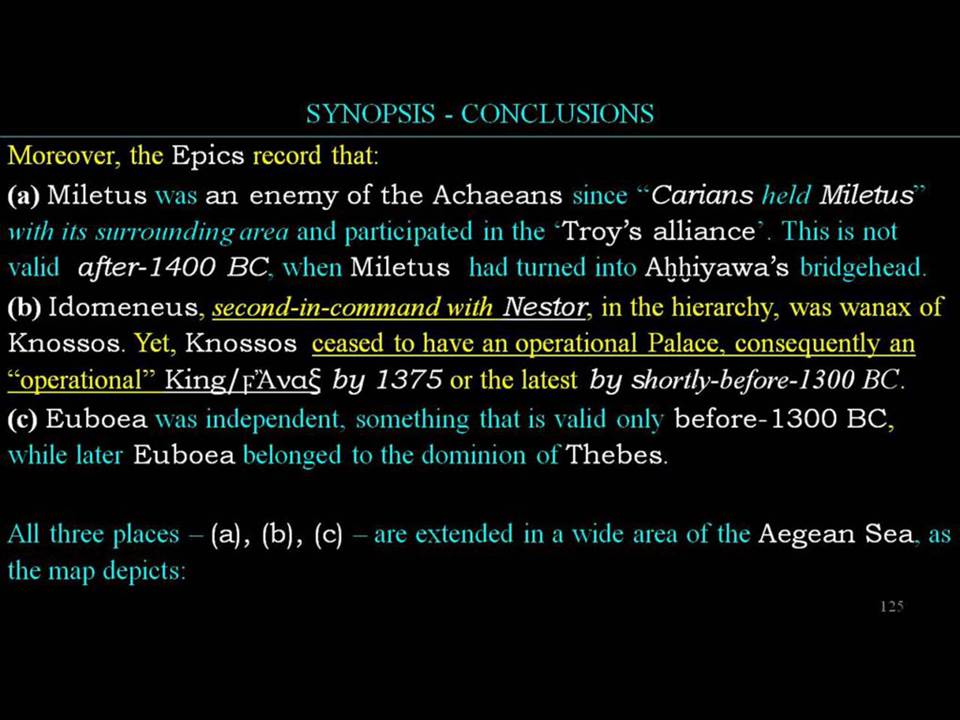
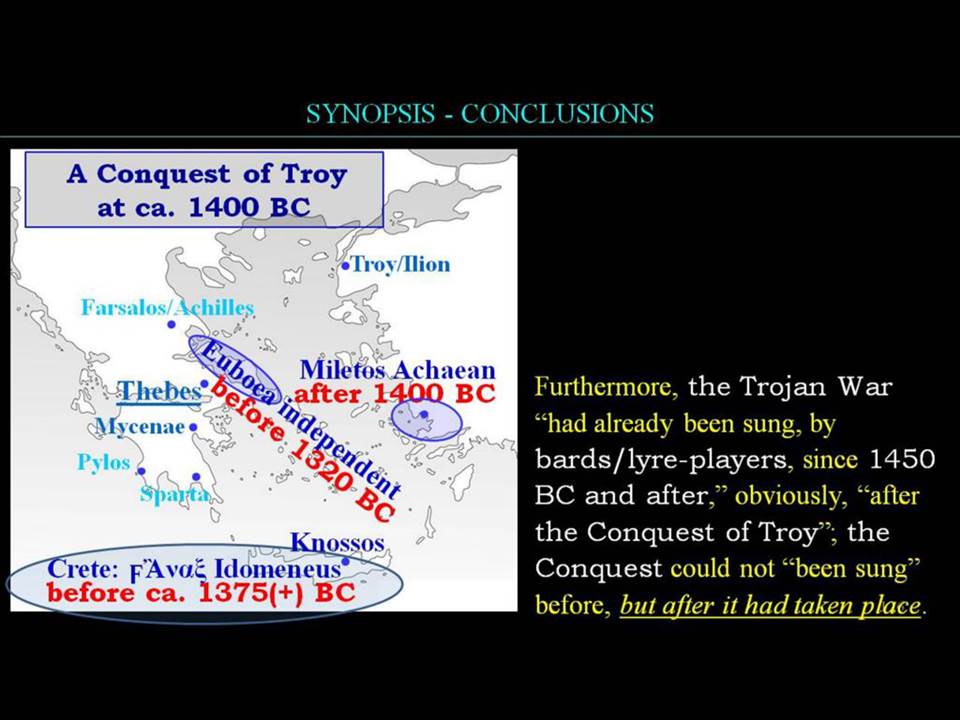
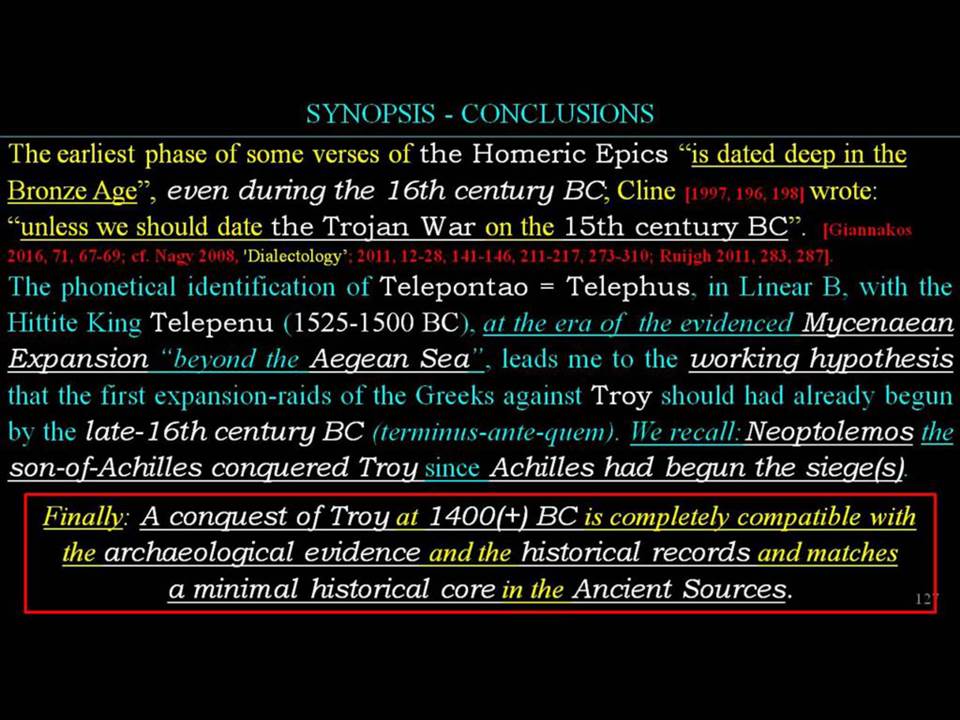
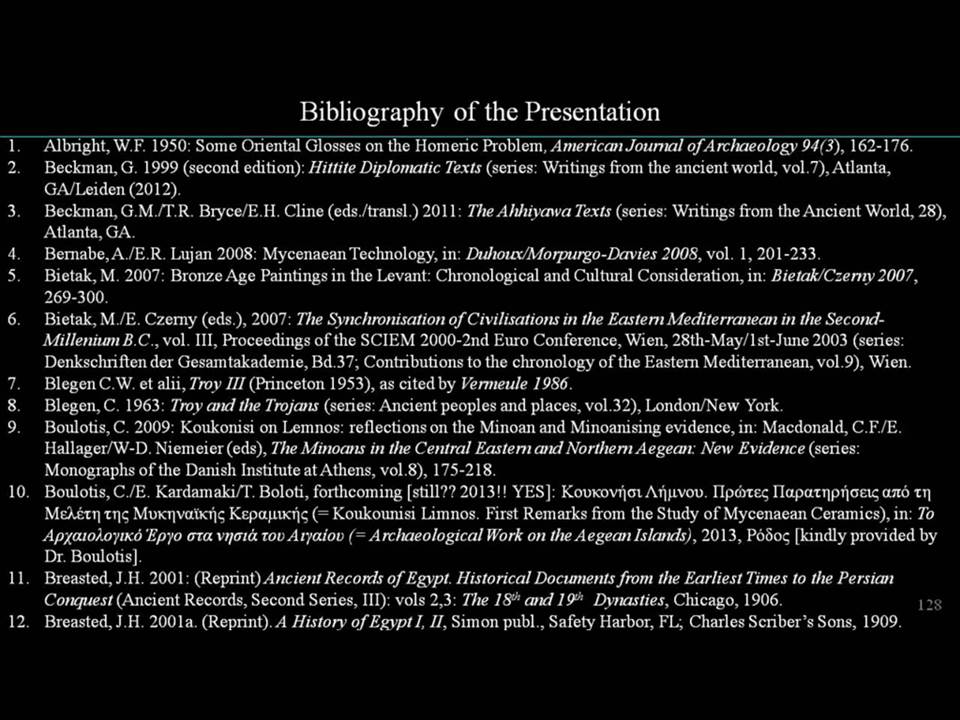
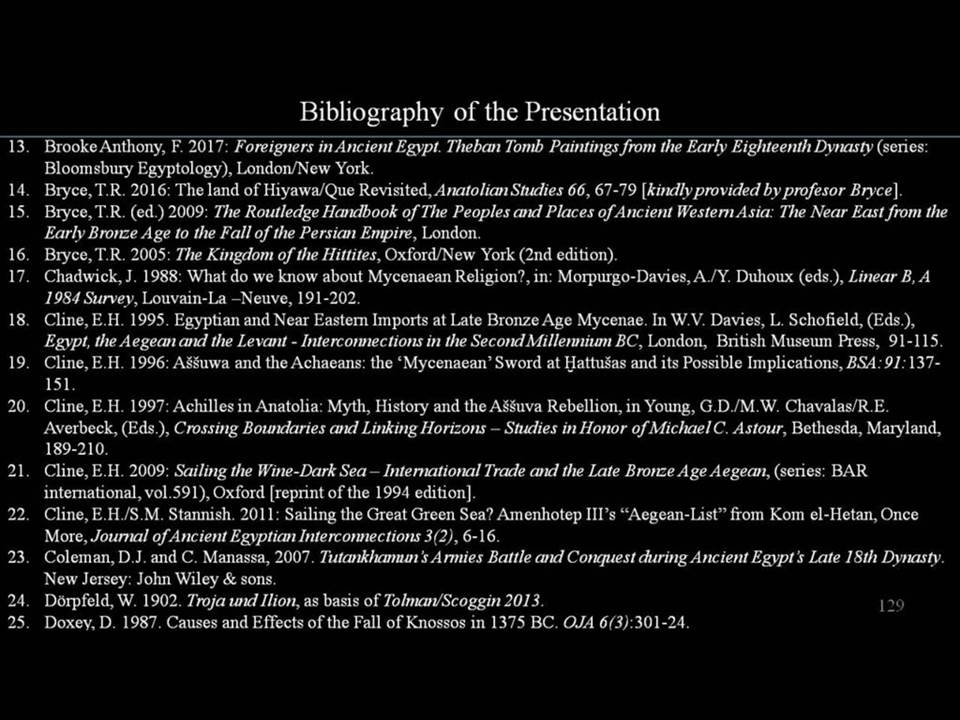
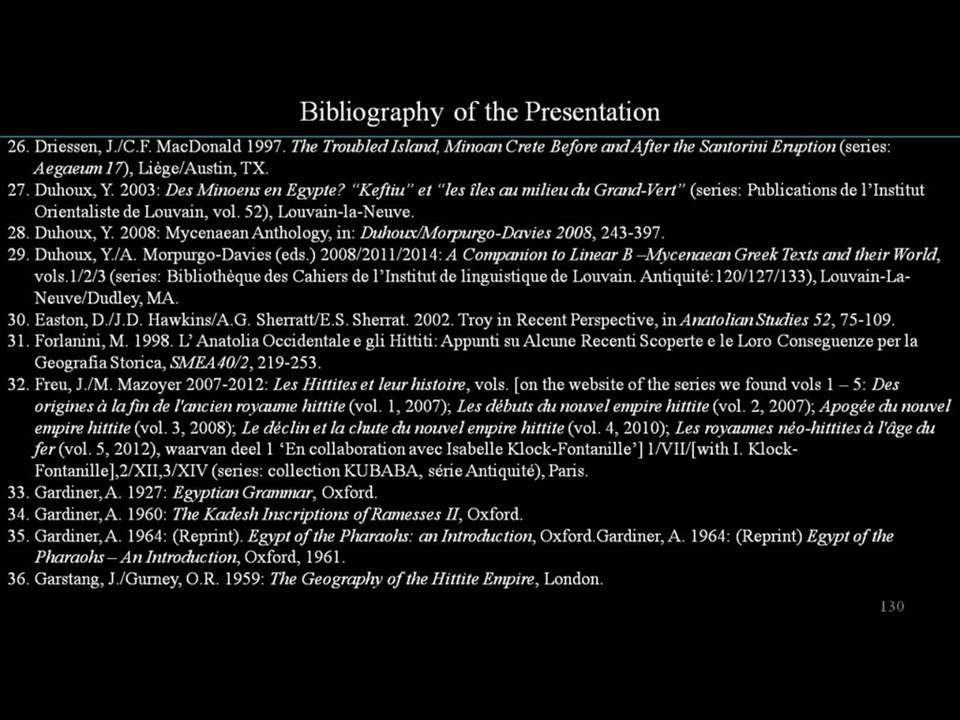
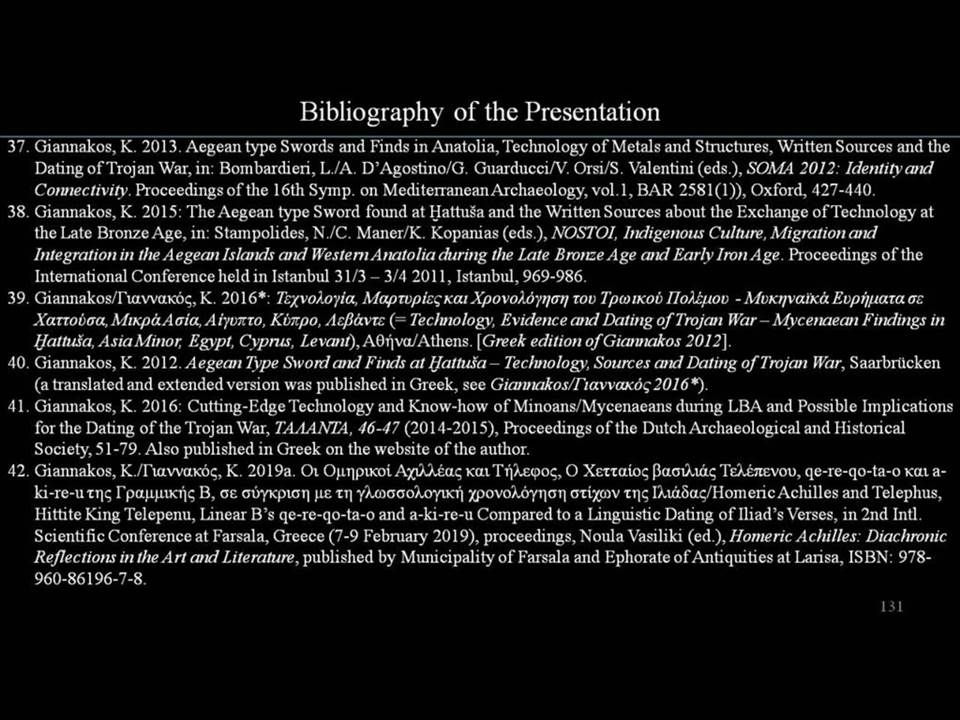
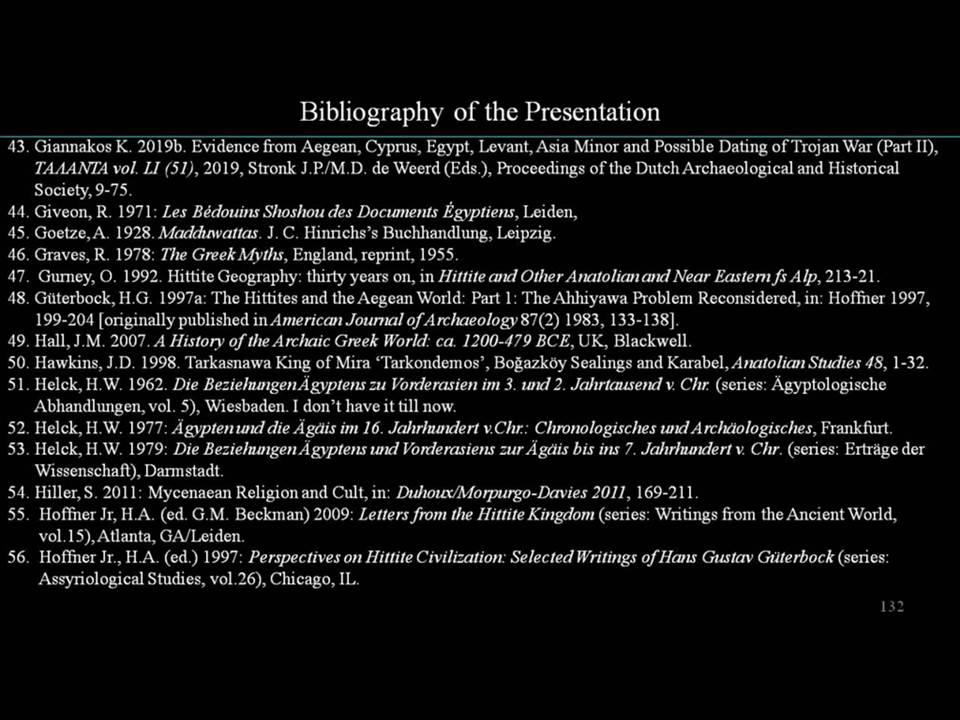
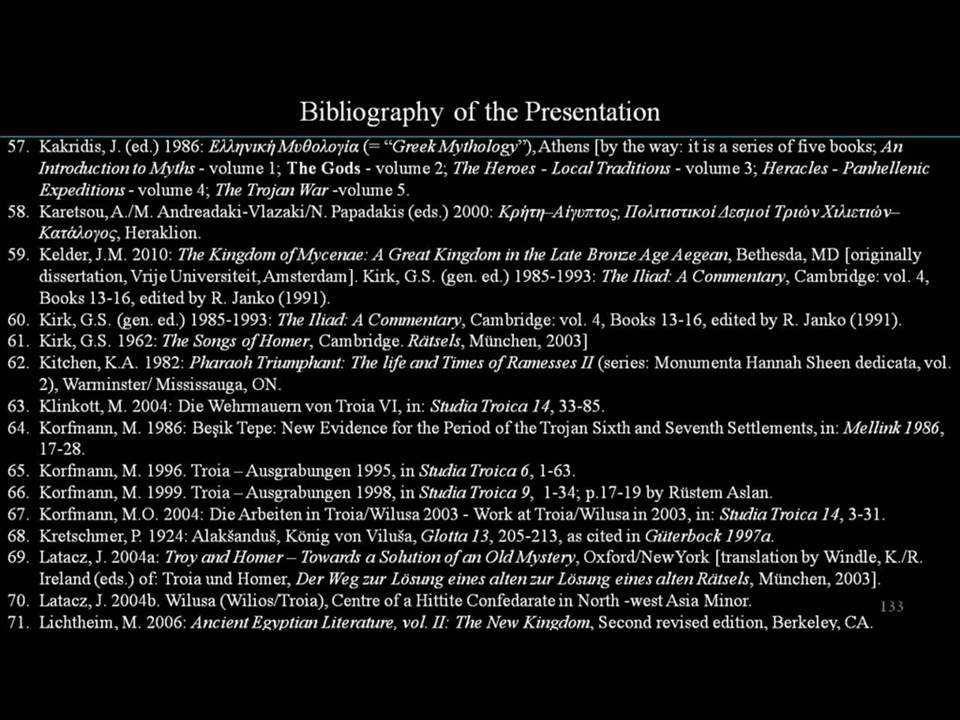
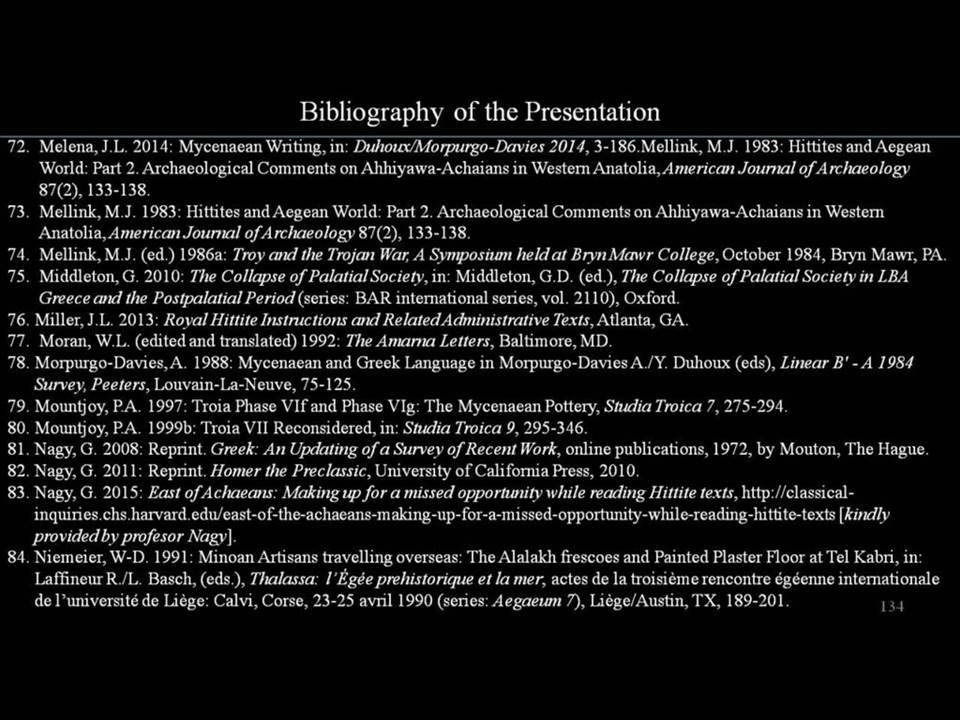
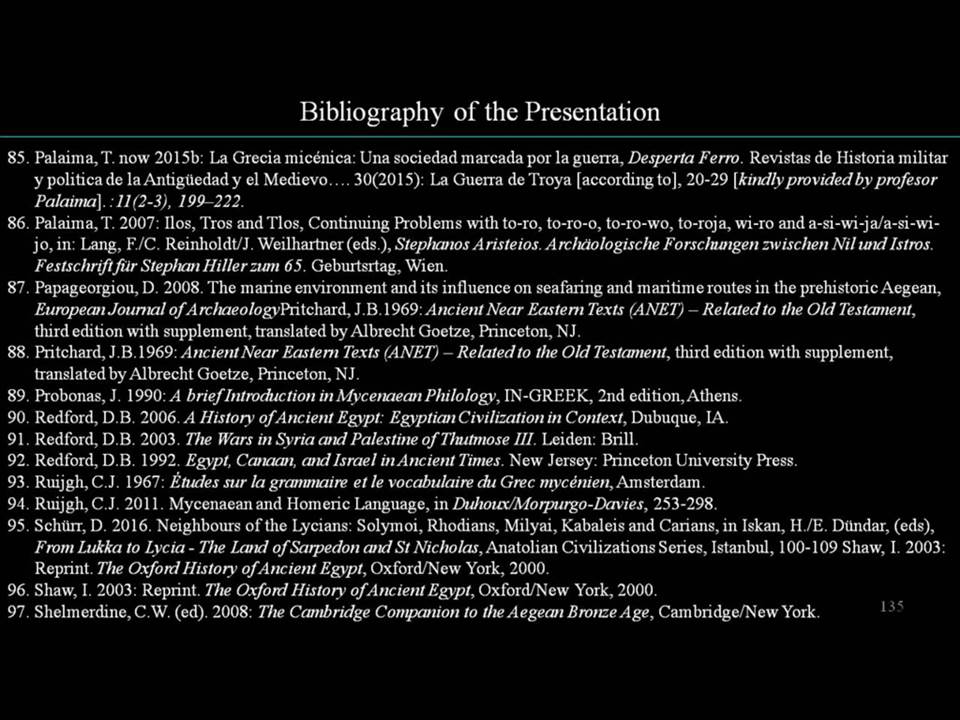
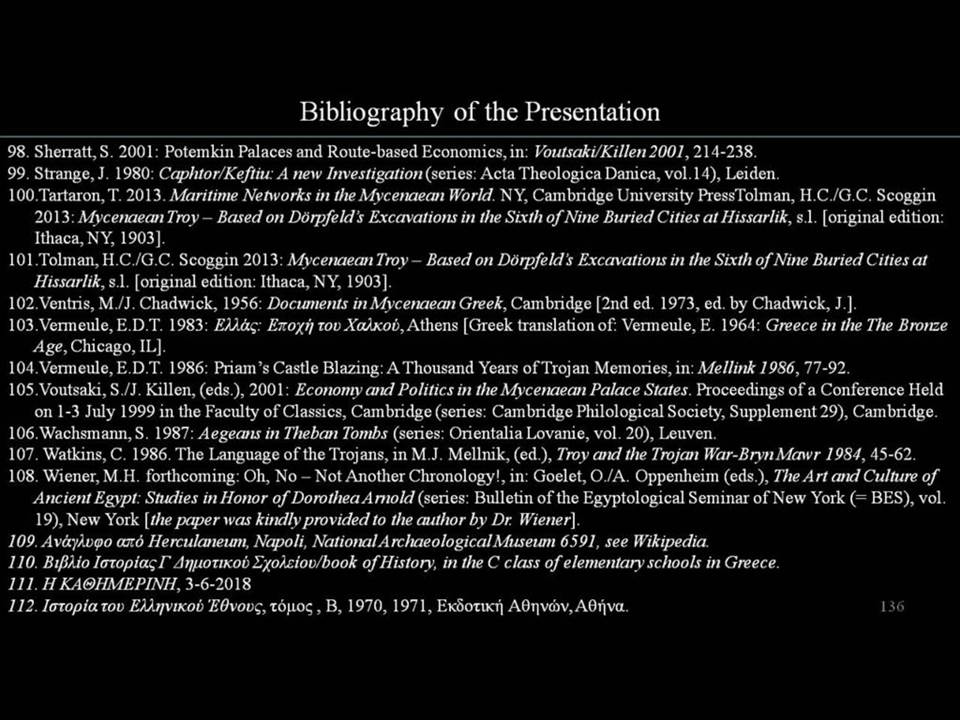
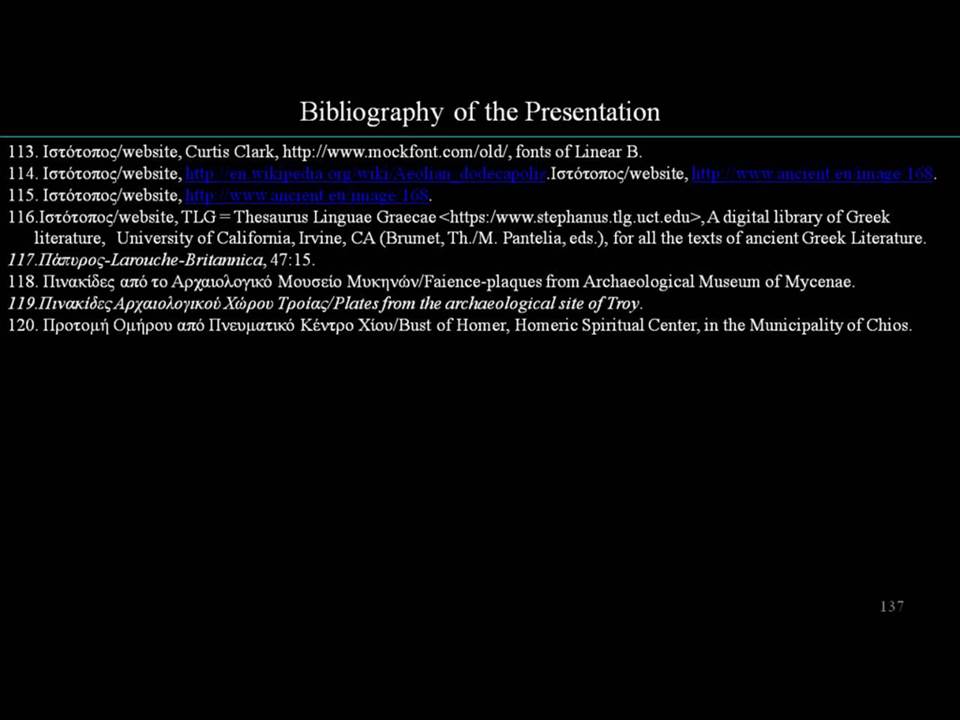
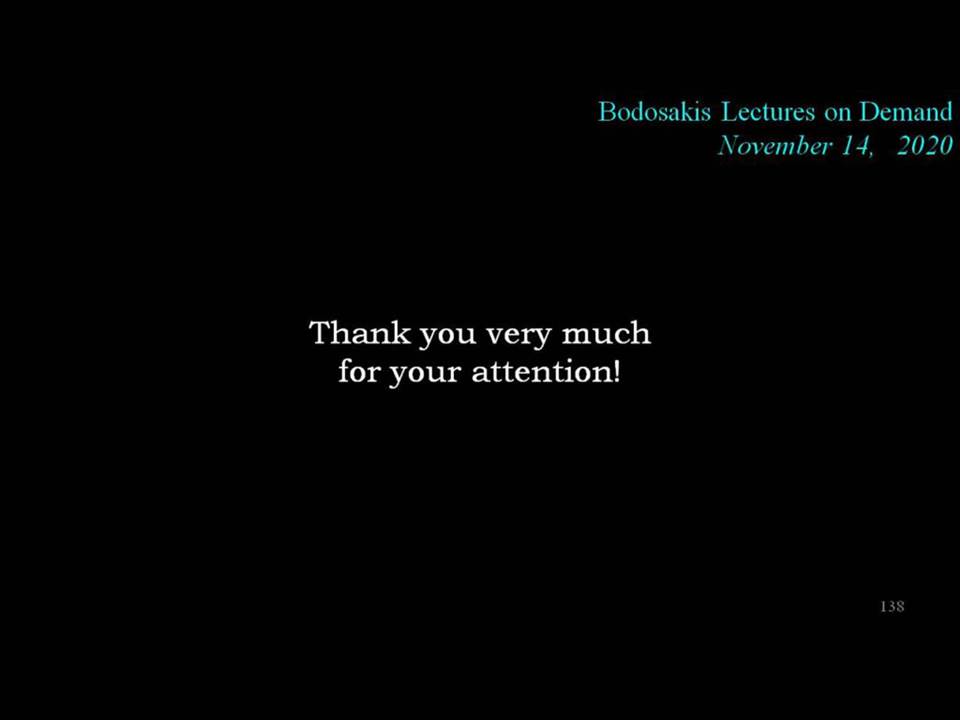
Giannakos S. Konstantinos
Γλώσσα
Αγγλική
Ημερομηνία
14/11/2020
Διάρκεια
00:54:32
Εκδήλωση
BLOD Web Lectures
Χώρος
Διαδικτυακή διάλεξη
Διοργάνωση
BLOD
Κατηγορία
Αρχαιολογία
Ετικέτες
BLOD Web Lectures, Τρωικός πόλεμος, Ιλιάδα, αρχαία ελληνική γραμματεία, έπος, αρχαιολογικά δεδομένα, αρχαιολογικά ευρήματα, Τροία
The Iliad, as poem, narrates fifty-one days of the tenth year of the ‘Trojan War’, since other texts of the ancient Greek Literature echo warlike operations against Troad, which allegedly occurred during an undisclosed period before the ‘Trojan War of the Iliad’.
The archaeologists consider the Epics as a tertiary source of information; can the archaeological data lead us to infer a conclusion about what happened at that distant time?
This presentation is based on the archaeological findings dated at the period 15th-13th century BC, which were unearthed in the regions of the Aegean Sea, Cyprus, Asia Minor and the Levant. These findings are analyzed and examined critically. Furthermore, the texts of the Land of Ḫatti and of the Egyptian records are related to the texts of the Linear B tablets from Greece, because combined they could lead us to determine the level and the period of Mycenaean power and influence abroad, but also the period of its decline. Moreover, findings from the destruction layers at Troy are examined, as they have been unearthed and evaluated by the Troy’s excavators (Schlieman, Dörpfeld, Blegen and Korfman), who merited the privilege to be the first (and unique in History, as it happens only once in every excavation, according to professor Christos Doumas), who came across the archaeological findings of the undisturbed yet layers in Troy. According to Blegen, since 1700 BC, Troy’s Wall-sections (especially the South Gate, the main entrance of the city) have been continuously constructed and/or redesigned, but it is only during the period ca. 1450-1390 BC, that all the preserved till today well-built Troy’s Wall-sections were constructed and/or reconstructed extensively, a fact which, combined with the “vigorous housecleaning”, points to external dangers e.g. siege and probable conquest at that era. On the contrary, by 1300 BC no extensive change of the Walls is attested; the structures of the newer two Towers VIi, VIh (12th century BC) were embodied inside the pre-existed mass of the Walls.
Do the Hittite archives refer an Atreid/Ἀτρείδη and an Agamemnon/Ἀγαμέμνονα, earlier than 1400 BC? Do the Egyptian records infer that, in the period between 1400 and 1377/1349 BC, pro-Achaean local rulers reigned in Troy? Did it happen that Troy was not destroyed completely but, as the Aeolian tradition narrates, the victorious Achaeans had enthroned a pro-Achaean dynasty in Troy (‘Aeneas’ and his successors) around 1400 BC? What image emerges from the archaeological finds in Cyprus, in the Levant and in the eastern Mediterranean in general?
KONSTANTINOS S. GIANNAKOS [Civil Engineer, dipl. NTUA, PhD AUTh, P.E., Fellow of the American Society of Civil Engineers (ASCE)], “is leader in railway engineering, with pioneering research on the ballast-sleeper fastening system” (extract from ASCE-news Nov. 2012).
With more than 20 years of research involving laboratory tests, on-site investigations and theoretical analyses, he has developed theoretical approaches for: (a) calculating the actions on railway track, both ballasted and slab-track, and its subsequent deflections, (b) determining the track-mass participating in the motion of the Non-Suspended Masses of railway vehicles, and (c) predicting the ballast fouling for certain types of concrete-sleepers. All his theoretical approaches have been verified by observations and measurements in railway tracks in operation. He has numerous publications in scientific journals and conference proceedings; he has served on a number of European Union committees, and in 1999-2001, as representative of Greece, he participated in the composition of European Union’s Technical Specifications of Rail Infrastructure for High-Speed Lines and signed the official text.
From 1998 to 2002 he was the general coordinator of the group within the International Union of Railways/UIC concerned with High-Speed rail in southeastern Europe, and from 2002 to 2006 he was the chief executive officer and vice-president (2002-2003) and president (2003-2004) of the Hellenic Railways Organization/OSE (the period of the Olympic Games in Athens included). He was visiting/adjunct professor of railway engineering at University of Thessaly, Civil Engineering Dpt., Volos in Greece during the period of 2007-2014. In addition, since 2002, he has been teaching in the graduate courses of transportation engineering, at the Aristotle University of Thessaloniki/AUTh and he has been consultant in different Greek and international technical companies, since 2006.
He also serves on Transportation Research Board/TRB (TRB is a Member of the National Academies of the USA) Committees AR050 & AR060 dealing with the design and maintenance of railways. He has been selected twice outstanding reviewer of the Journal of Transportation Engineering of ASCE, for the years 2011 and 2012. He is Member of Editorial Boards and Scientific Committees of several Journals and Conferences of his domain; as guest editor of the International Journal of Pavement Engineering/IJPE, published the special issue on the Infrastructure of High Speed Railways, which appeared on 2010. In the Field of Civil Engineering, he has published: (a) more than one hundred articles (105), in scientific Journals and Conferences’ Proceedings after peer-reviews, (b) eight books and (c) he has contributed Chapters in four more books.
His scholarly interests also include archaeology of the second millennium BC and the technology used in ancient Greece, and he is Secretary General of the Association for the Research of Ancient-Greek and Byzantine Technology/EΔΑΒυΤ, and Member of the European Association of Archaeologists /EAA and the AIGEYS Society of Prehistoric Aegean. Seven (7) archaeological articles of his have been published in archaeological Journals (TAΛANTA) and Conferences (in their proceedings), after peer-reviews. His book “Aegean Type Sword and Finds at Hattusa – Technology, Sources and dating of Trojan War” was published in English on 2012, by the Lambert Academic Publishing Company, in Germany. The Greek (extended) version of this book “Τεχνολογία, Πηγές και Χρονολόγηση του Τρωικού Πολέμου”/“Technology, Sources and the Dating of Trojan War” was published on 2016 by the Papazisis publishing company.
His articles can be downloaded from http://giannakoskonstantinos.com/wp, Academia, Mendeley and Researchgate.
BIBLIOGRAPHY USED in the PRESENTATION
Note 1: The five (5) articles of the author which are mentioned in the “Prolegomena” of the presentation are: (a) the numbers 41 and 43, been accepted and published in Archaeological Journals and (b) the numbers 37, 38 and 42, been accepted and published in proceedings of Archaeological Conferences.
Note 2: A new book was published recently (2020), but it reached the author’s hands after the videotaping of this presentation. It seems to support a LHIIIA2 (or a pre-1300 BC as terminus-ante-quem) dating for the destruction of the Knossos Palace, despite the ongoing discussions on the subject, which are also presented [cf. also, Driessen/Langhor (2007, 179-180): “the new generation of archaeologists accept Popham’s date, e.g. Hatzaki or at the latest by LM IIIA2 (1375-1300 BC) when ‘the power-center at Crete was transferred at Kydonia/Khania’”]; see p. 1031-1032, of:
• Hatzaki, H./Kotsonas, A. 2020. Knossos and North Central Crete, in Lemos, I.S./A. Kotsonas, (eds), A Companion to the Archaeology of Early Greece and the Mediterranean, Wiley-Blackwell, Medford, MA, USA, 1029-1053.
• Driessen, J./Langohr, C. 2007. Rallying Round a ‘Minoan’ Past: Legitimation of Power at Knossos During the Late Bronze Age, in: Galaty/Parkinson 2007, 178-189.
• Galaty, M.L./W.A. Parkinson, (eds.) 2007: Rethinking Mycenaean Palaces II: Revised and Expanded Second Edition (series: Monograph / Cotsen Institute of Archaeology, University of California, Los Angeles; 60), Los Angeles, CA.
1. Albright, W.F. 1950: Some Oriental Glosses on the Homeric Problem, American Journal of Archaeology 94(3), 162-176.
2. Beckman, G. 1999 (second edition): Hittite Diplomatic Texts (series: Writings from the ancient world, vol.7), Atlanta, GA/Leiden (2012).
3. Beckman, G.M./T.R. Bryce/E.H. Cline (eds./transl.) 2011: The Ahhiyawa Texts (series: Writings from the Ancient World, 28), Atlanta, GA.
4. Bernabe, A./E.R. Lujan 2008: Mycenaean Technology, in: Duhoux/Morpurgo-Davies 2008, vol. 1, 201-233.
5. Bietak, M. 2007: Bronze Age Paintings in the Levant: Chronological and Cultural Consideration, in: Bietak/Czerny 2007, 269-300.
6. Bietak, M./E. Czerny (eds.), 2007:, Proceedings of the SCIEThe Synchronisation of Civilisations in the Eastern Mediterranean in the Second-Millenium B.C., vol. III, Proceedings of the SCIEM 2000-2nd Euro Conference, Wien, 28th-May/1st-June 2003 (series: Denkschriften der Gesamtakademie, Bd.37; Contributions to the chronology of the Eastern Mediterranean, vol.9), Wien.
7. Blegen C.W. et alii, Troy III (Princeton 1953), as cited by Vermeule 1986.
8. Blegen, C. 1963: Troy and the Trojans (series: Ancient peoples and places, vol.32), London/New York.
9. Boulotis, C. 2009: Koukonisi on Lemnos: reflections on the Minoan and Minoanising evidence, in: Macdonald, C.F./E. Hallager/W-D. Niemeier (eds), The Minoans in the Central Eastern and Northern Aegean: New Evidence (series: Monographs of the Danish Institute at Athens, vol.8), 175-218.
10. Boulotis, C./E. Kardamaki/T. Boloti, forthcoming [still?? 2013!! YES]: Κουκονήσι Λήμνου. Πρώτες Παρατηρήσεις από τη Μελέτη της Μυκηναϊκής Κεραμικής (= Koukounisi Limnos. First Remarks from the Study of Mycenaean Ceramics), in: Το Αρχαιολογικό Έργο στα νησιά του Αιγαίου (= Archaeological Work on the Aegean Islands), 2013, Ρόδος [kindly provided by Dr. Boulotis].
11. Breasted, J.H. 2001: (Reprint) Ancient Records of Egypt. Historical Documents from the Earliest Times to the Persian Conquest (Ancient Records, Second Series, III): vols 2, 3: The 18th and 19th Dynasties, Chicago, 1906.
12. Breasted, J.H. 2001a. (Reprint). A History of Egypt I, II, Simon publ., Safety Harbor, FL; Charles Scriber’s Sons, 1909.
13. Brooke Anthony, F. 2017: Foreigners in Ancient Egypt. Theban Tomb Paintings from the Early Eighteenth Dynasty (series: Bloomsbury Egyptology), London/New York.
14. Bryce, T.R. 2016: The land of Hiyawa/Que Revisited, Anatolian Studies 66, 67-79 [kindly provided by profesor Bryce].
15. Bryce, T.R. (ed.) 2009: The Routledge Handbook of The Peoples and Places of Ancient Western Asia: The Near East from the Early Bronze Age to the Fall of the Persian Empire, London.
16. Bryce, T.R. 2005: The Kingdom of the Hittites, Oxford/New York (2nd edition).
17. Chadwick, J. 1988: What do we know about Mycenaean Religion?, in: Morpurgo-Davies, A./Y. Duhoux (eds.), Linear B, A 1984 Survey, Louvain-La –Neuve, 191-202.
18. Cline, E.H. 1995. Egyptian and Near Eastern Imports at Late Bronze Age Mycenae. In W.V. Davies, L. Schofield, (Eds.), Egypt, the Aegean and the Levant - Interconnections in the Second Millennium BC, London, British Museum Press, 91-115.
19. Cline, E.H. 1996: Aššuwa and the Achaeans: The ‘Mycenaean’ Sword at Ḫattušas and its Possible Implications, BSA:91, 137-151.
20. Cline, E.H. 1997: Achilles in Anatolia: Myth, History and the Aššuva Rebellion, in Young, G.D./M.W. Chavalas/R.E. Averbeck, (Eds.), Crossing Boundaries and Linking Horizons – Studies in Honor of Michael C. Astour, Bethesda, Maryland, 189-210.
21. Cline, E.H. 2009: Sailing the Wine-Dark Sea – International Trade and the Late Bronze Age Aegean, (series: BAR international, vol.591), Oxford [reprint of the 1994 edition].
22. Cline, E.H./S.M. Stannish. 2011: Sailing the Great Green Sea? Amenhotep III’s “Aegean-List” from Kom el-Hetan, Once More, Journal of Ancient Egyptian Interconnections 3(2), 6-16.
23. Coleman, D.J. and C. Manassa, 2007. Tutankhamun’s Armies Battle and Conquest during Ancient Egypt’s Late 18th Dynasty. New Jersey: John Wiley & sons.
24. Dörpfeld, W. 1902. Troja und Ilion, as basis of Tolman/Scoggin 2013.
25. Doxey, D. 1987. Causes and Effects of the Fall of Knossos in 1375 BC. OJA 6(3):301-24.
26. Driessen, J./C.F. MacDonald 1997. The Troubled Island, Minoan Crete Before and After the Santorini Eruption (series: Aegaeum 17), Liège/Austin, TX.
27. Duhoux, Y. 2003: Des Minoens en Egypte? “Keftiu” et “les îles au milieu du Grand-Vert” (series: Publications de l’Institut Orientaliste de Louvain, vol. 52), Louvain-la-Neuve.
28. Duhoux, Y. 2008: Mycenaean Anthology, in: Duhoux/Morpurgo-Davies 2008, 243-397.
29. Duhoux, Y./A. Morpurgo-Davies (eds.) 2008/2011/2014: A Companion to Linear B –Mycenaean Greek Texts and their World, vols.1/2/3 (series: Bibliothèque des Cahiers de l’Institut de linguistique de Louvain. Antiquité:120/127/133), Louvain-La-Neuve/Dudley, MA.
30. Easton, D./J.D. Hawkins/A.G. Sherratt/E.S. Sherrat. 2002. Troy in Recent Perspective, in Anatolian Studies 52, 75-109.
31. Forlanini, M. 1998. L’ Anatolia Occidentale e gli Hittiti: Appunti su Alcune Recenti Scoperte e le Loro Conseguenze per la Geografia Storica, SMEA40/2, 219-253.
32. Freu, J./M. Mazoyer 2007-2012: Les Hittites et leur histoire, vols. [on the website of the series we found vols 1 – 5: Des origines à la fin de l'ancien royaume hittite (vol. 1, 2007); Les débuts du nouvel empire hittite (vol. 2, 2007); Apogée du nouvel empire hittite (vol. 3, 2008); Le déclin et la chute du nouvel empire hittite (vol. 4, 2010); Les royaumes néo-hittites à l'âge du fer (vol. 5, 2012), waarvan deel 1 ‘En collaboration avec Isabelle Klock-Fontanille’] 1/VII/[with I. Klock-Fontanille],2/XII,3/XIV (series: collection KUBABA, série Antiquité), Paris.
33. Gardiner, A. 1927: Egyptian Grammar, Oxford.
34. Gardiner, A. 1960: The Kadesh Inscriptions of Ramesses II, Oxford.
35. Gardiner, A. 1964: (Reprint) Egypt of the Pharaohs – An Introduction, Oxford, 1961.
36. Garstang, J./Gurney, O.R. 1959: The Geography of the Hittite Empire, London.
37. Giannakos, K. 2013. Aegean type Swords and Finds in Anatolia, Technology of Metals and Structures, Written Sources and the Dating of Trojan War, in: Bombardieri, L./A. D’Agostino/G. Guarducci/V. Orsi/S. Valentini (eds.), SOMA 2012: Identity and Connectivity. Proceedings of the 16th Symp. on Mediterranean Archaeology, vol.1, BAR 2581(1)), Oxford, 427-440. The interested readers can find it at the link: https://www.academia.edu/5997369/.
38. Giannakos, K. 2015: The Aegean type Sword found at Ḫattuša and the Written Sources about the Exchange of Technology at the Late Bronze Age, in: Stampolides, N./C. Maner/K. Kopanias (eds.), NOSTOI, Indigenous Culture, Migration and Integration in the Aegean Islands and Western Anatolia during the Late Bronze Age and Early Iron Age. Proceedings of the International Conference held in Istanbul 31/3 – 3/4 2011, Istanbul, 969-986. The interested readers can find it at the link: https://www.academia.edu/14567976/ and its Greek translation at the link: https://www.academia.edu/44180100/.
39. Giannakos/Γιαννακός, Κ. 2016*: Τεχνολογία, Μαρτυρίες και Χρονολόγηση του Τρωικού Πολέμου - Μυκηναϊκά Ευρήματα σε Χαττούσα, Μικρά Ασία, Αίγυπτο, Κύπρο, Λεβάντε (= Technology, Evidence and Dating of Trojan War – Mycenaean Findings in Ḫattuša, Asia Minor, Egypt, Cyprus, Levant), Αθήνα/Athens. [Greek edition of Giannakos 2012].
40. Giannakos, K. 2012. Aegean Type Sword and Finds at Ḫattuša – Technology, Sources and Dating of Trojan War, Saarbrücken (a translated and extended version was published in Greek, see Giannakos/Γιαννακός 2016*).
41. Giannakos, K. 2016: Cutting-Edge Technology and Know-how of Minoans/Mycenaeans during LBA and Possible Implications for the Dating of the Trojan War, TΑΛΑΝΤΑ, 46-47 (2014-2015), Proceedings of the Dutch Archaeological and Historical Society, 51-79. Also published in Greek on the website of the author. The interested readers can find the article at the link: https://www.academia.edu/27566172/ and the article’s Greek translation at the link: https://www.academia.edu/44180070/.
42. Giannakos, K./Γιαννακός, Κ. 2019a. Οι Ομηρικοί Αχιλλέας και Τήλεφος, Ο Χετταίος βασιλιάς Τελέπενου, qe-re-qo-ta-o και a-ki-re-u της Γραμμικής Β, σε σύγκριση με τη γλωσσολογική χρονολόγηση στίχων της Ιλιάδας/Homeric Achilles and Telephus, Hittite King Telepenu, Linear B’s qe-re-qo-ta-o and a-ki-re-u Compared to a Linguistic Dating of Iliad’s Verses, in 2nd Intl. Scientific Conference at Farsala, Greece (7-9 February 2019), proceedings, Noula Vasiliki (ed.), Homeric Achilles: Diachronic Reflections in the Art and Literature, published by Municipality of Farsala and Ephorate of Antiquities at Larisa, ISBN: 978-960-86196-7-8. The interested readers can find the article at the link: https://www.academia.edu/40817454/; there is no Greek translation.
43. Giannakos K. 2019b. Evidence from Aegean, Cyprus, Egypt, Levant, Asia Minor and Possible Dating of Trojan War (Part II), TΑΛΑΝΤΑ vol. LI (51), 2019, Stronk J.P./M.D. de Weerd (Eds.), Proceedings of the Dutch Archaeological and Historical Society, 9-75. The interested readers can find it at the link: https://www.academia.edu/41680418 and its Greek translation at the link: https://www.academia.edu/41680485.
44. Giveon, R. 1971: Les Bédouins Shoshou des Documents Égyptiens, Leiden,
45. Goetze, A. 1928. Madduwattas. J. C. Hinrichs’s Buchhandlung, Leipzig.
46. Graves, R. 1978: The Greek Myths, England, reprint, 1955.
47. Gurney, O. 1992. Hittite Geography: thirty years on, in Hittite and Other Anatolian and Near Eastern fs Alp, 213-21.
48. Güterbock, H.G. 1997a: The Hittites and the Aegean World: Part 1: The Ahhiyawa Problem Reconsidered, in: Hoffner 1997, 199-204 [originally published in American Journal of Archaeology 87(2) 1983, 133-138].
49. Hall, J.M. 2007. A History of the Archaic Greek World: ca. 1200-479 BCE, UK, Blackwell.
50. Hawkins, J.D. 1998. Tarkasnawa King of Mira ‘Tarkondemos’, Boğazköy Sealings and Karabel, Anatolian Studies 48, 1-32.
51. Helck, H.W. 1962. Die Beziehungen Ägyptens zu Vorderasien im 3. und 2. Jahrtausend v. Chr. (series: Ägyptologische Abhandlungen, vol. 5), Wiesbaden. I don’t have it till now.
52. Helck, H.W. 1977: Ägypten und die Ägäis im 16. Jahrhundert v.Chr.: Chronologisches und Archäologisches, Frankfurt.
53. Helck, H.W. 1979: Die Beziehungen Ägyptens und Vorderasiens zur Ägäis bis ins 7. Jahrhundert v. Chr. (series: Erträge der Wissenschaft), Darmstadt.
54. Hiller, S. 2011: Mycenaean Religion and Cult, in: Duhoux/Morpurgo-Davies 2011, 169-211.
55. Hoffner Jr, H.A. (ed. G.M. Beckman) 2009: Letters from the Hittite Kingdom (series: Writings from the Ancient World, vol.15), Atlanta, GA/Leiden.
56. Hoffner Jr., H.A. (ed.) 1997: Perspectives on Hittite Civilization: Selected Writings of Hans Gustav Güterbock (series: Assyriological Studies, vol.26), Chicago, IL.
57. Kakridis, J. (ed.) 1986: Ελληνική Μυθολογία (= “Greek Mythology”), Athens [by the way: it is a series of five books; An Introduction to Myths - volume 1; The Gods - volume 2; The Heroes - Local Traditions - volume 3; Heracles - Panhellenic Expeditions - volume 4; The Trojan War -volume 5.
58. Karetsou, A./M. Andreadaki-Vlazaki/N. Papadakis (eds.) 2000: Κρήτη–Αίγυπτος, Πολιτιστικοί Δεσµοί Τριών Χιλιετιών–Κατάλογος, Heraklion.
59. Kelder, J.M. 2010: The Kingdom of Mycenae: A Great Kingdom in the Late Bronze Age Aegean, Bethesda, MD [originally dissertation, Vrije Universiteit, Amsterdam]. Kirk, G.S. (gen. ed.) 1985-1993: The Iliad: A Commentary, Cambridge: vol. 4, Books 13-16, edited by R. Janko (1991).
60. Kirk, G.S. (gen. ed.) 1985-1993: The Iliad: A Commentary, Cambridge: vol. 4, Books 13-16, edited by R. Janko (1991).
61. Kirk, G.S. 1962: The Songs of Homer, Cambridge. Rätsels, München, 2003]
62. Kitchen, K.A. 1982: Pharaoh Triumphant: The life and Times of Ramesses II (series: Monumenta Hannah Sheen dedicata, vol. 2), Warminster/ Mississauga, ON.
63. Klinkott, M. 2004: Die Wehrmauern von Troia VI, in: Studia Troica 14, 33-85.
64. Korfmann, M. 1986: Beşik Tepe: New Evidence for the Period of the Trojan Sixth and Seventh Settlements, in: Mellink 1986, 17-28.
65. Korfmann, M. 1996. Troia – Ausgrabungen 1995, in Studia Troica 6, 1-63.
66. Korfmann, M. 1999. Troia – Ausgrabungen 1998, in Studia Troica 9, 1-34; p.17-19 by Rüstem Aslan.
67. Korfmann, M.O. 2004: Die Arbeiten in Troia/Wilusa 2003 - Work at Troia/Wilusa in 2003, in: Studia Troica 14, 3-31.
68. Kretschmer, P. 1924: Alakšanduš, König von Viluša, Glotta 13, 205-213, as cited in Güterbock 1997a.
69. Latacz, J. 2004a: Troy and Homer – Towards a Solution of an Old Mystery, Oxford/NewYork [translation by Windle, K./R. Ireland (eds.) of: Troia und Homer, Der Weg zur Lösung eines alten zur Lösung eines alten Rätsels, München, 2003].
70. Latacz, J. 2004b. Wilusa (Wilios/Troia), Centre of a Hittite Confedarate in North -west Asia Minor.
71. Lichtheim, M. 2006: Ancient Egyptian Literature, vol. II: The New Kingdom, Second revised edition, Berkeley, CA.
72. Melena, J.L. 2014: Mycenaean Writing, in: Duhoux/Morpurgo-Davies 2014, 3-186.
73. Mellink, M.J. 1983: Hittites and Aegean World: Part 2. Archaeological Comments on Ahhiyawa-Achaians in Western Anatolia, American Journal of Archaeology 87(2), 133-138.
74. Mellink, M.J. (ed.) 1986a: Troy and the Trojan War, A Symposium held at Bryn Mawr College, October 1984, Bryn Mawr, PA.
75. Middleton, G. 2010: The Collapse of Palatial Society, in: Middleton, G.D. (ed.), The Collapse of Palatial Society in LBA Greece and the Postpalatial Period (series: BAR international series, vol. 2110 [revised edition of dissertation, University of Durham 2008], Oxford.
76. Miller, J.L. 2013: Royal Hittite Instructions and Related Administrative Texts (series: Writings from the ancient world, vol. 31), Atlanta, GA.
77. Moran, W.L. (edited and translated) 1992: The Amarna Letters, Baltimore, MD
78. Morpurgo-Davies, A. 1988: Mycenaean and Greek Language in Morpurgo-Davies A./Y. Duhoux (eds) Linear B' - A 1984 Survey, Peeters, Louvain-La-Neuve, 75-125.
79. Mountjoy, P.A. 1997: Troia Phase VIf and Phase VIg: The Mycenaean Pottery, Studia Troica 7, 275-294.
80. Mountjoy, P.A. 1999b: Troia VII Reconsidered, in: Studia Troica 9, 295-346.
81. Nagy, G. 2008: Reprint. Greek: An Updating of a Survey of Recent Work, online publications, originally published in 1972 by Mouton, The Hague, 1972.
82. Nagy, G. 2011: Reprint. Homer the Preclassic, University of California Press, 2010.
83. Nagy, G. 2015: East of Achaeans: Making up for a missed opportunity while reading Hittite texts, http://classical-inquiries.chs.harvard.edu/east-of-the-achaeans-making-up-for-a-missed-opportunity-while-reading-hittite-texts [kindly provided by professor Nagy].
84. Niemeier, W-D. 1991: Minoan Artisans travelling overseas: The Alalakh frescoes and Painted Plaster Floor at Tel Kabri, in: Laffineur R./L. Basch, (eds.), Thalassa: l’Égée prehistorique et la mer; actes de la troisième rencontre égéenne internationale de l’université de Liège: Calvi, Corse, 23-25 avril 1990 (series: Aegaeum 7), Liège/Austin, TX, 189-201.
85. Palaima, T. now 2015b: La Grecia micénica: Una sociedad marcada por la guerra, Desperta Ferro. Revistas de Historia militar y politica de la Antigüedad y el Medievo…. 30(2015): La Guerra de Troya [according to], 20-29 [kindly provided by professor Palaima].
86. Palaima, T. 2007: Ilos, Tros and Tlos, Continuing Problems with to-ro, to-ro-o, to-ro-wo, to-roja, wi-ro and a-si-wi-ja/a-si-wi-jo, in: Lang, F./C. Reinholdt/J. Weilhartner (eds.), Stephanos Aristeios. Archäologische Forschungen zwischen Nil und Istros. Festschrift für Stephan Hiller zum 65. Geburtsrtag, Wien.
87. Papageorgiou, D. 2008. The marine environment and its influence on seafaring and maritime routes in the prehistoric Aegean, European Journal of Archaeology:11(2-3), 199–222.
88. Pritchard, J.B.1969: Ancient Near Eastern Texts (ANET) – Related to the Old Testament, third edition with supplement, translated by Albrecht Goetze, Princeton, NJ.
89. Probonas, J. 1990: A brief Introduction in Mycenaean Philology, IN GREEK, 2nd edition, Athens.
90. Redford, D.B. 2006. A History of Ancient Egypt: Egyptian Civilization in Context, Dubuque, IA.
91. Redford, D.B. 2003. The Wars in Syria and Palestine of Thutmose III. Leiden: Brill.
92. Redford, D.B. 1992. Egypt, Canaan, and Israel in Ancient Times. New Jersey: Princeton University Press.
93. Ruijgh, C.J. 1967: Études sur la grammaire et le vocabulaire du Grec mycénien, Amsterdam.
94. Ruijgh, C.J. 2011. Mycenaean and Homeric Language, in Duhoux/Morpurgo-Davies, 253-298.
95. Schürr, D. 2016. Neighbours of the Lycians: Solymoi, Rhodians, Milyai, Kabaleis and Carians, in Iskan, H./E. Dündar, (eds), From Lukka to Lycia - The Land of Sarpedon and St Nicholas, Anatolian Civilizations Series, Istanbul, 100-109.
96. Shaw, I. 2003: Reprint. The Oxford History of Ancient Egypt, Oxford/New York, 2000.
97. Shelmerdine, C.W. (ed). 2008: The Cambridge Companion to the Aegean Bronze Age, Cambridge/New York.
98. Sherratt, S. 2001: Potemkin Palaces and Route-based Economics, in: Voutsaki/Killen 2001, 214-238.
99. Strange, J. 1980: Caphtor/Keftiu: A new Investigation (series: Acta Theologica Danica, vol.14), Leiden.
100. Tartaron, T. 2013. Maritime Networks in the Mycenaean World. NY, Cambridge University Press.
101. Tolman, H.C./G.C. Scoggin 2013: Mycenaean Troy – Based on Dörpfeld’s Excavations in the Sixth of Nine Buried Cities at Hissarlik, s.l. [original edition: Ithaca, NY, 1903].
102. Ventris, M./J. Chadwick, 1956: Documents in Mycenaean Greek, Cambridge [2nd ed. 1973, ed. by Chadwick, J.].
103. Vermeule, E.D.T. 1983: Ελλάς: Εποχή του Χαλκού, Athens [Greek translation of: Vermeule, E. 1964: Greece in the The Bronze Age, Chicago, IL].
104. Vermeule, E.D.T. 1986: Priam’s Castle Blazing: A Thousand Years of Trojan Memories, in: Mellink 1986, 77-92.
105. Voutsaki, S./J. Killen, (eds.), 2001: Economy and Politics in the Mycenaean Palace States. Proceedings of a Conference Held on 1-3 July 1999 in the Faculty of Classics, Cambridge (series: Cambridge Philological Society, Supplement 29), Cambridge.
106. Wachsmann, S. 1987: Aegeans in Theban Tombs (series: Orientalia Lovanie, vol. 20), Leuven.
107. Watkins, C. 1986. The Language of the Trojans, in M.J. Mellnik, (ed.), Troy and the Trojan War-Bryn Mawr 1984, 45-62.
108. Wiener, M.H. forthcoming: Oh, No – Not Another Chronology!, in: Goelet, O./A. Oppenheim (eds.), The Art and Culture of Ancient Egypt: Studies in Honor of Dorothea Arnold (series: Bulletin of the Egyptological Seminar of New York (= BES), vol. 19), New York [the paper was kindly provided to the author by Dr. Wiener].
109. Ανάγλυφο από Herculaneum, Napoli, National Archaeological Museum 6591, see Wikipedia.
110. Βιβλίο Ιστορίας Γ Δημοτικού Σχολείου/book of History, in the C class of elementary schools in Greece.
111. Η ΚΑΘΗΜΕΡΙΝΗ, 3-6-2018
112. Ιστορία του Ελληνικού Έθνους, τόμος , Β, 1970, 1971, Εκδοτική Αθηνών, Αθήνα.
113. Ιστότοπος/website, Curtis Clark, http://www.mockfont.com/old/, fonts of Linear B.
114. Ιστότοπος/website, http://en.wikipedia.org/wiki/Aeolian_dodecapolis.
115. Ιστότοπος/website, http://www.ancient.eu/image/168.
116. Ιστότοπος/website, TLG = Thesaurus Linguae Graecae <https:/www.stephanus.tlg.uct.edu>, A digital library of Greek literature, University of California, Irvine, CA (Brumet, Th./M. Pantelia, eds.), for all the texts of ancient Greek Literature.
117. Πάπυρος-Larouche-Britannica, 47:15.
118. Πινακίδες από το Αρχαιολογικό Μουσείο Μυκηνών/Faience-plaques from Archaeological Museum of Mycenae.
119. Πινακίδες Αρχαιολογικού Χώρου Τροίας/Plates from the archaeological site of Troy.
120. Προτομή Ομήρου από Πνευματικό Κέντρο Χίου/Bust of Homer, Homeric Spiritual Center, in the Municipality of Chios.



